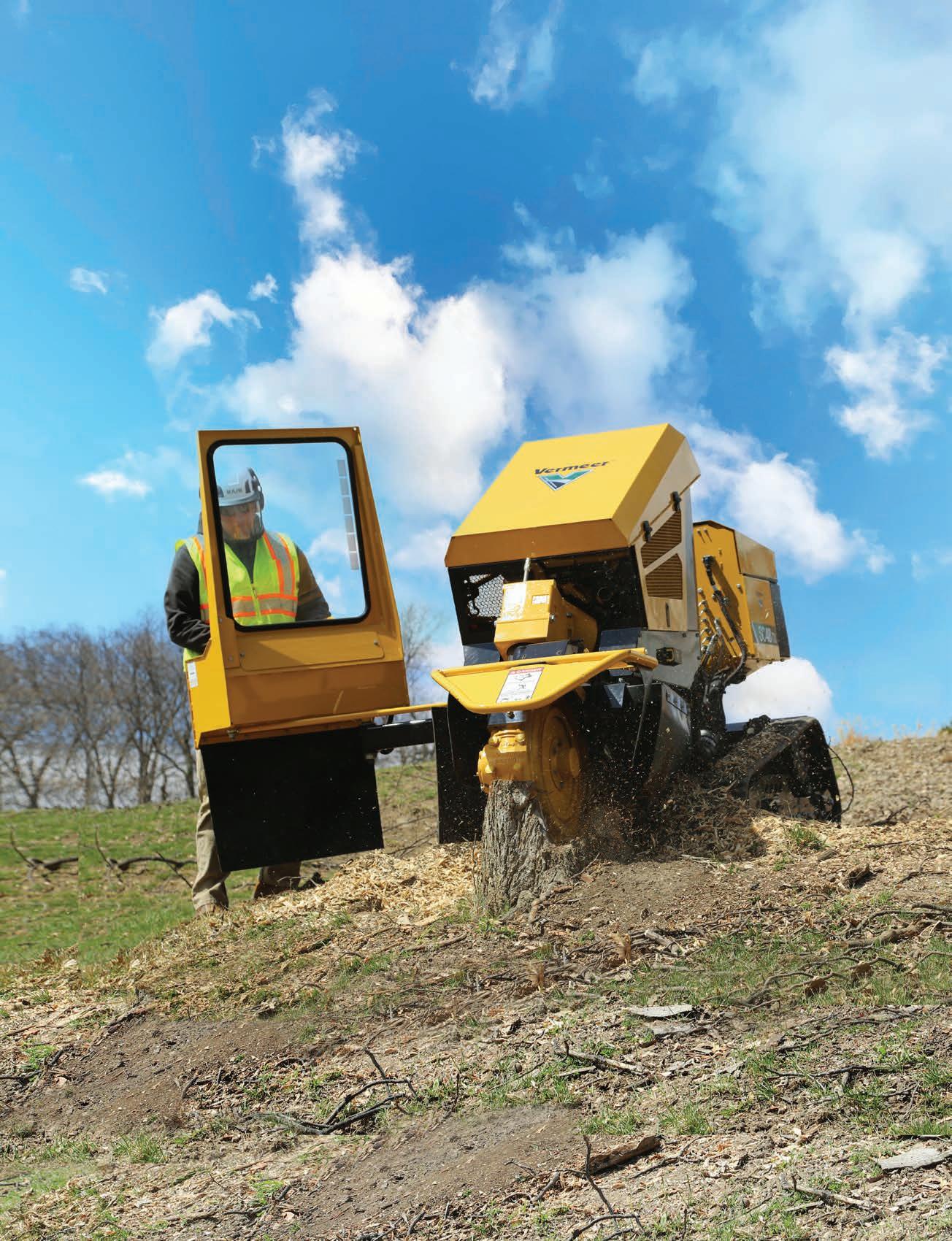






We’re ready for the future, because we always have been




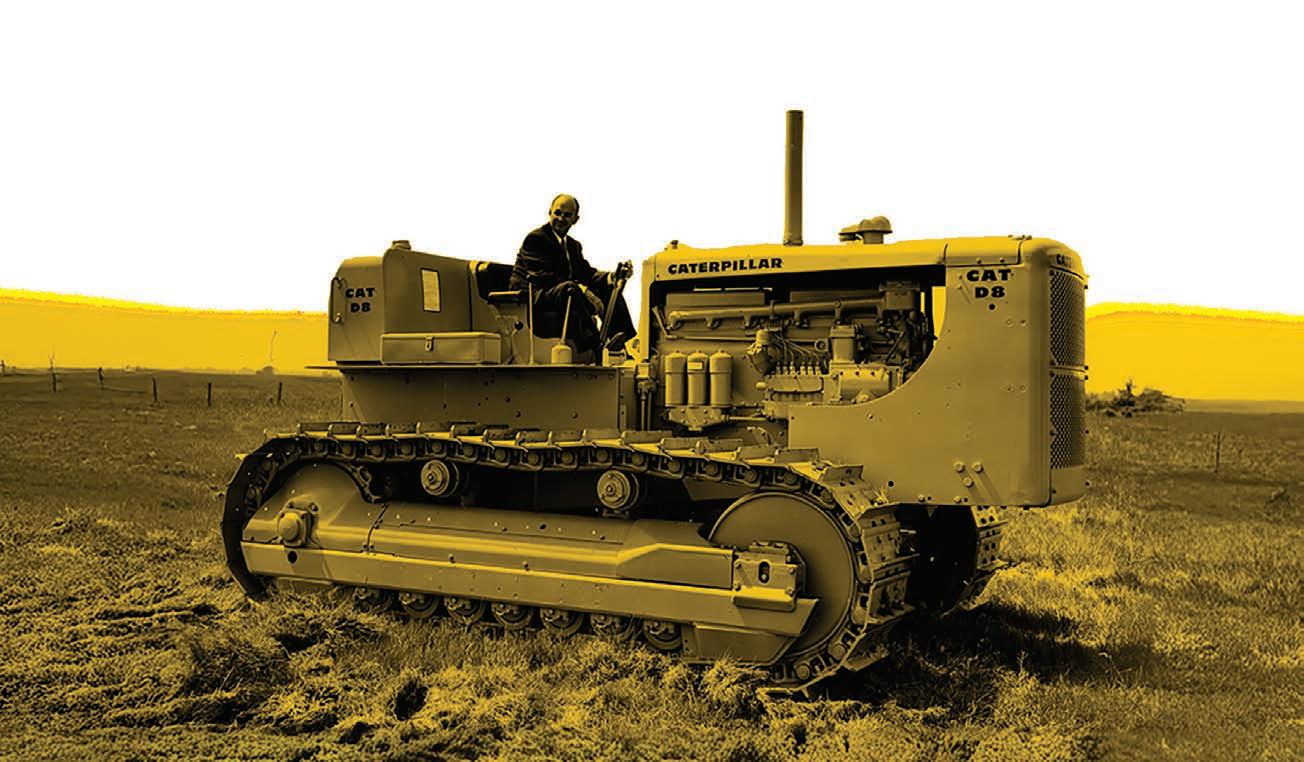


That camphor laurel (Cinnamomum camphora) may have been there for over 50 years, but that doesn’t mean it’s guaranteed to be stable after a flooding episode.
Image: TF

It’s been a tough couple of weeks.
As I’m writing this the floodwater is receding from the northern NSW rural valley which is my home. The sun is shining for the first time in what seems like ages, and people who’ve never experienced flooding would probably think everything is looking good again. So it is.
I love showing people where I live and watching their looks of disbelief. It’s very much an idyllic location. The river’s at my front door, I’m surrounded by lush pasture, and I never for a moment take for granted how lucky I am to be here. But the valley is a flood zone, and every now and then, as has just happened with Cyclone Alfred, things get a little unmanageable. The river which makes such a heartwarming view from my office window is a little less endearing when it finds its way into the house. That’s all as may be. I know that possibility is real, and over the past few decades I’ve learned to look out
for particular warning signs and to be prepared when I see them. The Bureau Of Met and the fabulous people at the SES do their best to see we’re kept informed, and these days it’s hard to understand how anyone can be caught unawares.
But another lesson I’ve learned over several flooding episodes is that the water receding and the sun shining isn’t a signal to relax.
I’ve no doubt arborists and emergency workers will have their hands full for quite some time tidying up after the cyclone. There are trees down and debris piled up everywhere.
But the circumstance I never see written about or publicised is the effect flooding has on the ground, and especially on a tree’s potential for being unable to support itself once the soil and surrounds have been saturated, softened, and sometimes removed by fast-moving torrents of floodwater. That favourite tree which has been in the backyard for generations could actually be a serious
threat to people and structures, even though it looks the same as it has done for decades.

Arborists need to be looking carefully at trees in those situations – and I’m sure they are – but home owners and members of the public need to be watchful as well. If there’s the slightest doubt, if a tree’s leaning a little, or even if it’s looking a little one-sided with foliage stripped from one side in the incredible winds, get a qualified arborist to do an assessment.
It’ll be the best investment you’ll make this year.
To all the emergency services, tree workers, arborists and volunteers who near burst their hearts (yet again) trying to help those caught up in the furore of Cyclone Alfred, a heartfelt and very sincere thank you.
Tom Foster Editor


HUSQVARNA X-COM ACTIVE
Experience X-COM Active, a robust, high-tech communication and hearing protection headset system designed for arborists and tree care professionals –making teamwork smoother and more efficient.
• Crystal Clear sound
• Advanced noise reduction
• Excellent hearing protection
• Up to 10 team mates across 3 channels FIND OUT MORE
The Australian Arbor Age is published bimonthly by Prime Creative Media Pty Ltd.
CEO
John Murphy
COO
Christine Clancy
Head of Sales
Andrew Morrison
Editor
Tom Foster
tom.foster@primecreative.com.au
National Advertising Manager
Alex Cowdery
alex.cowdery@primecreative.com.au
Phone: 0422 657 148
Client Success Manager
Arianna Lucini
arianna.lucini@primecreative.com.au
Design
Jacqueline Buckmaster, Danielle Harris
Subscriptions
P. +61 3 9690 8766
subscriptions@primecreative.com.au
Website arborage.com.au
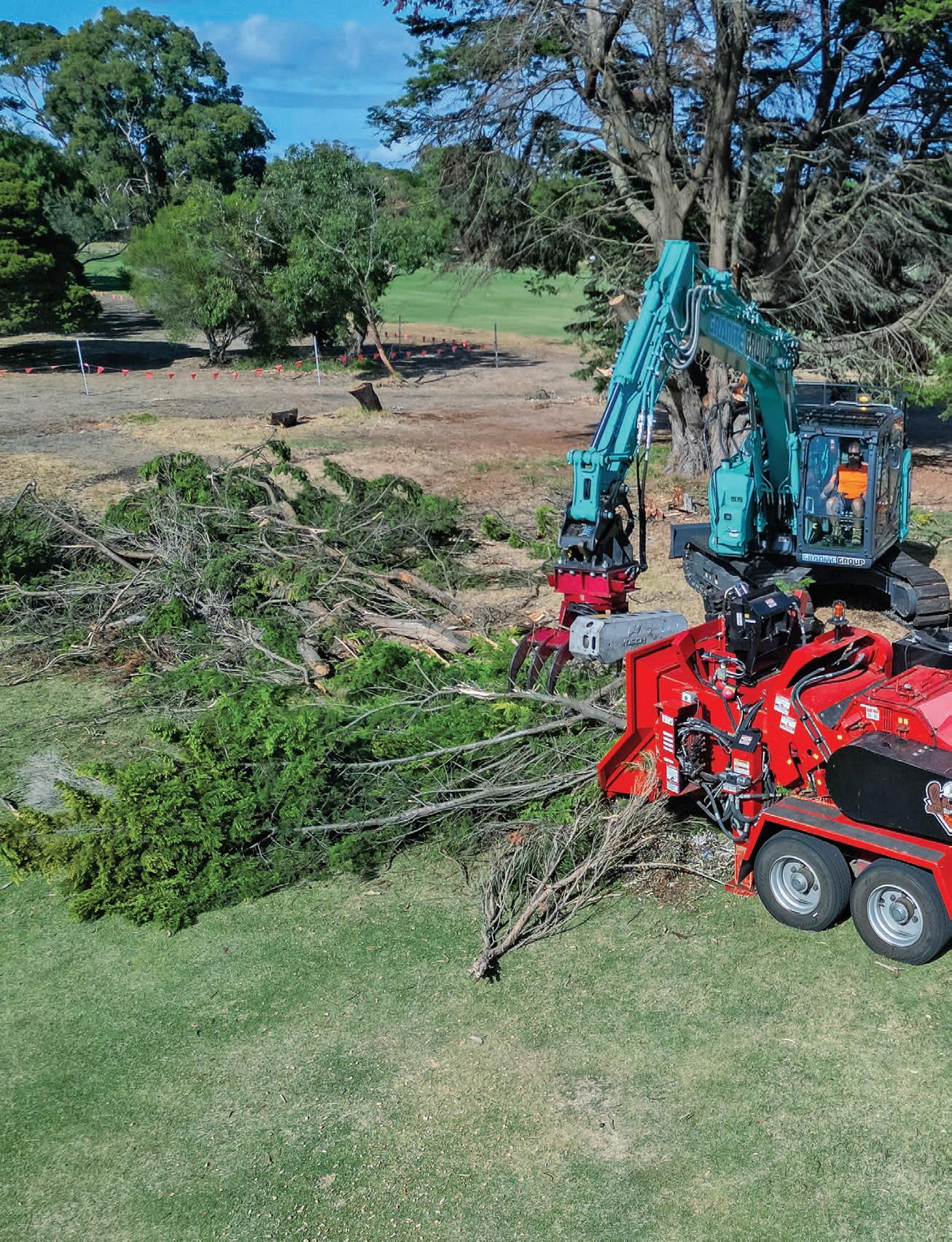
Copyright
The Australian Arbor Age magazine is owned by Prime Creative Media and published by John Murphy. All material in The Australian Arbor Age magazine is copyright and no part may be reproduced or copied in any form or by any means (graphic, electronic or mechanical, including information and retrieval systems) without written permission of the publisher.
The editor welcomes contributions but reserves the right to accept or reject any material. While every effort has been made to ensure the accuracy of information, Prime Creative Media will not accept responsibility for errors or omissions, or for any consequences arising from reliance on information published.
The opinions expressed in The Australian Arbor Age magazine are not necessarily the opinions of, or endorsed by, the publisher unless otherwise stated.
© Copyright Prime Creative Media, 2025
Articles
All articles submitted for publication become the property of the publisher. The editor reserves the right to adjust any article to conform with the magazine format.
Head Office
379 Docklands Dr, Docklands VIC 3008
P: +61 3 9690 8766 enquiries@primecreative.com.au www.primecreative.com.au
Sydney Office Suite 11.01, 201 Miller Street North Sydney, NSW. 2060. Australia
Victorian emergency tree-removal company Granite Group recently upgraded its chipper to a Morbark 2230. It was a happy decision before the chipper even arrived
– Page 22. Image: Prime Creative Media

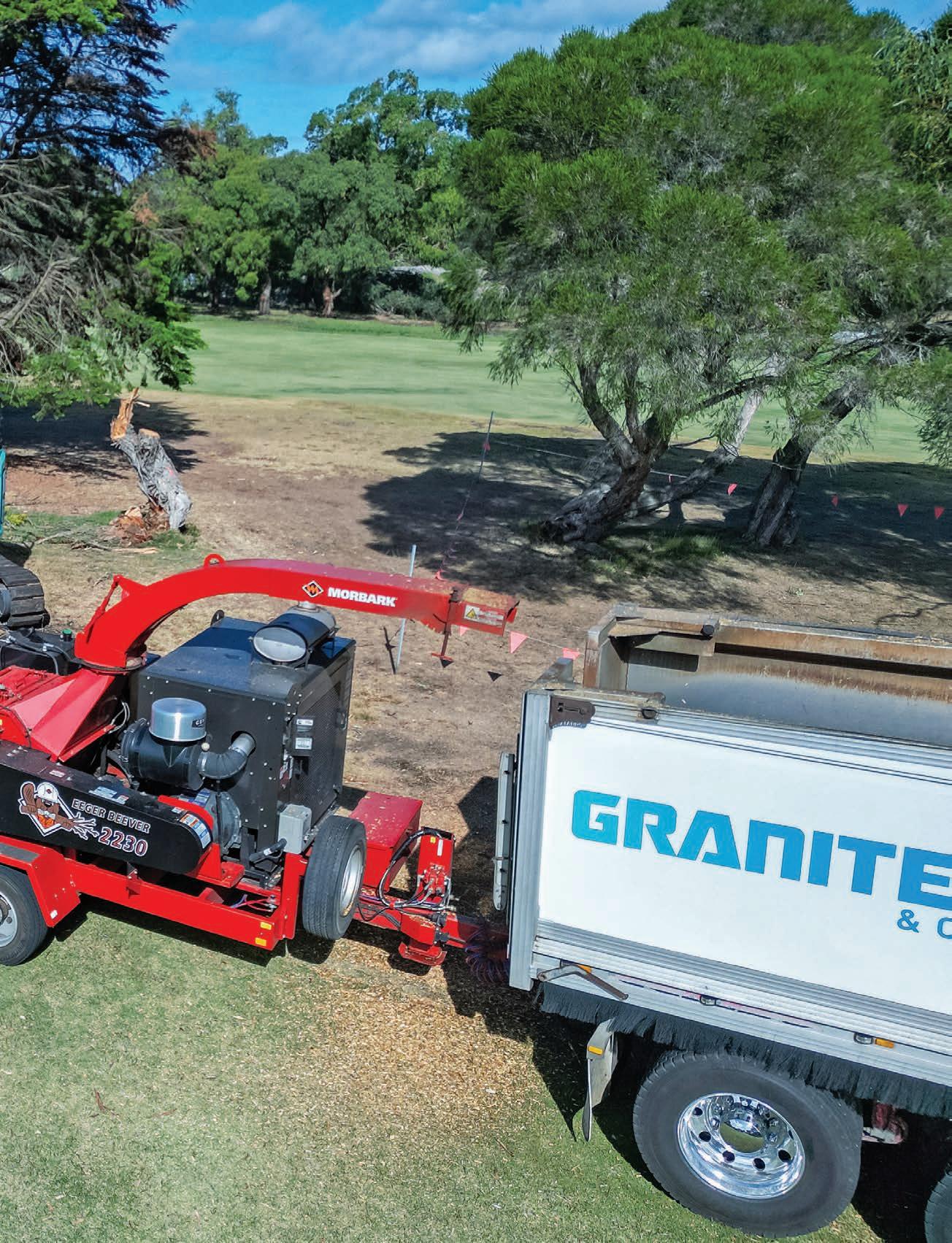
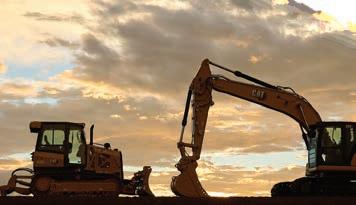





Whether or not California’s Pinus longaeva – understandably named ‘Methuselah’ by an adoring public – is the world’s most ancient tree is the source of some friction among academics. One lot claimed in 1957 the Great Basin bristlecone pine was 4789 years old at that time. That would’ve meant it germinated in 2833BC.
But a later attempt to verify Methuselah’s age went awry when it was found a vital core sample was missing, and in the absence of the sample the new estimate was a mere 4667 years old.
Either way, it’s a magnificent specimen which graces the arid landscape of Inyo National Forest in California at an altitude of around 3000m.
The tree’s longevity is credited to harsh weather and a lack of nutrients which slow down the decaying process.
There’s no evidence to support the assertion Methuselah may have held a treehouse in which Keith Richards and Willy Nelson rehearsed as teenagers.

Methuselah is recognised as the non-clonal tree with the greatest confirmed age in the world.
Image: zorpink/stock.adobe.com















Working Height: 14.7m + Working Outreach: 7.55m + Safe Working Load: 225kg + Minimum Weight: 1775kg
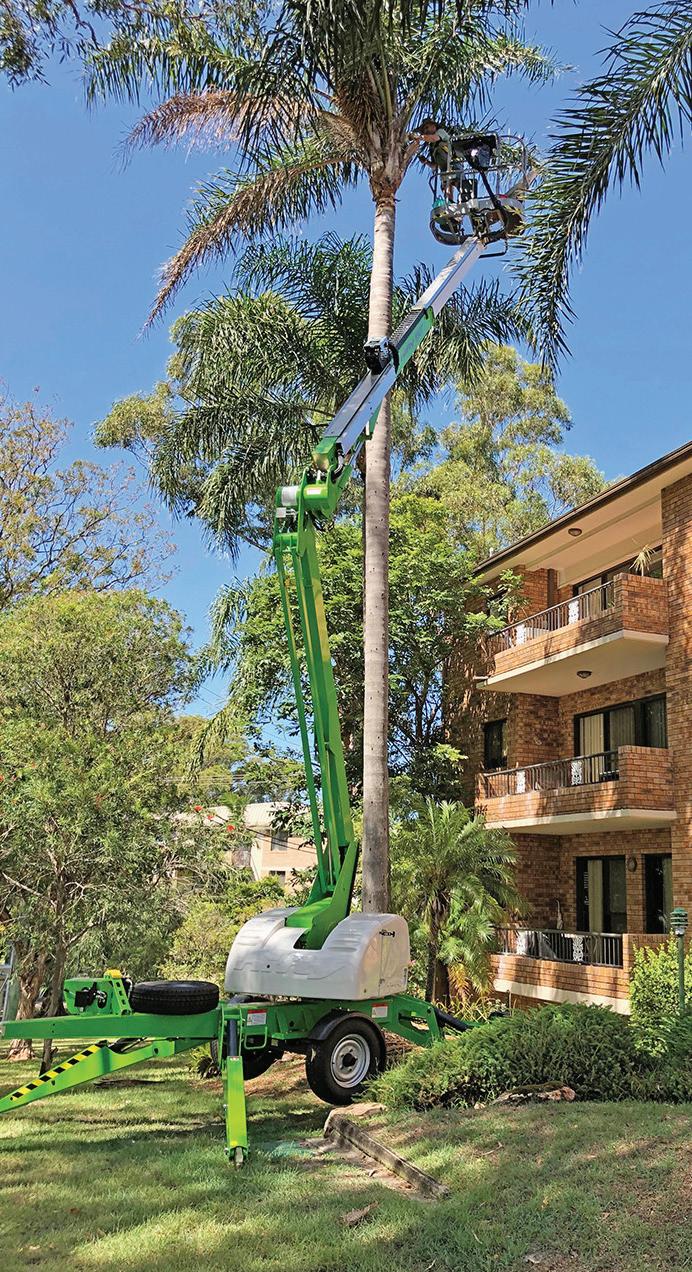


Telescopic Upper Boom
Accurate Platform Positioning
Bi-Energy Available
Optimising Utilisation
Hydraulic Outriggers
For Quick & Easy Setup
Fully Proportional Hydraulic Controls
Simple, Reliable & Easy To Maintain
Traction Drive Option
Excellent Manoeuvrability On Site
Designed & Built In UK
Local Support Team In All Areas
TO FIND OUT MORE CONTACT OUR TEAM
Call: 1300 4 NIFTY or 02 4964 9765
Email: sales@niftylift.com.au


Caterpillar Inc. is pleased to debut the Cat® FM528 GF/ LL (General Forestry/Log Loader), a forestry excavator designed for adaptability and efficiency.
Equipped with the side-entry Next Generation Certified Forestry cab, the Cat® FM528 GF/LL Forest Machine is Caterpillar’s first forest machine to offer a fixed or live heel and blade option. Its multi-configuration capabilities fill in fleet-equipment gaps and mean the machine can go to work in the woods or the millyard to help boost productivity and profitability.
Built with the Cat C4.4 173hp (129kW) engine and electrohydraulic system, the high-torque motor provides high power at low RPM while helping reduce fuel consumption and minimising downtime and maintenance costs.
“The Cat FM528 represents our commitment to understanding and
The Cat FM528 is equipped to tackle a variety of tasks with ease. Images: Caterpillar
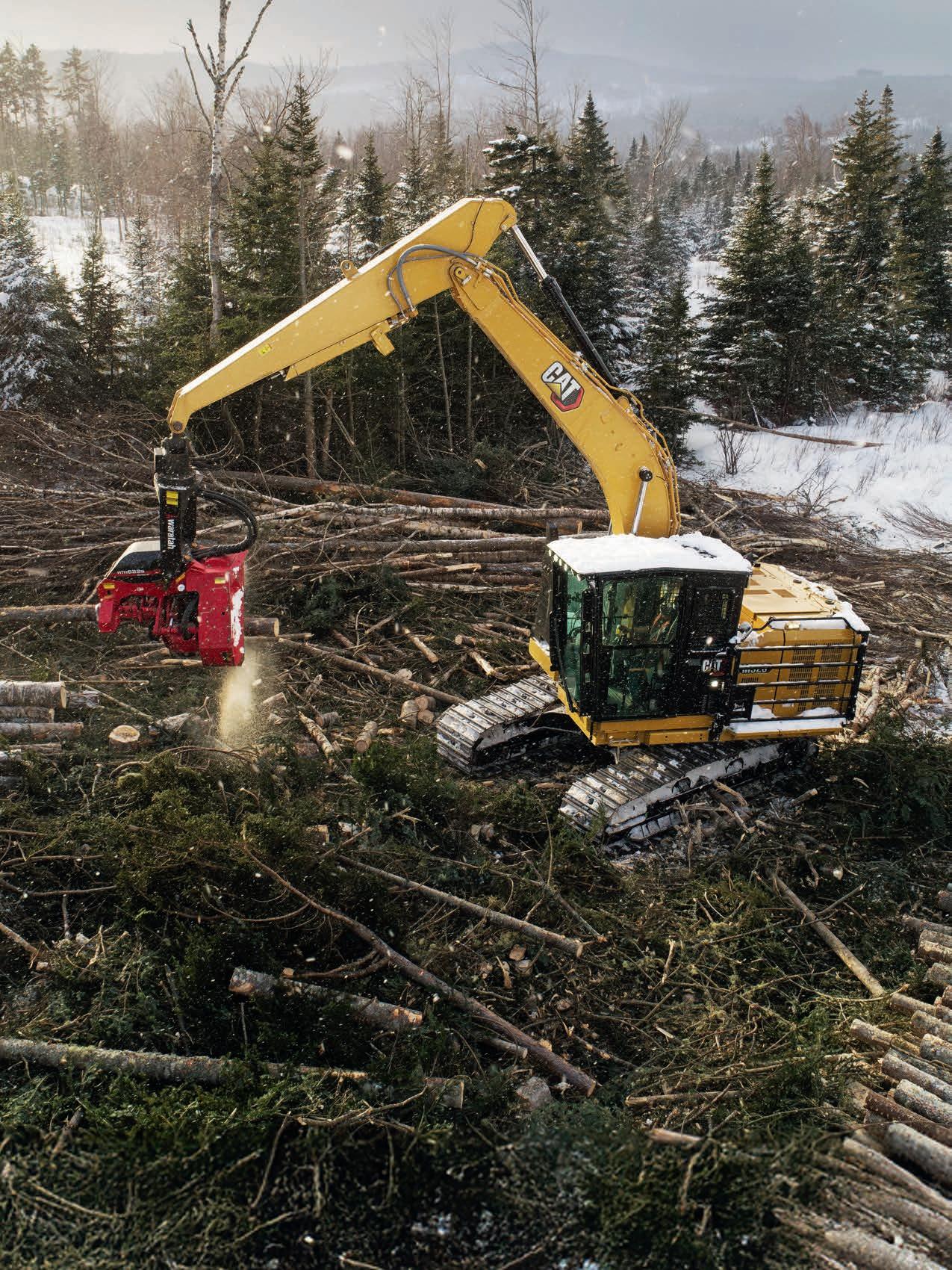
responding to the evolving needs of the forestry industry,” said Mike Dickenson, Caterpillar’s senior product specialist for forest machines. “We are merging adaptability, operator-oriented design, and cost efficiency, empowering forestry professionals to maximise their productivity while prioritising safety.”
Whether it’s land clearing, fire clean-up, chipping, grinder loading, mulching, or processing, the Cat FM528 is equipped to tackle a variety of tasks with ease. The machine is compatible with a wide range of robust Cat forestry grapples, available in sizes from 1322mm (52") to 152mm (60").
Equipped with Triple Grouser track shoes that help provide high manoeuvrability while minimising disturbance in soft, wet-underfoot conditions, the machine also helps keep operators safe with a certified side-entry Forestry ROPS cab which includes a spacious door and an easy-to-use tilt-up armrest.
Refined visibility is integrated into the design with a large 1.25" (32mm) thick polycarbonate windshield, narrow cab pillars, large panoramic windows, and a flat engine hood, helping operators maximise engagement with their work environment.
The Cat FM528 offers a unique fixed or live heel and blade configuration, allowing operators to easily adapt to various applications like navigating steep terrain, managing heavy logs, or performing detailed sorting tasks.
With options for processor, roadbuilder, log loader, and knuckleboom loader controls, this multi-configurable machine helps crews easily transition between forestry and millyard work, increasing productivity and profitability.
Powered by the Cat C4.4 173hp (129kW) engine and an advanced
FM528 GF & FM528 LL specifications
Engine: Cat C4.4e TTA
Engine power: (ISO 14396): 129kW (173hp)
Emissions:
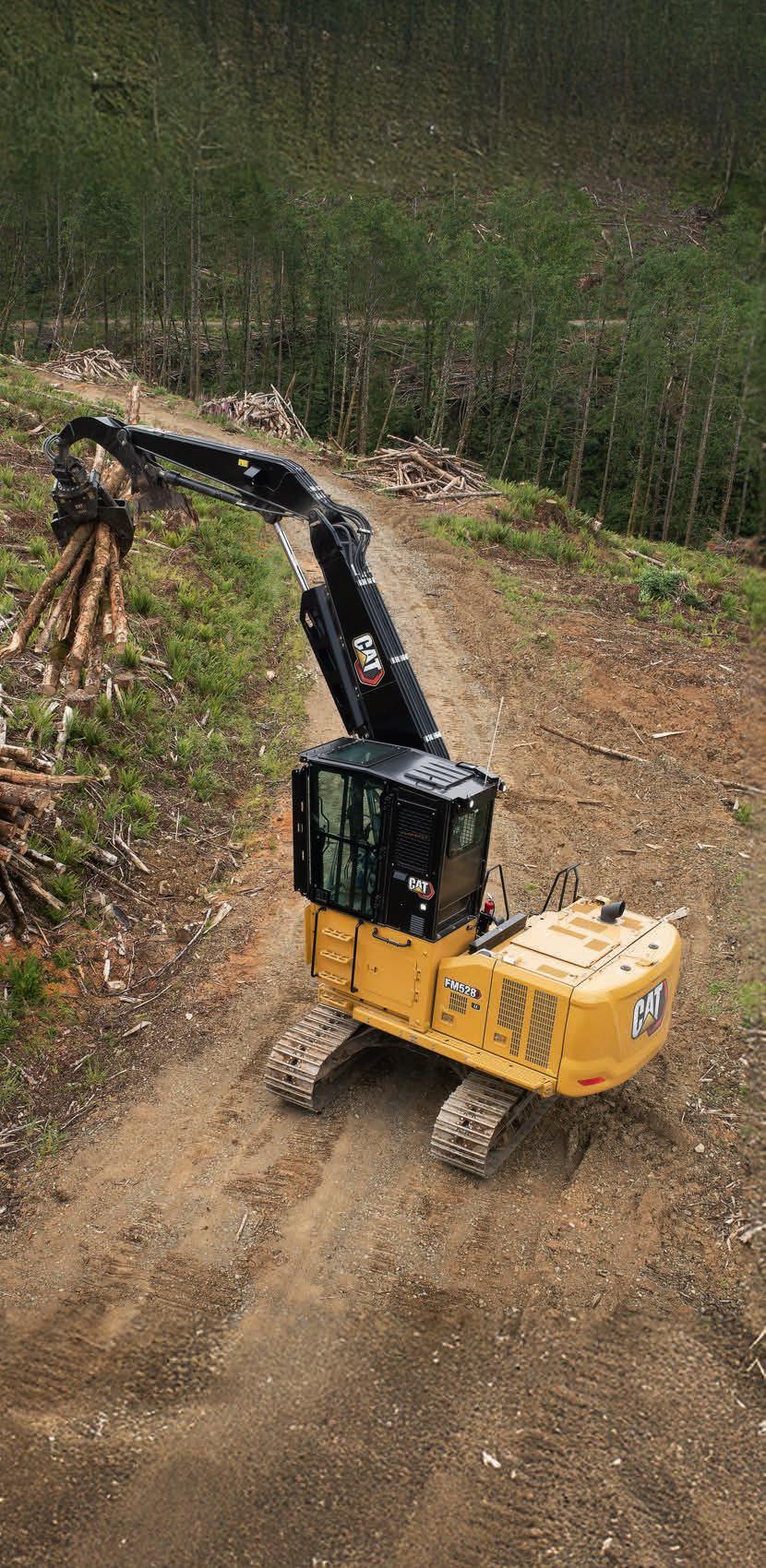
When you choose Cat products, services and solutions today, you’re gaining 100 years of experience and expertise “ ”

electrohydraulic system, the FM528 is designed to help lower fuel consumption while delivering superior performance. The hightorque engine operates effectively at low RPMs, minimising maintenance costs from wear and tear while maintaining precision in various job tasks. Further, the hydraulic system features cooling E-Fans with reversing capabilities to optimise engine efficiency and temperature control. Sharing common parts and
service with the Cat Next Generation excavator line, the FM528 ensures readily available components, significantly reducing downtime. Using Cat long-life fuel and hydraulic oil filters with extended and synchronised service intervals also helps lower maintenance expenses.
Over the past century Caterpillar has grown with its customers to help build a better, more sustainable world.
That’s why Caterpillar continues to support forestry customers with five models, including the FM528 GF and FM528 LL machines, plus a range of work tools that deliver dependability, versatility and efficiency to every fleet. When you choose Cat products, services and solutions today, you’re gaining 100 years of experience and expertise.
For more information about the FM528, contact a Cat dealer or visit cat.com.
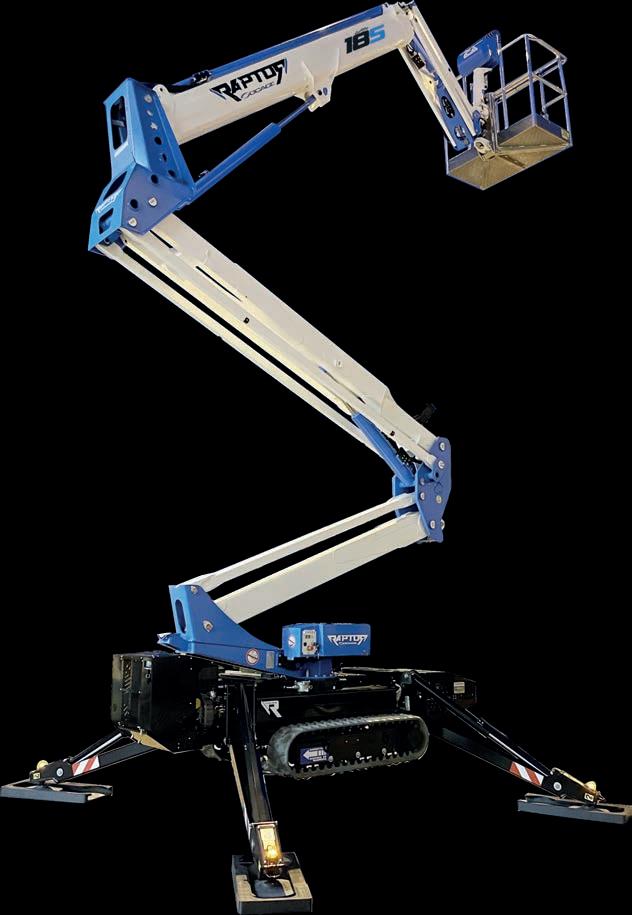


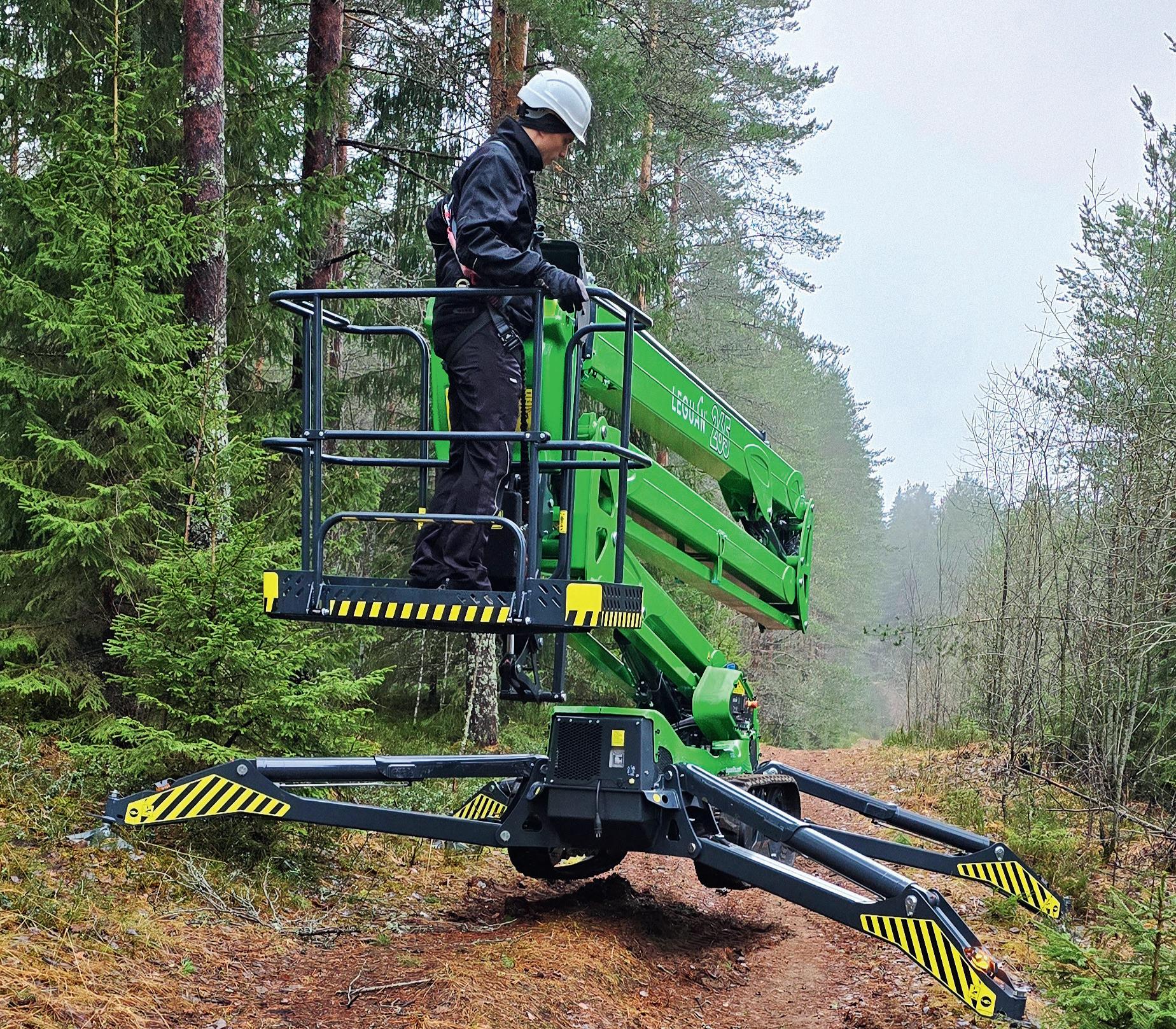
Versatile, efficient, and reliable lifting equipment for arborists and tree-care professionals.
The newest addition to the renowned Leguan line of all-terrain spider lifts offers exceptional performance, speed, and ease of use.
The Leguan 265 Spider Lift boasts a maximum working height of 26.5 metres, a side reach of up to 13.6 metres, and a lift capacity of 250kg, making it one of the most powerful and capable lifts in its class. Whether working on a towering eucalyptus or clearing high branches, the Leguan 265 offers unparalleled access for tasks requiring vertical and horizontal reach.
Designed with the unique needs of tree-care professionals in mind, the Leguan 265 excels in rough terrain. Its rugged track system provides exceptional ground clearance and gradeability of up to 45%, ensuring it
can reach places other lifts can’t. A low centre of gravity and powerful diesel engine ensure stability and reliability, even on challenging job sites, and for operations in remote or tough-to-access locations, the Leguan 265 is the tool for the job.
Time is money, and the Leguan 265 doesn’t waste either. As the fastest 27-metre spider lift in the world, the Leguan 265 features a rapid setup time of just one minute and 35 seconds to fully extend the booms to maximum working height. This exceptional speed enables tree-care professionals to complete jobs more quickly, increasing productivity and profitability across the board. With its intuitive joystick controls, the
Leguan 265 is incredibly user-friendly, allowing operators to focus on their work rather than navigating complex equipment. The machine’s automatic levelling and precise proportionaloutreach monitoring ensure a safe and efficient work process, minimising human error and maximising safety.
The Leguan 265 is engineered to perform in all seasons, with features that make it ideal for tree-care professionals working year-round, regardless of the weather. The platform’s shielded booms and chassis protect vital components from sawdust, water, and other debris, ensuring reliable performance even in wet conditions. Its robust construction, combined with excellent paint quality
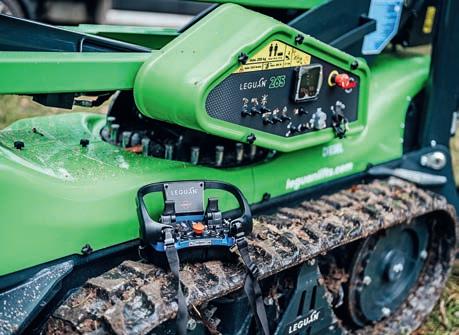
and corrosion resistance, ensures longevity and maintains the machine’s high resale value.
Why choose the Leguan 265?
Features include:
• Exceptional stability, ground clearance, and gradeability for rough and uneven terrains
• User-friendly intuitive joystick controls and automated functions for easy operation, with minimal training required
• Quick setup and operation speeds
• Durability, and being ideal for yearround use, even in harsh conditions, and
• Proportional-outreach monitoring and automatic safety features to prevent errors.
With its cutting-edge features, impressive performance, and exceptional ease of use, the Leguan 265 Spider Lift is set to become the go-to lift for Australia’s arbor and tree-care sectors. Whether tackling difficult terrain or reaching impressive heights, the Leguan 265 offers everything needed to complete tree work safely and efficiently.
As the official Australian distributor of Leguan Spider Lifts, Monitor is pleased to offer the Leguan 265.
With a commitment to providing topquality products and excellent customer service, Monitor ensures an investment in Leguan equipment is supported by expert advice and after-sales care.
If you’re ready to take tree-care operations to the next level with the Leguan 265 Spider Lift, contact Monitor for more information on pricing, features, and availability. Call 1800 025 024 or visit monitor.net.au.
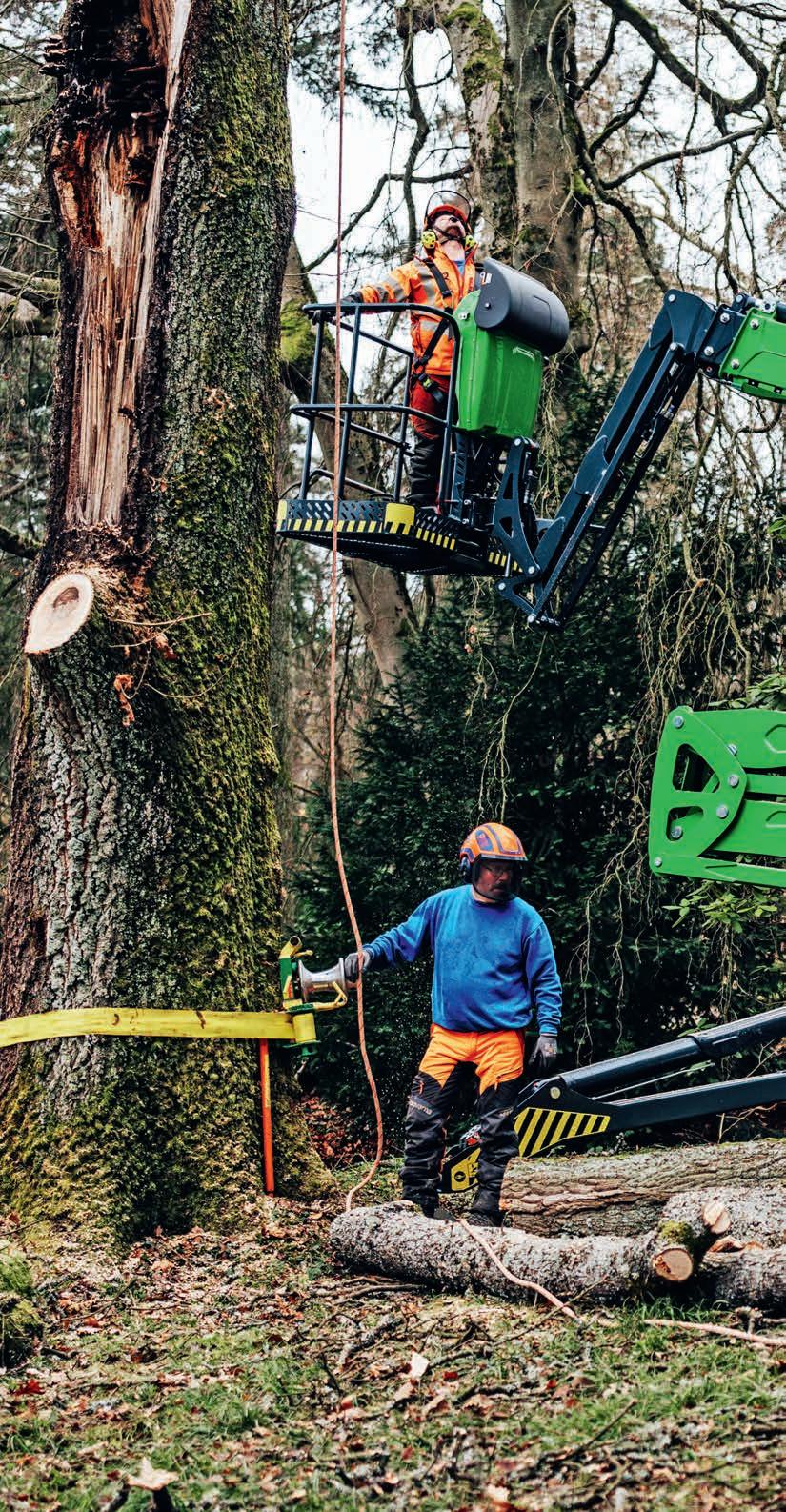

Niftylift’s Self Drive and TrackDrive MEWPs provide an ideal solution for arborists looking to work smarter, safer, and faster. Image: Niftylift
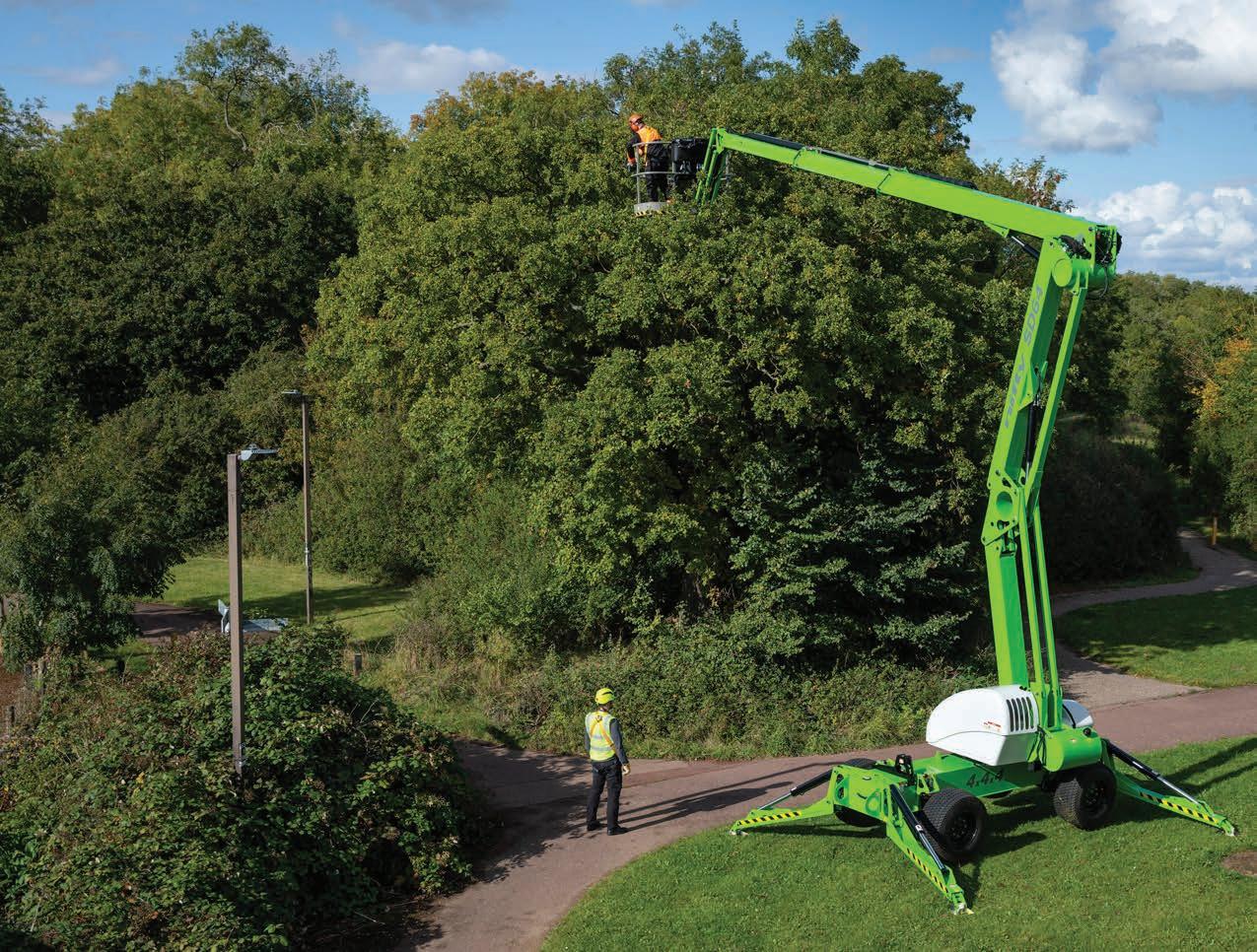
Why Australian arborists are turning to mobile elevating work platforms (MEWPs) for tree pruning and clearing.
Tree work in Australia is uniquely challenging. Whether maintaining urban landscapes, large estates, or managing trees in rugged bushland, arborists need equipment that is safe, efficient, and built to handle Australia’s terrain and climate.
For years, traditional rope climbing has been a primary method for accessing tree canopies. However, safety regulations and industry best practices now strongly encourage the use of MEWPs wherever possible to reduce fall risks, operator fatigue, and inefficiencies.
Niftylift’s Self Drive and TrackDrive MEWPs provide an ideal solution for arborists looking to work smarter, safer, and faster. Designed for Australian conditions, these machines help treecare professionals reach difficult areas, reduce strain, and substantially improve overall site safety.
Working at height is one of the biggest risks arborists face. While tree climbing remains a necessary skill, using an MEWP reduces the time spent in harnesses, minimising fatigue and the risk of falls.
MEWPs also provide a stable platform for arborists to work from, ensuring better balance and controlled movements. Niftylift’s Self Drive and TrackDrive models feature secure outriggers, proportional controls, and safety interlocks, helping operators work with confidence.
Also, MEWP rescue operations are quicker and safer compared to aerial rescues using ropes, and Australian arborists often work in extreme temperatures. Prolonged exposure can lead to heat stress, dehydration, and loss of focus. MEWPs reduce climbing effort, allowing arborists to focus on
precision cutting and pruning rather than exhausting rope work. Less physical exertion means operators can work longer and complete jobs faster without the need for extended rest periods.
The diverse Australian landscape requires machines suited for different ground conditions. Soft grass, steep slopes, and uneven terrain all demand specialist access solutions.
Niftylift Self Drive MEWP key models for estates, parks and urban tree care include the SD170 and SD210 4x4x4. The SD210 4x4x4 offers features like turf tyres to protect grass on golf courses, parks, and residential properties, and four-wheel steering which enhances manoeuvrability, allowing operators to access trees in tight spaces.
Four-wheel drive also ensures reliable access, even on irregular ground.
For slopes and soft ground Niftylift’s TrackDrive MEWPs – like the TD120T, TD120TN, and TD150T – offer superior traction on steep slopes, making them ideal for rugged terrain and embankments. The tracks improve stability on soft or loose ground and are well suited to bushland and off-road applications.
The compact dimensions of the TD range also enable access to tight or confined areas.
Arborists working on high-volume commercial contracts or emergency storm clearances need to get jobs done quickly and safely. MEWPs significantly reduce setup time compared to rope climbing, and that means less downtime and faster job completion.
Less fatigue means higher productivity – operators can complete more pruning or removals per day – and using MEWPs reduces the likelihood of injuries, leading to fewer insurance claims and work disruptions.
Tree work in protected areas and residential zones often requires low emissions and minimal ground disturbance. Niftylift’s Self Drive and TrackDrive MEWPs are powered by efficient diesel engines that meet Euro Stage V (Tier 4 Final) emissions standards, ensuring compliance with modern environmental regulations.
The SD170 is available with battery or bi-energy power (battery and diesel), offering a quieter, loweremission alternative for sensitive environments, and low-weight designs help minimise ground impact, reducing the risk of damage to parks, golf courses, and landscaped areas.
With Australian arborists facing greater safety expectations, environmental considerations and pressure for efficiency, the shift towards MEWPs as a primary tree-access solution is inevitable.
Niftylift’s Self Drive and TrackDrive models provide the reach, terrain adaptability, and operator comfort needed for modern tree work. Whether working on a large estate, a city park, or a rugged bush property, Niftylift MEWPs offer a smarter, safer, and more efficient alternative to traditional tree-climbing methods.
For Australian arborists looking to improve efficiency and safety, Niftylift provides the ideal solution.
To learn more contact Niftylift Australia to discuss which MEWP suits your tree-work needs. Phone (02) 4964 9765, or log on to niftylift.com.au.
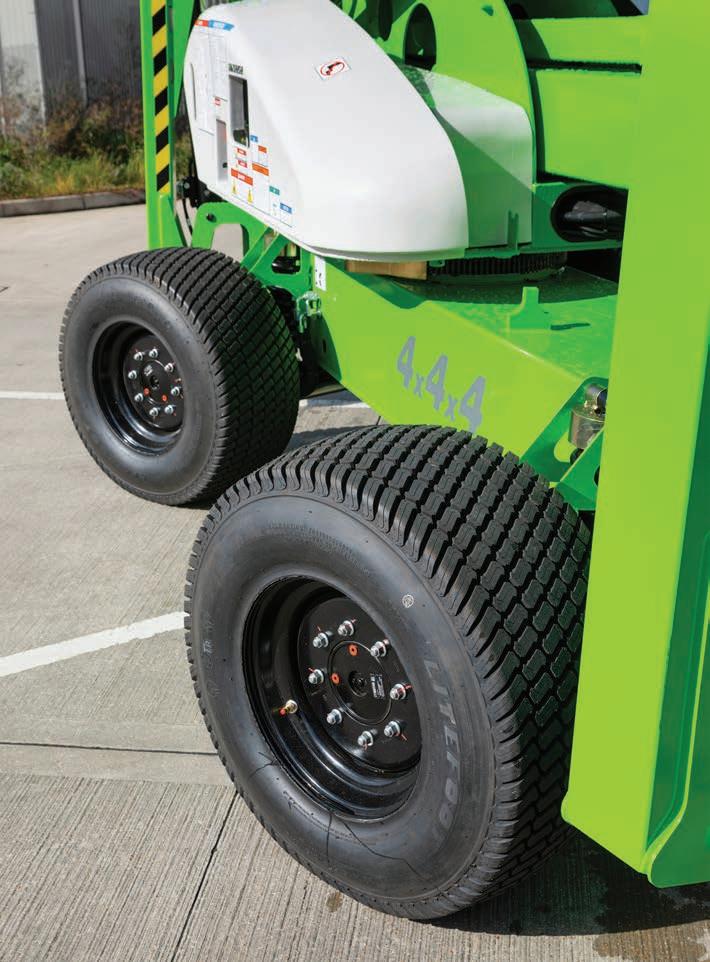
Keeping an Elevating Work Platform (EWP) in top condition isn’t just about operational efficiency. It’s also about keeping people safe. When it comes to health and safety, the trusted Brisbane Altequip team of servicing experts is on your side.
With multiple years of experience across all the major EWP brands, Altequip can be relied upon to keep equipment performing at its best. Personnel will be safer thanks to Altequip’s expertise, experience, and compliance with all Australian standards.
Altequip also understands the importance of streamlining the servicing process for owners and operators. There’s a completely paperless system whereby all service documentation is emailed directly to the customer. All EWP service and repair records are on file without the worry of keeping track of paperwork.
Altequip has a service reminder program in place which includes email
and SMS notifications when an EWP is due for a service. The equipment stays safe and compliant, without the hassle of manually tracking schedules.
Altequip has been operating in the EWP Brisbane and Queensland sector for over a decade. The company understands the nature of the industry, but most importantly, it understands the machines themselves. The qualified Altequip technicians have experience in maintaining and repairing equipment from the entire range of EWP manufacturers.
With regular maintenance and servicing, owners and operators can avoid costly breakdowns and ensure
maximum uptime throughout the year. If a problem does occur, Altequip technicians are skilled in diagnosing the issue and promptly applying a fix. Machinery is back up and running in the shortest possible time.
Having an EWP break down and put a stop to work for the day is a huge frustration.

While regular servicing helps minimise the chance of this happening, breakdowns do occur and they need to be handled in the best way possible. Altequip offers emergency repairs for EWPs, and aims to get them back up and running fast to minimise downtime. While assistance depends on the
owner’s schedule, Altequip will do its best to prioritise an emergency EWP repair.
Hire companies and owners of large fleets of elevating work platforms can take advantage of Altequip’s fleetservicing offering. Working around the owner’s schedule, Altequip technicians are able to do on-site servicing at a depot for multiple pieces of equipment. Keeping gear in top condition will ensure it can be hired out with confidence, avoiding conflict with customers and allowing for
seamless operations and relations.
The dedicated Altequip team promises innovative solutions and a strong commitment to customer satisfaction with every EWP service. Thanks to extensive knowledge and experience, and the latest industry technology, Altequip can keep elevating work platforms in peak condition. Minimal downtime and maximum productivity are the result.
To learn more of Altequip servicing and products, visit altequip.au/ewpservicing/.
A few key services from Altequip include:
• 90-day inspections – detect potential issues before they snowball
• Annual in-depth assessments –ensure optimum operations and full compliance with safety regulations
• Repairs and breakdowns – minimise downtime and get back in action as quickly as possible (subject to time and availability Ts and Cs).
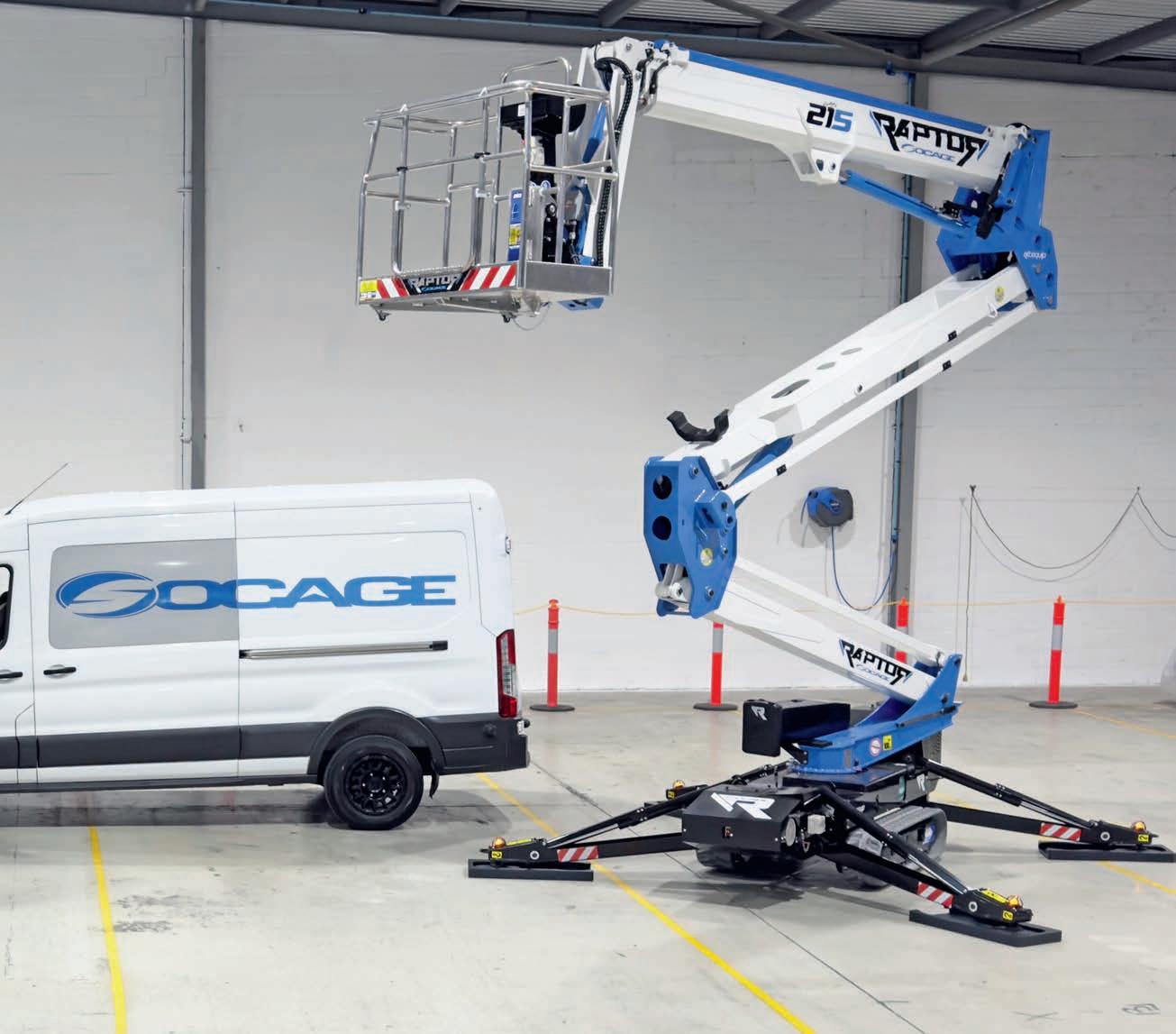
The Altequip team can work on everything from small scissor lifts to large truck-mounted travel towers.

Victorian emergency tree-removal company Granite Group recently upgraded its chipper to a Morbark 2230. It was a happy decision before the chipper even arrived.
Granite Group has three main strands to its business: Earth and construction; Tree works; and Environmental, and cites its aim as ‘to be a unified force in environmental solutions, construction expertise, and arboriculture…a one-stop destination for a wide array of services from ecofriendly environmental management to top-tier construction projects and comprehensive tree care.’
The Tree works section of the business deals with:
• Stump grinding
• Complete tree removal
• Large-scale chipping
• Tree reports, and
• Milling
The Australian Arbor Age caught up with Director Jon Rogash at the National Golf Club at Long Island in Frankston. Granite Earth was rehabilitating the course, doing the tree removal and land clearing for the new fairways. Thousands of cubic metres of material were being removed.
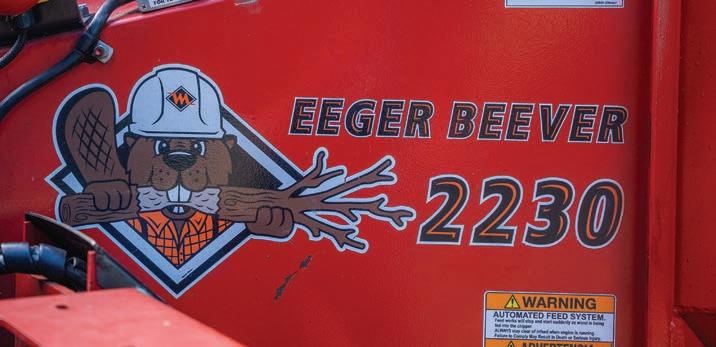
The machine chosen for processing the foliage was a recently purchased Morbark 2230 Wood Chipper, and as Rogash outlined to The Australian Arbor Age magazine, upgrading from the previous chipper hadn’t been a difficult decision.
The Morbark was being fed by a 15-tonne excavator with a rotating grapple saw, and from what we could
The Morbark breaks up large logwood with ease.
see, the 2230 was doing the job – quickly and efficiently.
“We upgraded from a smaller machine,” said Rogash. “When we looked at the Morbark 2230, it had 365 horsepower, and in my eyes it was just the straight out brute horsepower.
“It was no brainer.”


“I got talking to Monitor Business Development Manager Stuart Samson about this machine, and the more I inspected it, the more I liked it.
“I decided to pull the trigger on it.”
While it was the grunt of the Morbark which caught Jon’s watchful eye in the
first place, the safety offered by the remote control on the 2230 has been major bonus.
“We run a strict machine-feed only,” explained Jon. “It eliminates any risk of people being caught in foliage or things like that. We run it straight off the machine with the remote and nobody’s in harm’s way.”
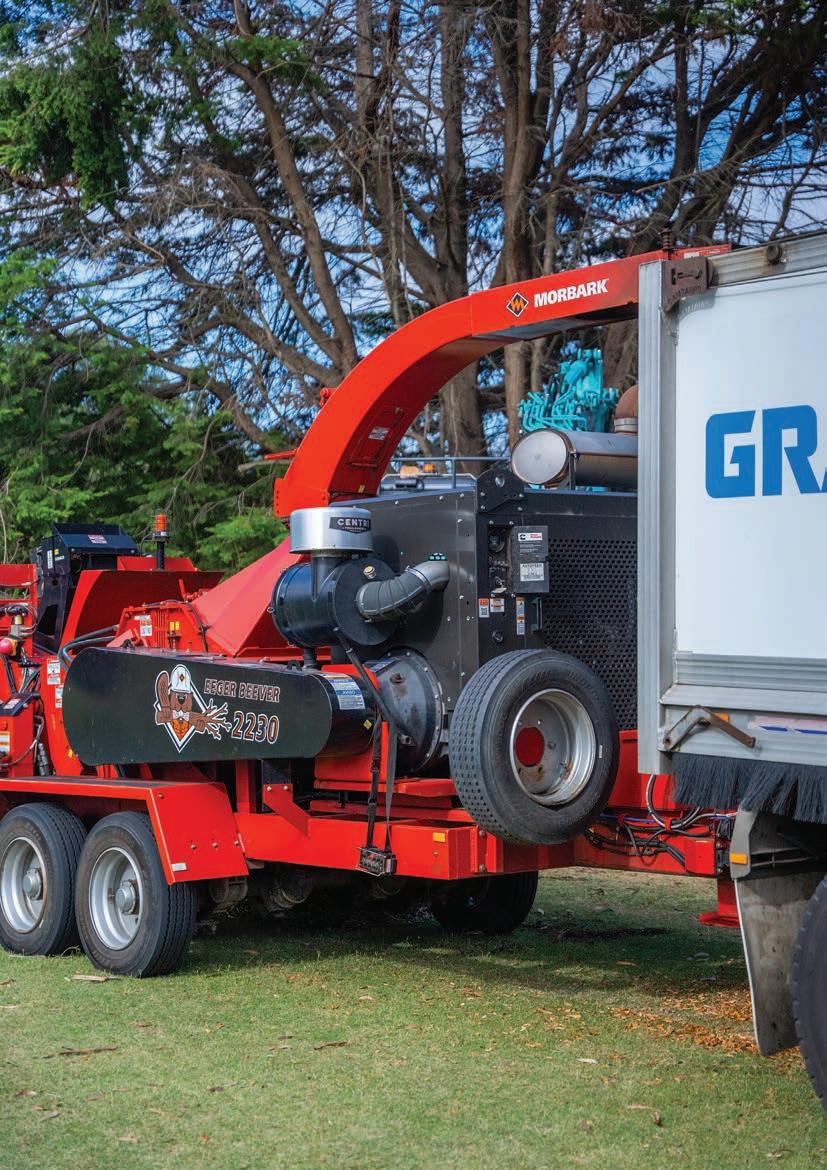
The angle on the chute eliminates blockage, and the higher drum speed forces the material through quicker “ ”
Matching the Morbark with Granite Earth’s other machinery has also shown some big productivity improvements.
“When we team up some of the other equipment with this machine, we can break down big logwood, and it doesn’t struggle pulling it through. It’s got the horsepower to pick up the drum speed,” explained Rogash. “Also, the angle on the chute eliminates blockage, and the higher drum speed forces the material through quicker.”
It was clear Jon had been giving the Morbark a thorough workout and knew his way around the 2230.
“The top infeed roller is a very aggressive style which grabs the foliage and logwood and forces it through without any drama, and without having to use the lift-and-crush.”
Jon’s satisfaction with the Morbark carried over to his high opinion of supplier, Monitor.
“It’s been really good,” he said. “Whenever there’s been an issue – which has been very rarely – it’s been fixed straight away, and parts are readily available for the Cummins engine throughout Australia.”
While Granite Earth is a firm fan of both Monitor and the Morbark 2230, and further business between the two companies is likely, there’s work to be done first.
“We’re not going to upsize our fleet for now,” said Jon thoughtfully, “but in two years we’ll look at upgrading to a newer model and it’s a no brainer: we’ll be staying with Morbark.”

When you choose the BVR Brush Chippers from Morbark, LLC, you’re not just investing in a machine — you’re investing in decades of innovation, quality, and craftsmanship. These chippers are designed to stand the test of time and make your toughest jobs easier and more profitable.
Don’t settle for less. Choose the chipping power of the BVR Brush Chippers and experience the difference that Morbark’s legendary performance can bring to your business.
Unlock Powerful Performance with the BVR Line of Wood Chippers from Morbark.

When you choose a BVR Wood Chippers, you’re not just investing in a machine — you’re investing in decades of innovation, quality, and craftsmanship. These chippers are designed to stand the test of time and make your toughest jobs easier and more profitable. Don’t settle for less. Choose the chipping power of BVR Wood Chippers and experience the difference that Morbark’s legendary performance can bring to your business. To find a Dealer in your neck of the woods, go to https://dealers.morbark.com.
Monitor Industries - Australia
Ph: +61 1800 025 024 www.monitor.net.au
Stevens Group - New Zealand
Ph: +64 09 275 0443
www.stevensgroup.co.nz
To learn more about the complete line of BVR Wood Chippers, scan the QR Code with your mobile camera

The SC48TX’s low ground pressure and narrow footprint gives access to difficult jobsites.
Images: Vermeer Australia
The Vermeer SC48TX is a compact, highly mobile machine designed to navigate tight spaces and efficiently remove stumps of all sizes.
The latest addition to Vermeer’s hard-working stump grinder lineup, the SC48TX, is compact in size to manoeuvre through tight jobsites, but its robust cutting capabilities mean it’s ready for even the toughest jobs.
For more information on Vermeer’s extensive line-up of professional tree-care and arbor equipment, visit vermeeraustralia.com.au.
Here’s a few highlights of the SC48TX…
The beltless directdrive system of the SC48TX ensures maximum power “ ”
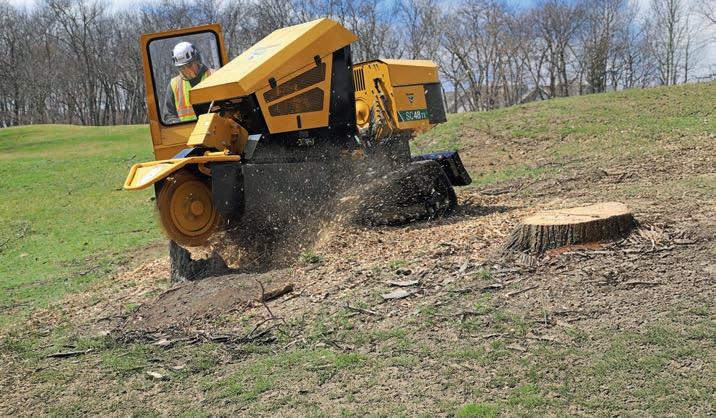
The beltless direct-drive system of the SC48TX ensures maximum power is delivered from the engine to the cutter wheel through a pair of gearboxes connected by a driveshaft. Maintenance costs are minimal thanks to the beltless design.
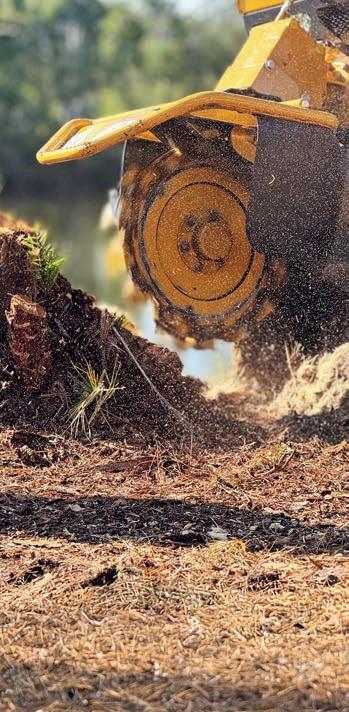
The SC48TX stump cutter was built to help efficiently grind stumps of all sizes. It has a 48hp (36kW) CAT diesel engine for optimum fuel economy, durability and performance, and is backed by proven worldwide service and support, including three-year coverage.
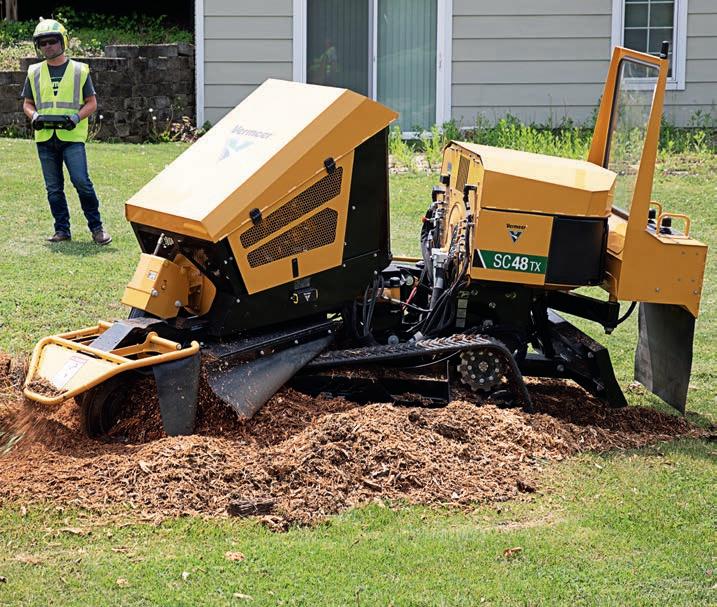
The optional full-function remote control allows operating the stump cutter without being at the operator’s station, giving jobsite flexibility.
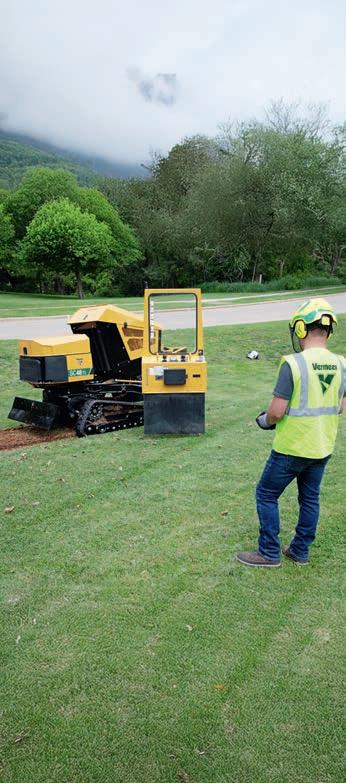
An optional backfill blade efficiently moves chips around the jobsite, reducing the need to manually relocate the chips. The blade has a rounded lower edge to minimise turf damage.

When jobsites or approaches are tight, The SC48TX can retract to only 35" (89cm), and then extend the tracks to 49" (124.5cm). The low-disturbance tracks provide optimum traction and stability in tough conditions – reducing job prep and leaving minimal clean up.

Exclusive stump-cutting technology maximises time at the stump – features like the Vermeer cutting system, SmartSweep™ control system, and the operator presence system.
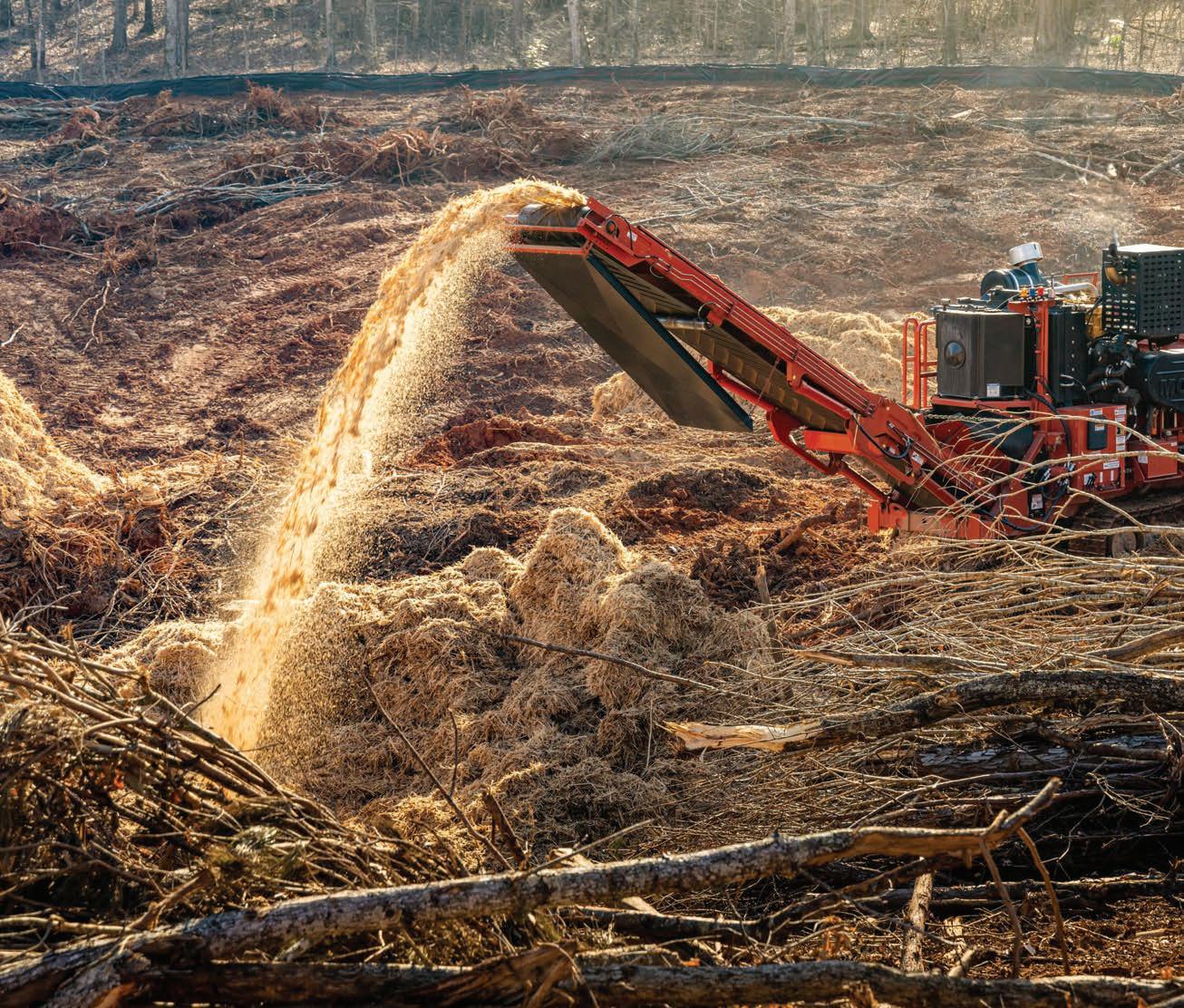
Morbark’s Whole Tree Chippers and Eeger Beever range stand out as ideal choices for Australia’s demanding environments.
Australia’s diverse landscapes present arborists with myriad challenges that demand robust, reliable equipment capable of handling rugged terrain and diverse vegetation. From the dense rainforests of Queensland to the arid outback of Western Australia, arborists require machinery that can adapt to varying conditions while ensuring efficient and safe operations.
One of the standout features of Morbark equipment is its adaptability to Australia’s varied terrain. Whether it’s tackling thick underbrush in the Northern Territory or processing timber in the forests of Tasmania, Morbark Eeger Beever brush chippers and whole-tree chippers excel in manoeuvrability and performance.
Harsh weather conditions, including extreme heat and occasional cyclones, are commonplace across Australia. Morbark equipment is engineered to withstand these challenges with durable construction and robust components. Designed for longevity and minimal downtime, Morbark machinery ensures arborists can maintain productivity even in adverse weather, crucial for meeting deadlines and client expectations in Australia’s competitive arboriculture industry. Chippers
Equipped with powerful engines and advanced hydraulic systems, these machines effortlessly handle the challenges of uneven ground and steep slopes, ensuring arborists can operate effectively in any environment.
Australia’s unique flora, including native eucalyptus trees and dense shrubbery, requires specialised equipment for effective vegetation management. Morbark horizontal and tub grinders and whole-tree drum and disc chippers are designed to efficiently process a wide range of materials, from large tree trunks to stumps to slash, converting them into valuable mulch or wood
chips. This capability not only aids in maintaining environmental balance, but also supports sustainable landmanagement practices essential for preserving Australia’s natural habitats.

Safety is paramount in arboriculture, and Morbark prioritises operator safety with ergonomic designs and intuitive controls. Features such as enhanced visibility, emergency shut-off systems and noise-reducing technology contribute to a safer working environment, reducing the risk of accidents and enhancing overall operational efficiency.
Supporting Australia’s arborists
Morbark brush chippers, horizontal and tub grinders and whole-tree chippers are not just tools, but indispensable partners for arborists and forestry professionals in Australia. Their ability to adapt to diverse terrain, efficiency in vegetation management, durability in
harsh conditions, and focus on safety and comfort make them the preferred choice for professionals across the continent.
As Australia’s landscapes continue to evolve, Morbark remains committed to supporting arborists and forestry professionals with innovative solutions that uphold performance, reliability, and sustainability in every operation.
Learn more about whole-tree chippers at morbark.com.au and Eeger Beever brush chippers at monitor.net.au.
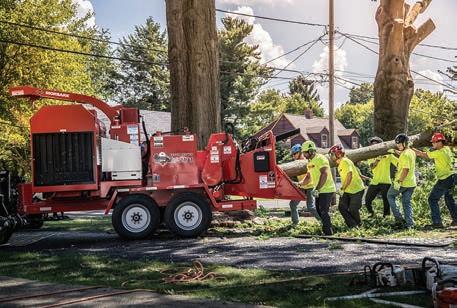


Hansa’s commitment to excellence.
In today’s demanding arboriculture landscape, professionals require tools that not only perform under extreme conditions but also reflect a commitment to environmental responsibility. The team at Hansa approach product design and manufacturing to ensure every piece of equipment excels in the field while being designed with sustainability in mind.
The Hansa journey begins behind the scenes, where innovation drives the development process through direct collaboration with arborists. Rather than relying solely on conventional production methods, the engineers and designers work closely with field experts to identify everyday challenges. This real-world feedback plays a crucial role in shaping Hansa’s design philosophy. Every ergonomic adjustment, safety enhancement, and operational improvement is tailored to meet the rigorous demands of modern arboriculture. This collaborative process ensures the equipment is truly built for arborists, delivering tangible benefits such as reduced downtime and increased efficiency on the job.
Simultaneously, Hansa redefines
sustainable manufacturing practices. With a state-of-the-art production facility incorporating energy-saving processes and waste-reduction measures that significantly lower its carbon footprint, Hansa continually explores innovative ways to minimise waste and optimise resource efficiency throughout daily operations. This commitment to sustainability benefits the environment and enhances the durability and reliability of the products, ensuring every machine produced by Hansa remains as robust as it is responsibly made.
The impact of these combined efforts is evident in the real-world performance of Hansa chippers. Whether it is advanced chippers or other robust equipment, each product results from a dual commitment to cutting-edge design and sustainable production. Arborists across Australia experience firsthand how these innovations improve productivity, reduce maintenance challenges, and create a safer, more reliable working environment. Ultimately, Hansa equipment stands as
Every ergonomic adjustment, safety enhancement, and operational improvement is tailored for modern
a testament to what is possible when industry expertise meets responsible innovation.
Looking ahead, Hansa remains dedicated to pushing the boundaries of what equipment can achieve. it continues to invest in research and development initiatives that enhance performance and improve sustainable practices. By doing so, the team at Hansa is confident the future of arboriculture will be defined by a balanced approach – one where groundbreaking technology and environmental stewardship work together to support the hardworking professionals who care for our trees. At Hansa, the commitment to innovation and sustainability is not just a promise – it’s a reality. It translates into equipment built for arborists, designed to perform under the most challenging conditions while protecting the planet for future generations.
To see more of Hansa’s equipment and commitment to sustainability, log on to hansaproducts.com/au/.
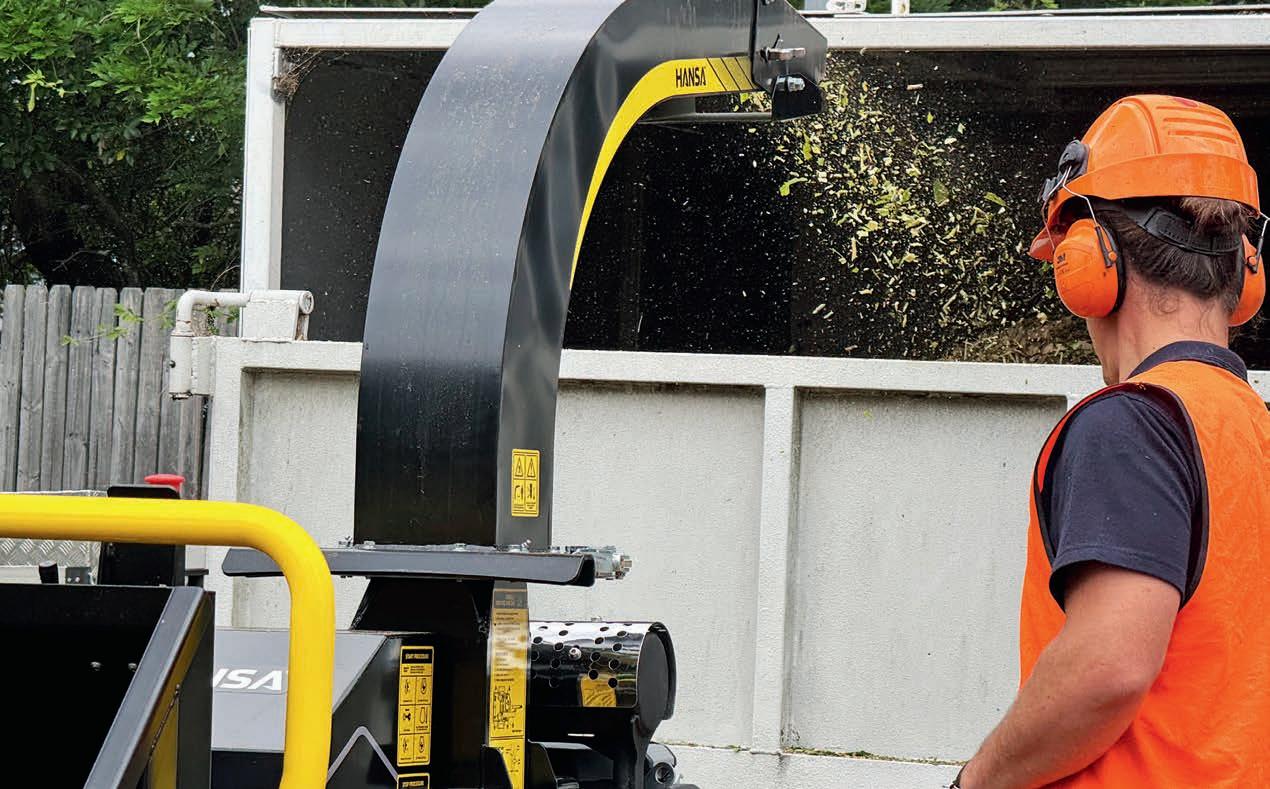
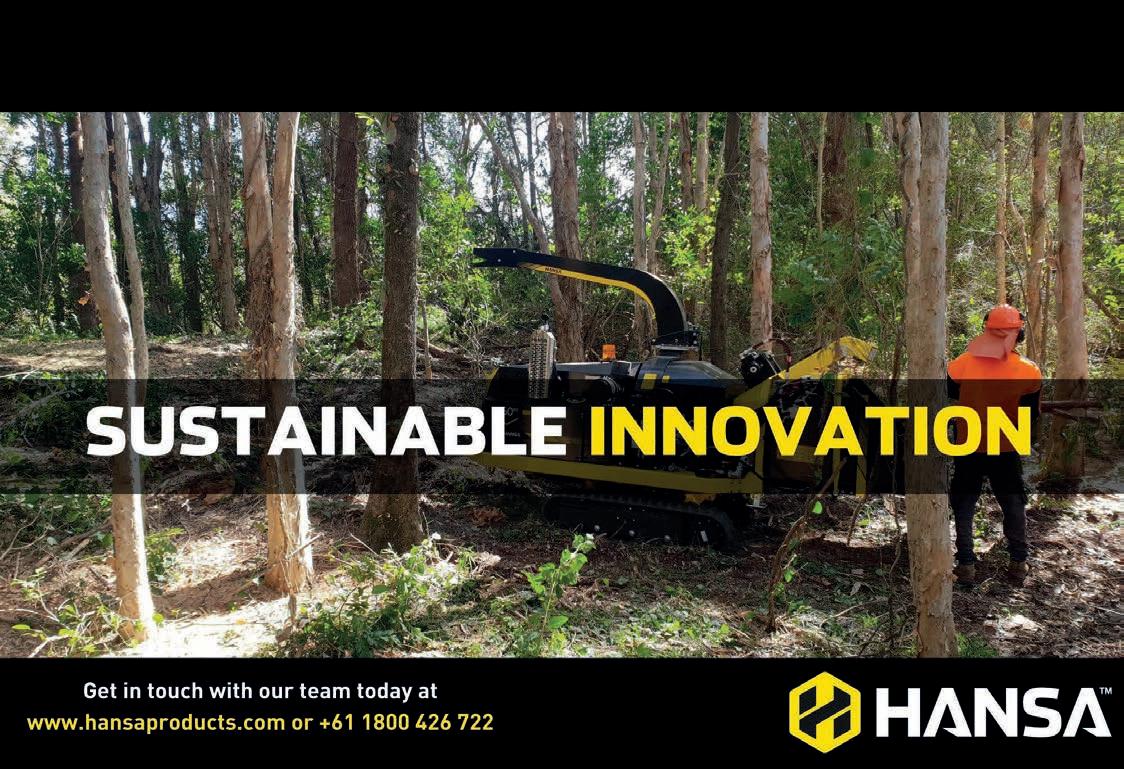
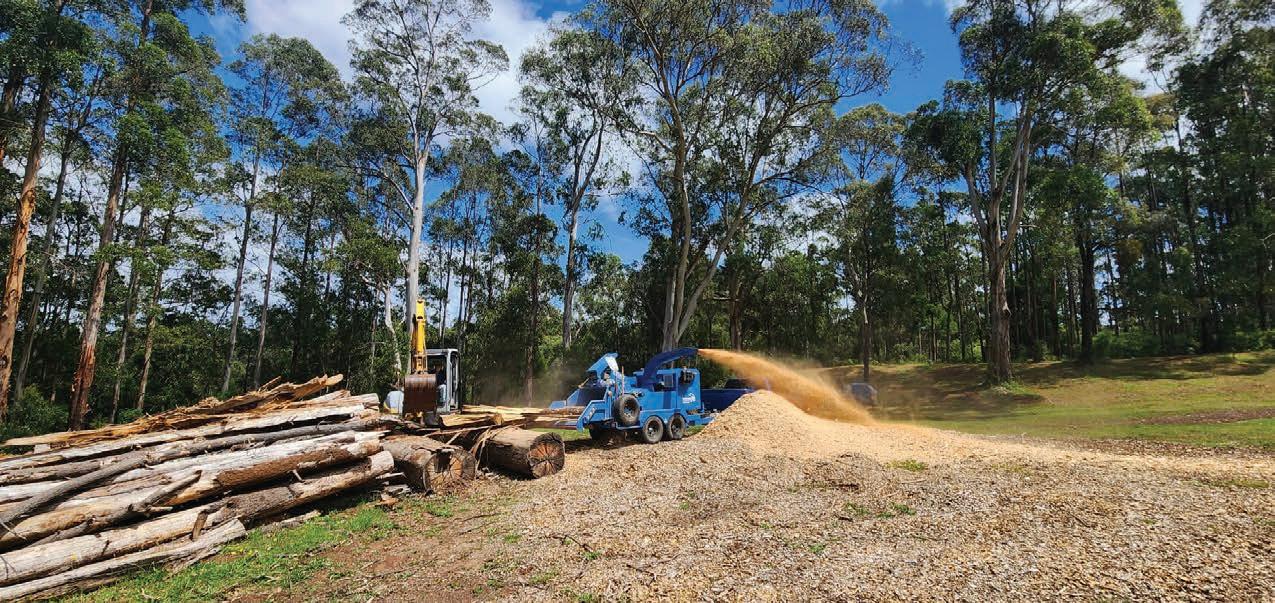
The Australian Arbor Age has written several times about the impressive build quality of Piranha Chippers. But even though the company is still in its early stages, it’s already headlong into development and planning for the future.
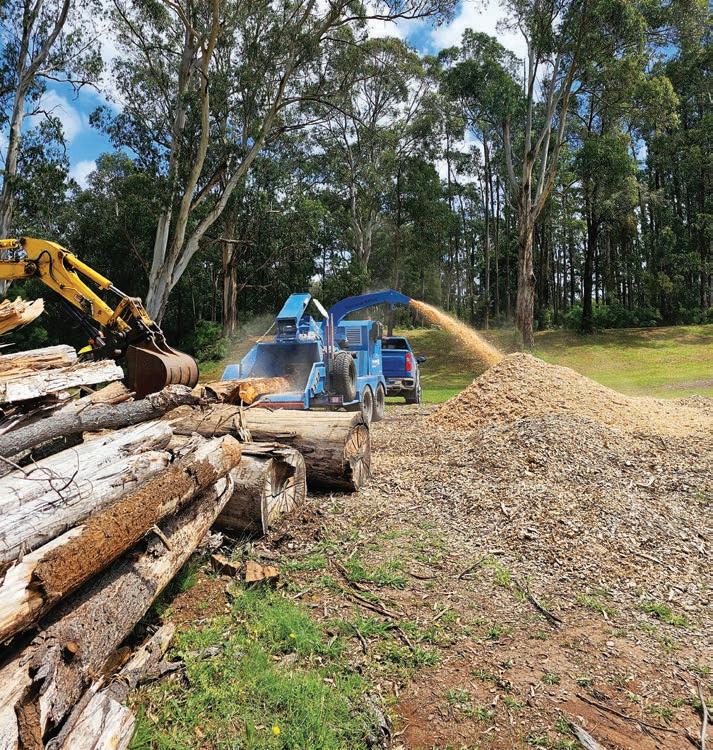
When Piranha Chippers unveiled its BT300, The Australian Arbor Age was quietly impressed.
Powered by the 4HK1 Isuzu turbodiesel engine which produces a classleading 197hp, the BT300 runs a 650mm diameter cutter drum which weighs 400kg, and there’s a 380mm X 500mm (15" X 20") direct opening into the cutterdrum housing – there are no step downs.
It’s obviously a serious 15" capacity chipper with plenty of horsepower, and a state-of-the-art electronically controlled common-rail direct-injection diesel motor offers amazing fuel economy and runs at very low volume.
The dual horizontal infeed wheels give plenty of pulling power, and with the advantage of a hydraulic winch which quickly folds out of the way when it’s not needed, trees and branches are dealt with using minimal physical effort from the operators.
A hydraulic auto-engage clutch, hydraulic discharge-chute swivel and the hydraulic tailgate raise-andlower functions were the icing on the operational ease-of-use cake.
Details
While all that was impressive enough, we were also struck by how much thought had gone into access and time
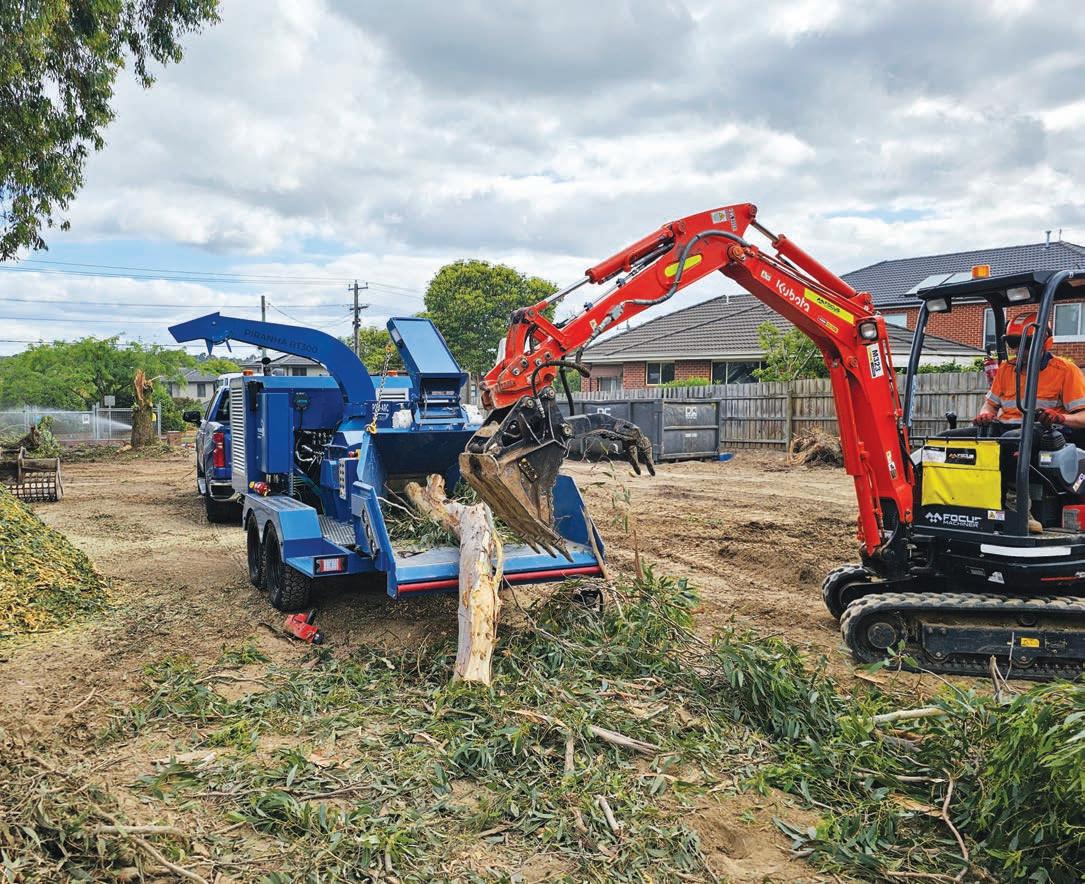
saving on servicing and maintenance.
Service intervals on the Isuzu 4HK1 are 500 hours, which marks the Piranha as a professional-grade machine. Piranha was also quick to point out that with so many arbor and forestry companies running Isuzu trucks and commercial vehicles, the stockholdings of essential engine parts and spares can be greatly reduced.
As far as access goes, all filters and service points are within easy reach when the front door of the engine compartment is opened, and a remote oil drain hose makes draining the sump quick, easy, and, most of all, not messy. An access door at the top of the engine cover makes replacing the oil a breeze, and a work light mounted inside the engine bay ensures the maintenance and servicing is very low-stress.
Another big plus on the Piranha BT300
Piranha as a company isn’t sitting on its hands and congratulating itself. It’s still trying to improve “ ”
is the access to the chipper knives via the side walkway ramp. With the chipper housing hood open the top part of the cutter drum is nicely exposed, making changing the knives extremely easy and, above all, safe.
With a machine as new and impressive as the Piranha BT300, we were a little surprised when we rang Piranha Chippers boss man, Nathan Sangster, to ask how things were going, and he
told us he was out in the field with the BT300 doing some development with a discharge chute modification.
“When we built the original machine we had a fixed-height discharge chute,” he explained as the Isuzu purred away quietly in the background. “The chute could swivel 360 degrees, but the height was fixed. The end has a deflector for shooting the woodchip down to the ground if needed, but we found it couldn’t shoot up into the taller arbor trucks. They were too high. It wouldn’t
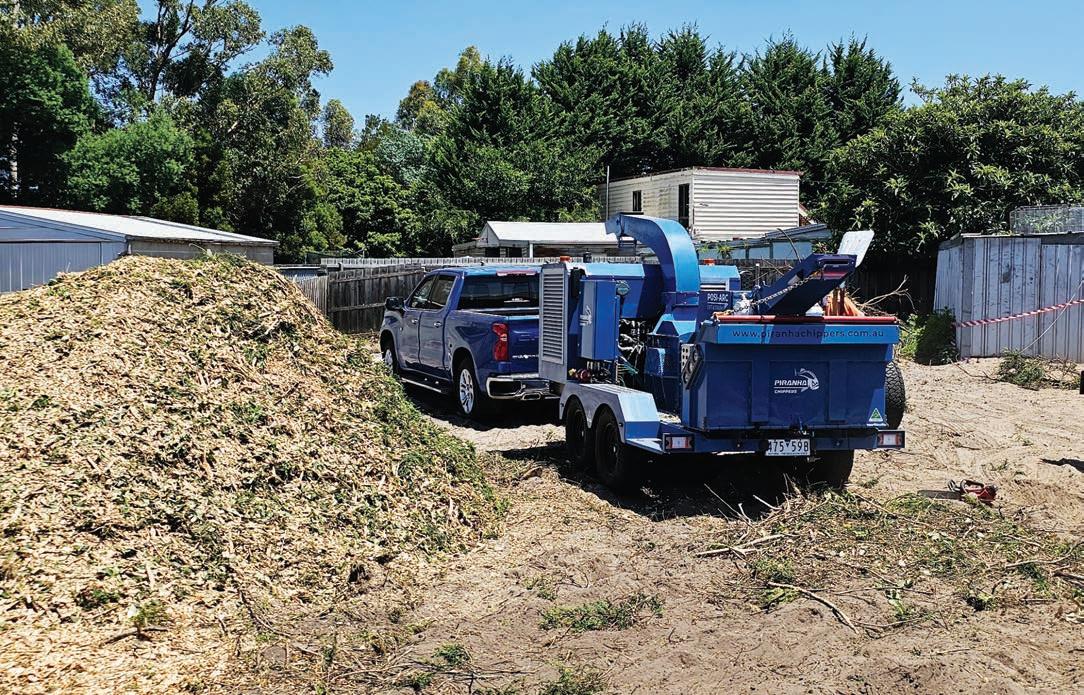

The aim is to make the BT300 work better and make it easier and simpler for everyone “
”
reach up into the back of bigger trucks.”
We could see that wouldn’t be ideal, especially when the BT300 obviously had the power to throw the discharge a good distance.
“We’ve now developed a heightadjustable discharge chute. It can be lifted up and it’ll send the material up and all the way to the front of the big Kenworth tippers if needed,” said Nathan, clearly pleased with the development.
It’s a testament to the Australianmade Piranha BT300 that while it’s undoubtedly a well-designed and tough, professional machine, Piranha as a company isn’t sitting on its hands and congratulating itself. It’s still trying to improve.
Apparently the testing and fine tuning of the new chute had taken a fair slice of Nathan’s time.
“We’ve spent weeks!” he told The Australian Arbor Age.
“Weeks and weeks this testing has been going on for.
“Even this week we’ve done three days out in the field testing this, tuning that, going back and cutting off some more steel, welding some more on in a different place…
“The aim is to make the BT300 work better and make it easier and simpler for everyone.”
It’s a noble aim, and we tip our hard hats in Piranha’s direction.
It’s the way really great machinery evolves.


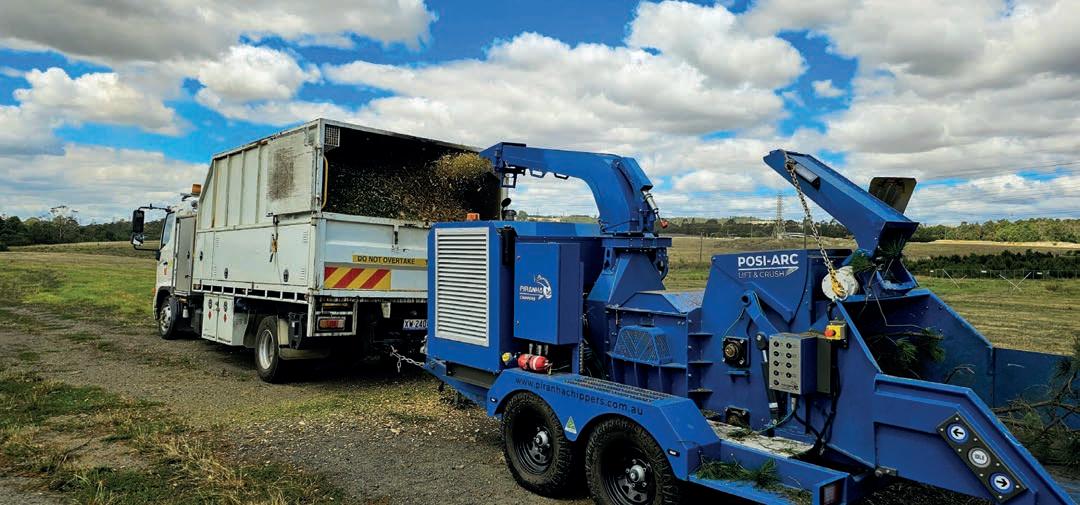

Thanks to a new partnership with UK company Klou, attachment specialist Forest Centre offers a broader range of solutions for excavators – especially grapples.
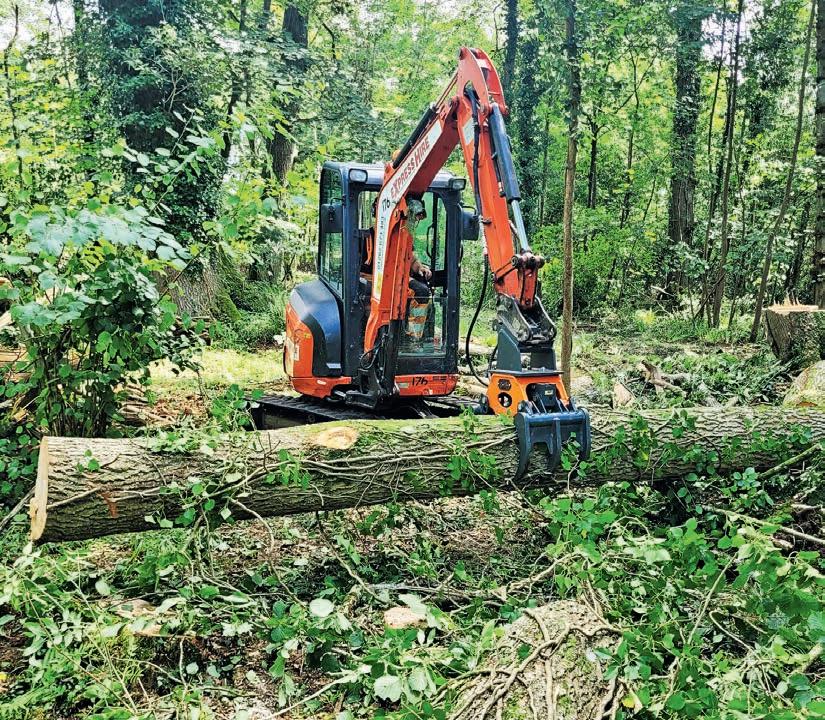

Reymund Kell, Director at Forest Centre in Tumut, NSW, is a very knowledgeable bloke when it comes to heavy machinery and its specific uses. He’s always enthusiastic whenever he’s speaking to The Australian Arbor Age, and he seems especially keen on the details behind choosing the right grapple or grapple saw for a contractor’s needs.
Lately Rey’s been directing his attention to the smaller excavators and skid steers often encountered on a tree-work site, and when we caught up with him recently we weren’t all that surprised to learn Forest Centre had added another arrow to the quiver.
“As we’re working more frequently with arborists,” enthused Rey, “we’ll be concentrating on the excavator grapples manufactured by Klou.”
‘Klou?’ we wondered. ‘Wasn’t that company started by Cutters?’
Cutters, Klou’s parent company, kicked off in the UK in 1999 as distributors of landscape and forestry equipment in South Africa. Originally, Cutters provided garden and arborist equipment sales and servicing across the UK’s south. But by 2010 Cutters had expanded into the manufacture of hydraulic attachments.
In 2014, the decision was made to concentrate solely on the attachment side of the business under the brand name of Klou – which rhymes with ‘plough’, by the way.
Since then Klou has grown into a global business which supplies customers in the Americas, Australasia, Africa and across Europe with highquality hydraulic attachments manufactured in Dorset, UK.
The company’s catchcry is ‘brutally effective’, and in the world of excavator attachments, it’s probably a good one.
Klou’s KXG-10 is built tough for the professional operator and optimised for the popular two-tonne to five-tonne class of excavators, both with and without rotation.
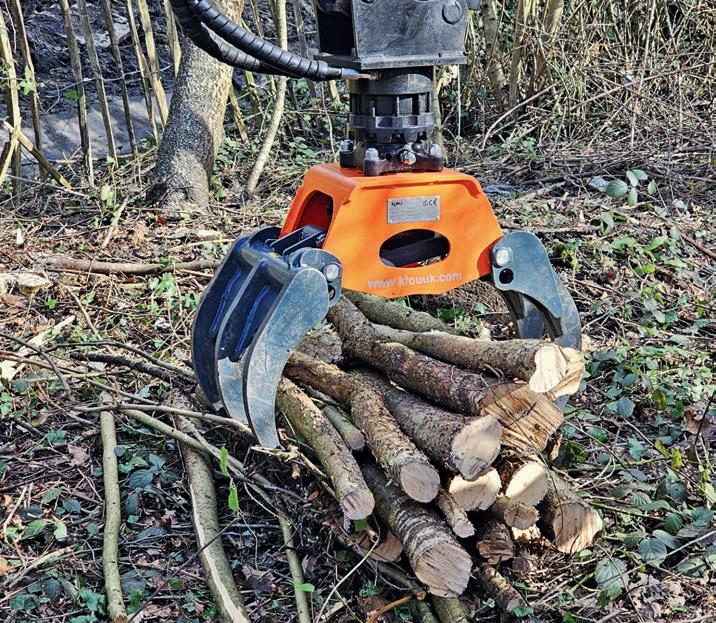
The attachment is designed and built to handle almost anything, including:
• Timber
• Bra sh Stone and concrete
Klou claims the KGX-10, being made of Hardox® and Strenx®, is ‘practically indestructible’. It says the grapple can work fast thanks to optimised geometry, can rip out fences, roots
The KGX-10 is backed by a three-year warranty, which says a lot for Klou’s faith in its equipment.
New model on the way Rey Kell was understandably rapt to have Forest Centre offering machinery of such high quality, but he was just as excited at the pending release of a new Klou grapple for five-tonne to eighttonne machines.
“Our primary focus remains with purpose-built tree- and timber-handling attachments for larger machines,” he explained, ‘though it’ll be great to offer some complementary solutions for the smaller excavators many arb businesses run, too.”
The first KXG-10s were yet to arrive at Forest Centre as we wrote this, but they’re not far away. Keep an eye on forestcentre. com.au for updates on availability and for first-class tree-handling machinery
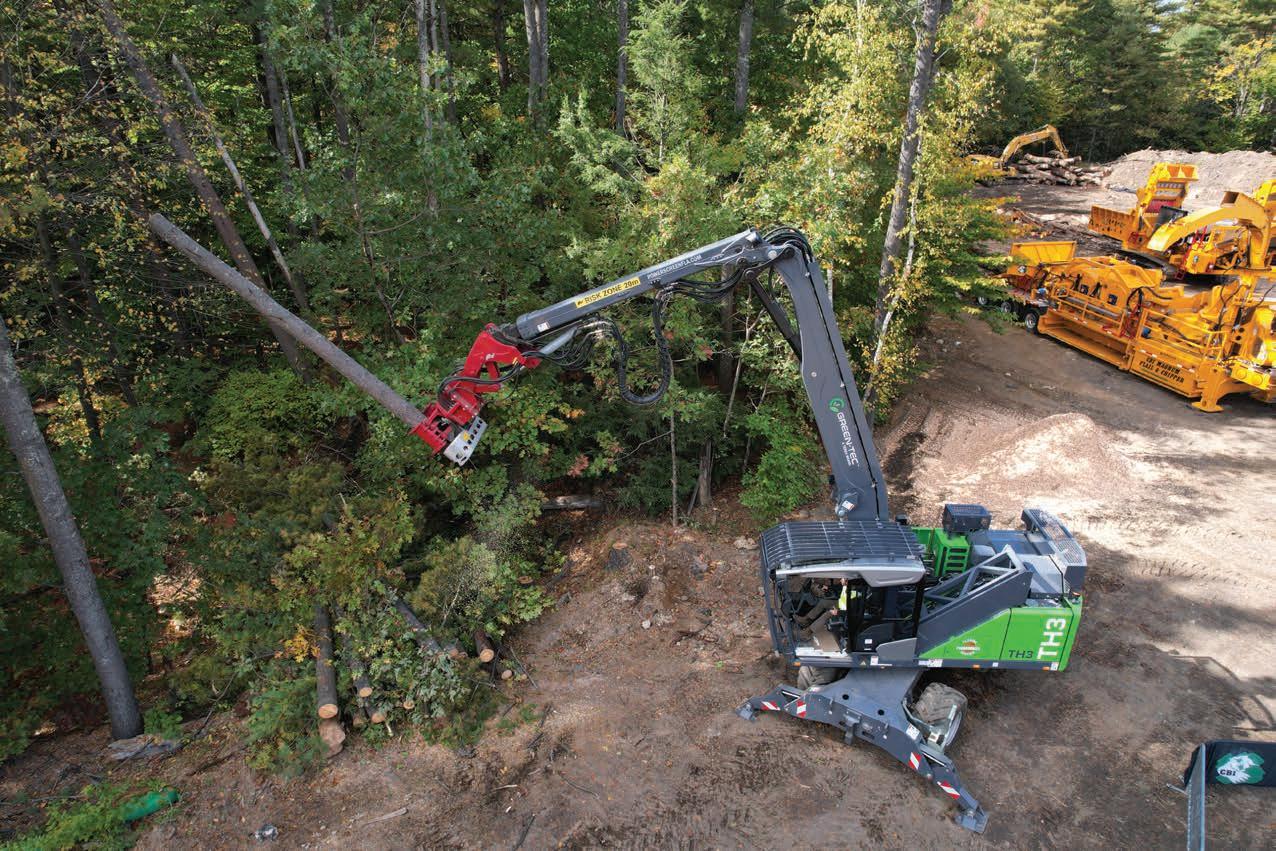


Merlo’s flagship rotating telehandler can operate on a huge range of terrain – everything from factory loading yards to uneven forestry sites – and use a big variety of attachments.
When it comes to versatility in forestry operations, Merlo’s 50.26Plus rotating telehandler is tough to beat. From construction jobs with high access points to tree-service jobs that require a telehandler with a grapple saw or a telescopic tree pruner, the Merlo Roto 50.26Plus can do it all.
Tackle just about anything
The strength of the Merlo lies in its wide range of attachments.
While the list of available attachments is a long one – including, but not limited to, buckets, hooks, platforms and a
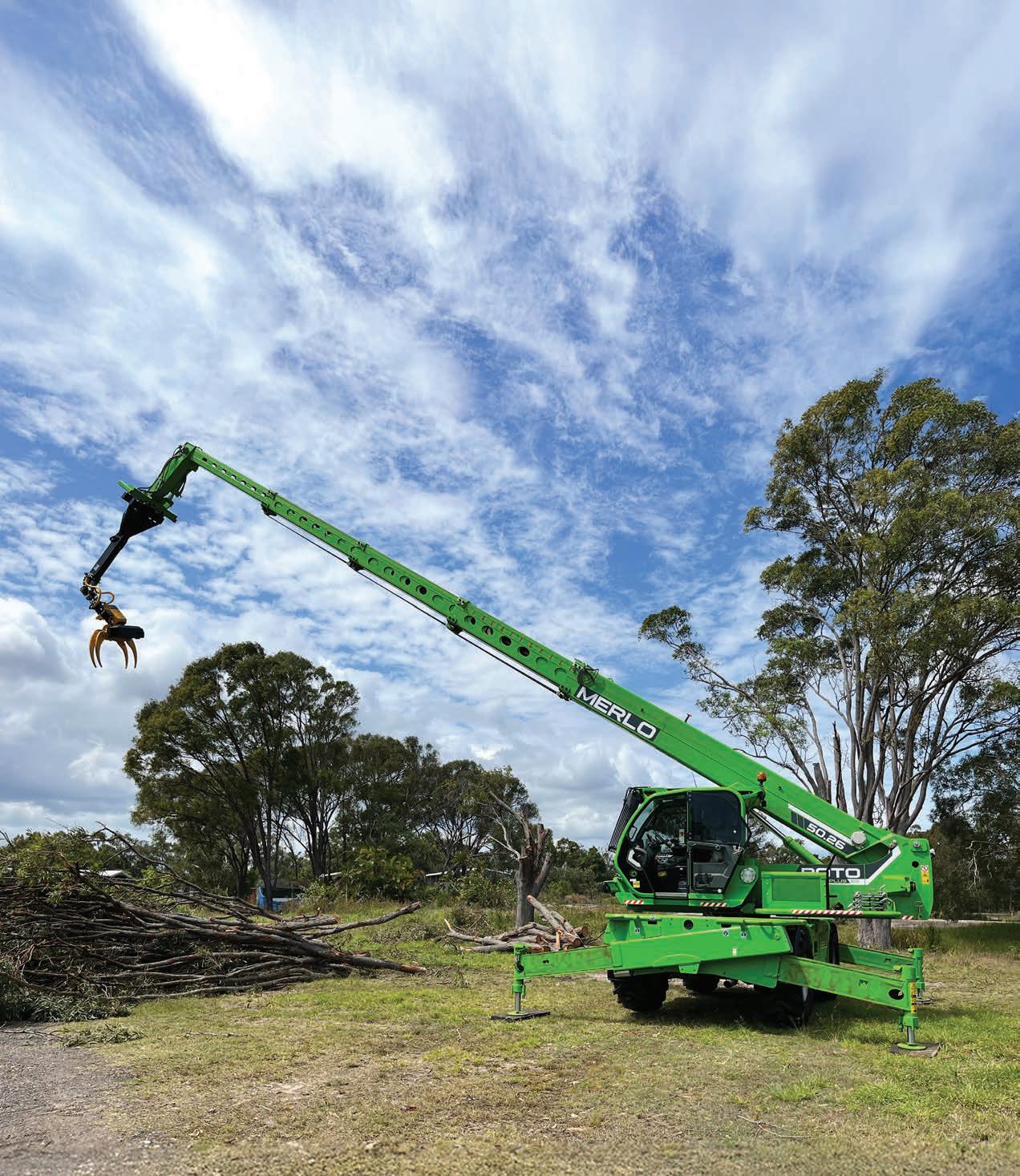
When it comes to versatility in forestry operations, Merlo’s 50.26Plus rotating telehandler is tough to beat. Images: EEA
range of specialty equipment – the standout in the forestry and arbor fields is definitely the machine’s performance with grapple saws like the GMT035 and GMT050.
The Merlo Roto 50.26Plus can be configured with aerial work platforms complying with EN280 standard, further underlining the machine’s versatility.
Functional and comfortable
Ergonomics were as big a consideration for Merlo in the design of the 50.26Plus as was the machine’s durability and functionality.
Access to the air-conditioned cab is simple, thanks to a door which can be opened 180º and a large handrail to make ingress and egress safe and easy.
The air-conditioning unit itself is built to automotive standards, cutting warmup and cool-down time in half, and the inlet vent is on the side of the cab, away from potential sources of dust and dirt. Inside the cab are eight vents, helping to ensure operator comfort.
Alongside comfort, but an asset for performance, is the grouping of information and the controls of the various systems and devices for
Ergonomics were as big a consideration for Merlo in the design of the 50.26Plus as was the machine’s durability and functionality.
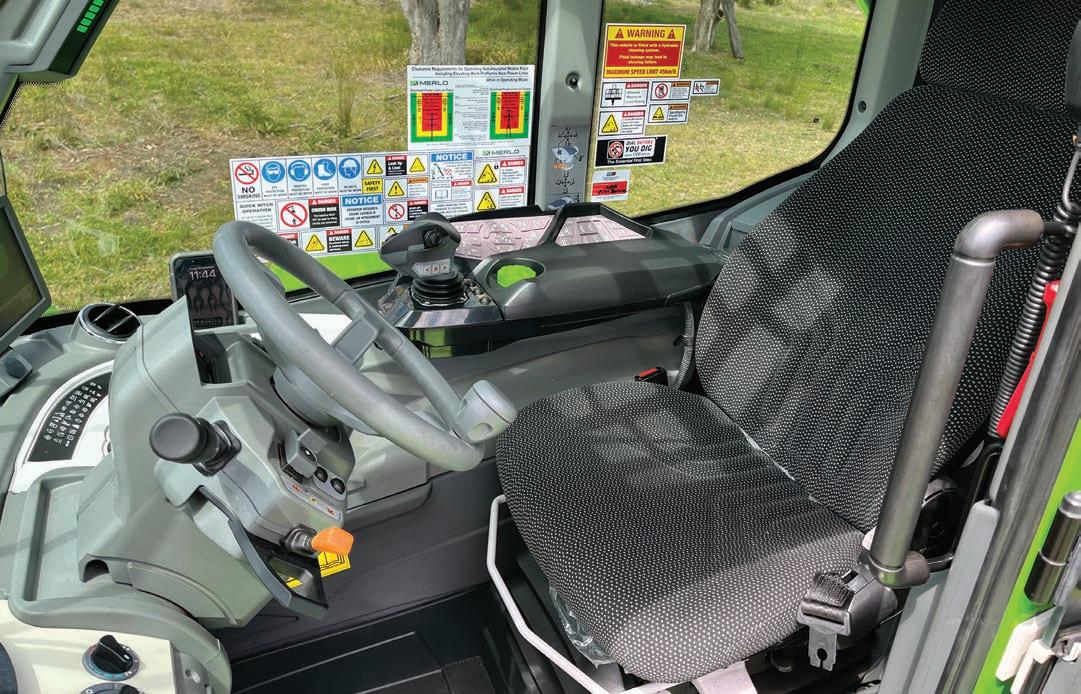
optimum ergonomics, and the reverse shuttle on the steering wheel is also available on the joystick.
The 50.26Plus has a metal structure above the glass roof on the outside of the cab to comply fully with FOPS Level II standard, the most stringent certification level in protecting the operator from falling objects, and in order to remain fully compliant with regulations in frontal tipping prevention, the machine is equipped with features developed specifically to keep the operator safe from frontal tipping, without sacrificing performance, particularly boom speed and lifting capacity.
A 170HP FTP Iveco Cummins engine provides plenty of power for both working and travelling with the Merlo, and to operate the many available attachments. The original Merlo mounting layout was designed to give panoramic visibility and ensure maximum accessibility to components.
Coupled with excellent braking capacity when the accelerator pedal is
released, high torque to the wheels is guaranteed during material handling and transfers, as well as millimetre precision of movements when positioning the load.
For arborists and those involved in treecare work, the primary point of interest in the 50.26Plus will be its performance with a grapple saw, and there are few people who know more about that subject than Rey Kell at Tumut’s Forest Centre
If you’re looking for a grapple, Rey’s your man. We asked him about the Merlo and his thoughts on the attachment best suited to the telehandler for tree work.
“When it comes to grapple-saw equipment for tree-care tasks, we are often asked ‘which one is the best?’” he told us in his usual direct and competent fashion. “Though the jobs couldn’t be more different, we like to draw a comparison to earthmoving – as you most likely wouldn’t carry out all of your work with just one bucket or work tool.
“With grapple saws there are various different solutions and, as a buyer, it’s nice to know some freedom of
choice extends to their application on telehandlers too.
“On Merlo Roto machines two different plug-and-play grapple-saw solutions are available, each tailored to different working needs. These come with Merlospecific ZM2 attachment hitch pickup, hoses and electrical connection.
“When a high degree of flexibility is required for approaching cuts from different angles and working within the canopy – like having a climber in the tree – the GMT Equipment felling grapple saws, GMT035 and GMT050 with Total Tree Control are an unbeatable combination.
On the other hand, if the work ahead will more often require larger cutting and heavier lifting capacity, perhaps with a larger drop zone or processing area to work with, the CS750 Smart grapple saw from Westtech Woodcracker may be the best fit.
“For the ultimate in capability, you can of course have both attachments for Merlo Roto 50.26Plus machine and utilise each as your project needs change.”
There are a few alternatives there, but one thing is constant: The Merlo 50.26Plus.
Regularly check drum speed, shift pressure, and balance to ensure smooth operation.
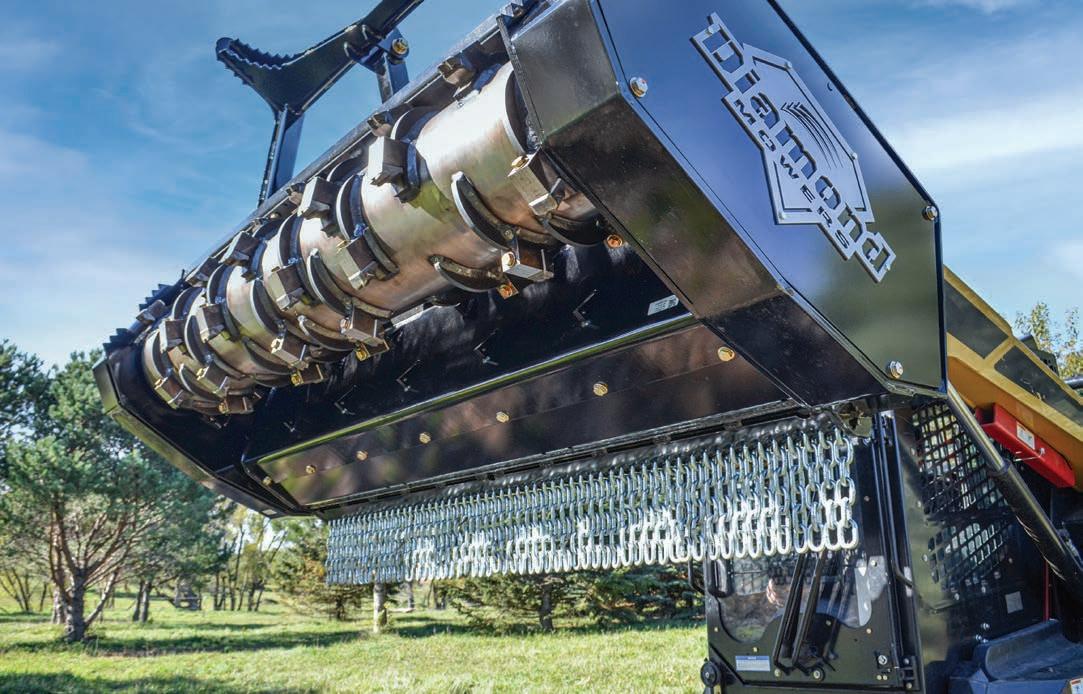
Vital for land clearing, vegetation management and utility maintenance, the effectiveness of mulching equipment depends on its proper operation and upkeep. To help get the most out of their attachments, the experts at Diamond Mowers have compiled some essential tips for optimising performance and extending equipment lifespan.
Mulching equipment plays a crucial role in land clearing, vegetation management, and utility maintenance. Whether tackling dense undergrowth or clearing storm debris, having the right tools can make all the difference. To help landowners and mulching pros get the most out of their equipment – whether they’re using depth-control or open-drum configurations – the experts at Diamond Mowers offer the following tips for maximising the performance and lifespan of mulching attachments.
To keep drum mulchers operating at peak performance, routine maintenance is essential. Skid steer and excavator operators can prevent costly downtime and maximise efficiency by:
• Caring for mulching teeth. Among
the hardest-working components of a drum mulcher, teeth may need to be replaced throughout the year, depending on operating conditions. Since they endure constant wear from processing vegetation and engaging with the ground, regular
Founded in 2000, Diamond Mowers is a leading manufacturer of mowing, mulching, and brushcutting equipment for the skid-steer and excavator markets. The company’s products include boom mowers, rotary mowers, flail mowers, and forestry mulchers for municipalities, contractors, and landowners, as well as attachments for small-scale and large-scale brush clearing operations.
inspection and maintenance are crucial. Four-point hardenedsteel teeth can be removed, sharpened, or rotated directly on the attachment to maintain efficiency and productivity. Twin Chisel® Planer Teeth are even easier to maintain since they can be sharpened while still mounted to the drum. Twin Maul® Carbide Teeth require no maintenance and simply need replacement when worn or damaged
• Inspecting hoses, couplers, and connections for signs of wear or damage before each use. Loose fittings should be tightened and worn components replaced to prevent downtime and ensure optimal performance, and
• Cleaning the drum and checking for debris buildup or damage after every use. Regular cleaning prevents clogging and reduces unnecessary strain on the equipment, extending its lifespan.
Maximising the performance of a drum mulcher isn’t just about maintenance – proper operation is just as important.
• Optimise hydraulic flow: ensure the carrier’s hydraulic flow matches the drum’s specifications to achieve
Teeth may need to be replaced throughout the year, depending on operating conditions.
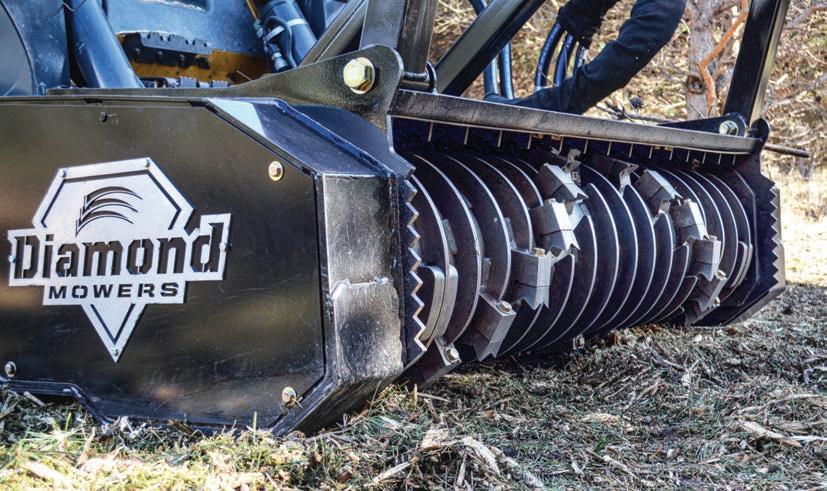
Reduce strain on the mulcher and improve results by making multiple passes through dense vegetation.
working with dense undergrowth should focus on steady, controlled operation “ ”

maximum cutting power and efficiency
• Tune the drum for optimal performance: regularly check drum speed, shift pressure, and balance to ensure smooth operation. Adjust settings to match material conditions, preventing excessive vibration and promoting even cutting.
• Use strategic cutting techniques: reduce strain on the mulcher and improve results by making multiple passes through dense vegetation. Excavator-drum-mulcher operators can take advantage of their machine’s extended reach for precise mulching in hard-to-access areas such as steep slopes, pond edges, or roadside ditches.
• Prevent overloading: avoid forcing the drum into materials beyond its cutting capacity. Skid-steer operators working with dense undergrowth should focus on steady, controlled operation to maintain consistent productivity and prevent unnecessary wear.
Routine maintenance and proper operation not only extend the lifespan of mulching equipment, but maximise performance and productivity, ensuring consistent results. By selecting the right drum mulcher for an application and maintaining equipment, operators can confidently tackle the toughest jobs.
Visit colbrookindustries.com.au to learn more.
The Queensland Arboricultural Association (QAA) continues its great work.
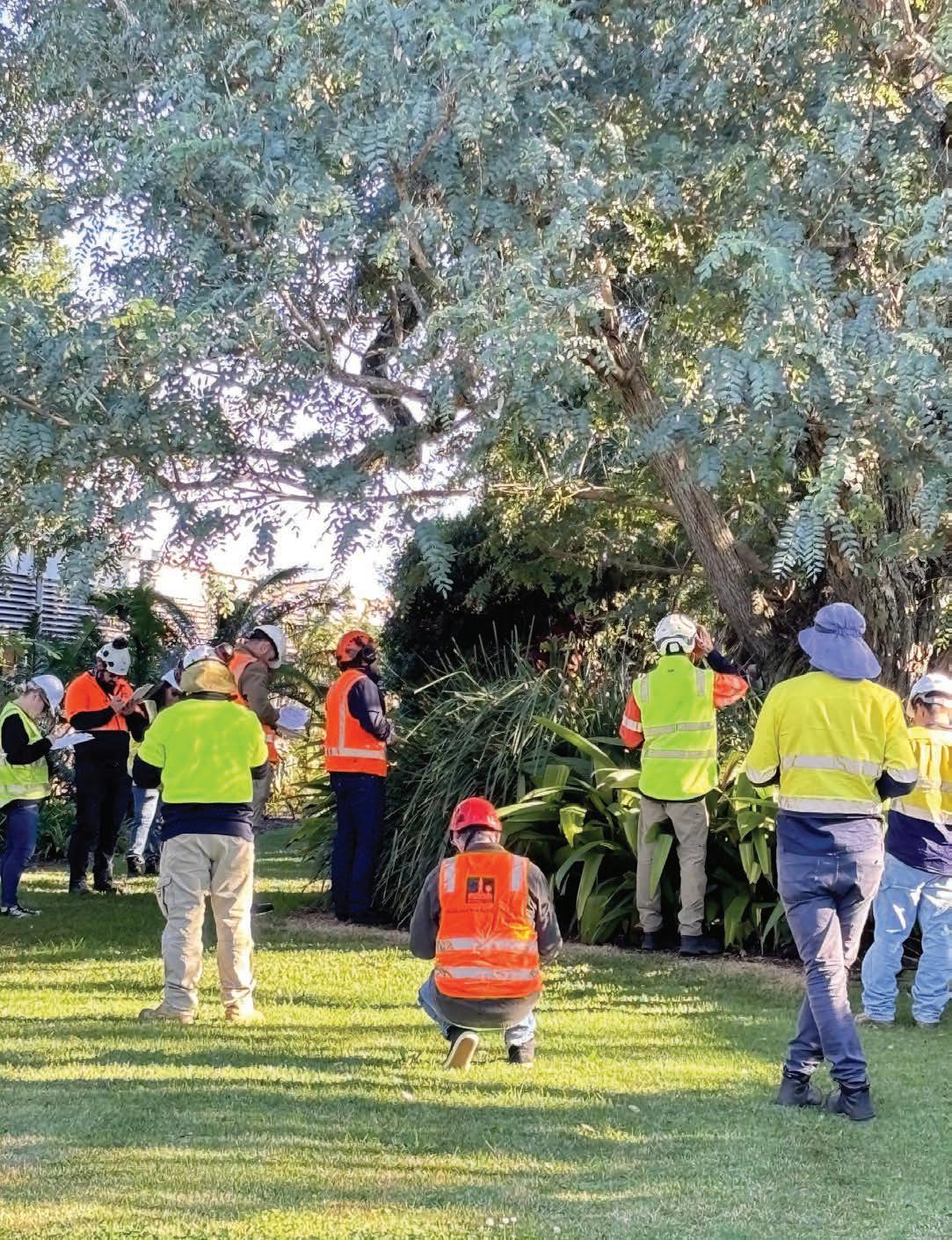
ISA has announced significant updates to the Tree Risk Assessment Qualification (TRAQ) program, set to launch in late 2025. Images: QAA
Abig thank you to all who attended the February Meet & Mingle. It’s fantastic to see this event gaining momentum, bringing together industry professionals in a relaxed and engaging setting. If you missed it, don’t worry – the next Meet & Mingle is set for April.
Stay tuned to QAA’s social-media channels and website for updates. If you’re interested in getting involved, reach out —the QAA would love to hear from you.
QAA is committed to helping businesses and arborists align for long-term success. The association actively promotes initiatives to connect professionals with the right teams and opportunities within the industry. If you’re interested in learning more or getting involved, get in touch by phoning (07) 3821 1488, emailing office@qaa.net. au, or through the website.
ISA TRAQ program changes are coming in 2025.
ISA has announced significant updates to the Tree Risk Assessment Qualification (TRAQ) program, set to launch in late 2025.
Key changes will include:
• New training and exams – a revised program with updated training materials and examinations will roll out in Q3/Q4 2025
• Extended certification validity – TRAQ certification will now last seven years instead of five, and
• End of TRAQ renewal – the current renewal option will be phased out once the new program is live. What does this mean for you?
A few things, but mainly:
• Current TRAQ holders will remain certified until their credential expires,
• TRAQs renewed before November 2025 will have their certification extended under the existing system (five-year validity), and
• Those who want the seven-year credential will need to wait for the new program’s release.
Check your certification status via the ISA Directory to ensure you’re up to date.
The Quantified Tree Risk Assessment (QTRA) workshop is back on May 22 and May 23.
There are only a few seats left, so secure yours now before they’re gone. To register, contact QTRA directly.
Join QAA members for an exclusive Single Rope Technique (SRT) workshop at Tamborine Showgrounds on Saturday, April 05, led by the world’s number-one climber, Barton Allen-Hall.
Learn advanced SRT skills from the best in the field.
Following the workshop, don’t miss the Masters Invitational on Sunday, April 06. It’s set to be a thrilling competition showcasing top-tier climbing talent. For more details and registration, visit qaa.net.au.
Stay updated on events, workshops, and initiatives by following QAA on social media or at qaa.net.au.


ArbWest recommends engaging with a professionally trained arborist for advice on wildlife interaction with trees. Image: Michelle/stock.adobe.com
The
Arboricultural Association of Western Australia (Arb West)
shares some thoughts on managing trees and wildlife.
Arborists have a passion not only for trees, but also the wildlife they support.
In arboriculture it’s a fine balance between managing trees and maintaining natural habitat, food sources and a healthy ecology to support local fauna. The work of treecare professionals impacts not just trees, but also the wildlife that relies on those trees, and, in turn, the clients’ properties.
It’s important to ensure advice is the most up-to-date a trained, certified arborist can give, to ensure services don’t inadvertently cause issues for the homeowners.
Here are ArbWest’s three key points to consider while maintaining trees to ensure a harmonic balance with nature.
1. Tree Planting: nut-bearing and fruit-bearing trees
While species like figs and apple trees are beautiful and beneficial, they can
attract rodents and other critters if not strategically placed. When arborists provide professional advice on tree selection, they consider the location of fruit-bearing trees and advise planting away from buildings and structures.
For established trees, maintenance pruning is advised, such as formative pruning, clearing old fruit and removing dead wood. This will not only help keep pests away but assist in the new season’s growth and overall structural form of the tree.
As fruit ripens, don’t forget to harvest the fruit so it can be enjoyed. If left on the tree, pests can become present, and owners may consider removing the trees as their preferred option.
Kelvin Ussher, ArbWest President warned: “If an owner allows this to persist, they may require the services of a pest exterminator, who may advise to have the tree removed. Awareness and education of these potential issues via a trained
arborist can often negate or remove these infestations, with forward planning and maintenance being the key.”
Consider open areas for fruit-bearing trees. The added light and airflow often enhance the amount of fruit produced as well as minimising rodent issues. Also, avoid planting them near high-traffic zones like driveways or pathways where they can create slip hazards – or beside retaining walls and fencing where the root systems may cause structural issues long term.
Annual or biannual inspections of trees by a qualified professional arborist is advisable. Not only do the trees receive a health check, but the advice incorporates the overall maintenance and health of green spaces to maintain safe distances from property and infrastructure before it becomes a costly issue.
Trees provide food and shelter for animals; they also provide travel routes. Branches that overhang, or touch, roofs act as access points for local fauna.
“When trees are giving the local wildlife easy access to the roof, rodent problems are almost guaranteed,” Kelvin Ussher said. “This is particularly true if the trees are of the nut- or fruitproducing variety.
“The benefits of using trained arborists in maintaining trees around a property ensures an abundance of fruit, infrastructure kept clear of rodents and bushfire concerns, plus it addresses the structural and formative form of the tree for potential storm-damage prevention.”
3. Handle tree stumps wisely
Tree stumps, while beneficial for some wildlife, can also attract pests such as rodents, snakes and white ants. These pests often find stumps to be ideal for nesting and breeding, especially within urban areas.
A trained arborist will advise the best method of stump removal as it often depends on factors like the size of the stump, its location, the risks involved and how these can be mitigated.
Unfortunately, there aren’t many hard-and-fast rules regarding the best way to remove stumps. Depending on the situation, consider stump grinding which can remove most of the tree base. Chemical treatments should only be considered as a last resort due to the implications to both native fauna and resident pets.
ArbWest recommends anyone with a potential issue to engage with a professionally trained arborist for the right advice on wildlife interaction with their trees and all maintenance requirements. This will help avoid costly future issues while also fostering the preservation of trees and maintaining a harmonious environment for local fauna to inhabit.
Visit arbwest.com.au and search the ‘Find a Contractor’ section for a professional arborist servicing your area.


Image: Paul/stock.adobe.com

Depending on the situation, consider stump grinding which can remove most of the tree base.
Image: Waldis/stock.adobe.com
The TTIA’s Brian Beecroft offers some important points to consider when dealing with an underperforming employee.
Irecall once reading a decision issued by the Fair Work Commission specifically suggesting that when an employment relationship had broken down, employers should consider the option of demotion rather than outright termination as a preferable alternative disciplinary measure. It instantly raised the issue of whether an employer demoting an underperforming employee runs the risk of an unfair dismissal under the Fair Work Act, and whether the associated issues relating to procedural fairness still apply.
‘Significant’ reduction?
In some circumstances management may feel the offer of demotion to
a position is more suitable to an employee’s skills and experience when they have failed to prove their competence in another role. While their duties and responsibilities would change, there is often a lower remuneration attached to the demoted position. Therefore, the key issue is, does the employer have the right to demote the employee for reasons of unsatisfactory performance?
While demotion, in this circumstance, may be viewed by the employer as preferable to the dismissal of an employee, there are a number of implications of which an employer should be aware when considering the demotion of an employee. The Fair Work Act (s386(c)), in explaining the

Brian Beecroft TTIA CEO
meaning of dismissal for the purpose of unfair dismissal, states a person has not been dismissed if the person was demoted in employment, but

the demotion does not involve a ‘significant reduction in the person’s remuneration or duties’, and the person remains employed with the employer that effected the demotion.
What amount represents a ‘significant’ reduction in remuneration or duties can be difficult to assess, and would be determined on the individual circumstances of each case. It can also be a factor whether the employee will consent to the demotion.
Demotion generally involves the termination of the employee’s existing contract of employment and the offer of a new contract. This is because the terms of the new contract are usually significantly different in at least one important aspect (job status, work duties, responsibilities,
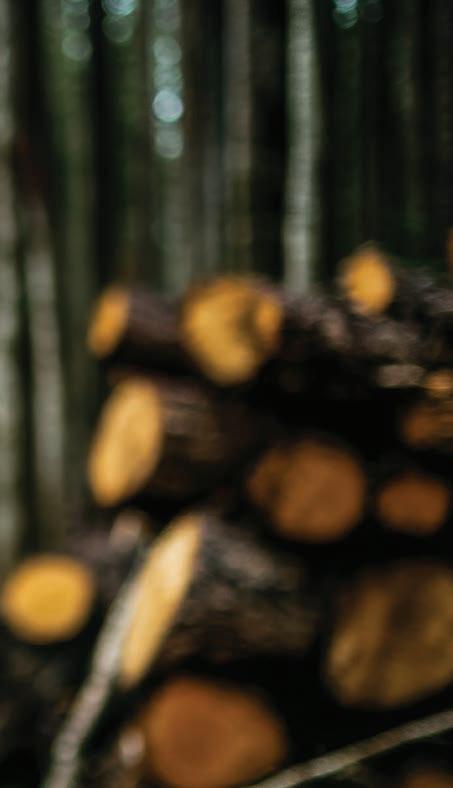
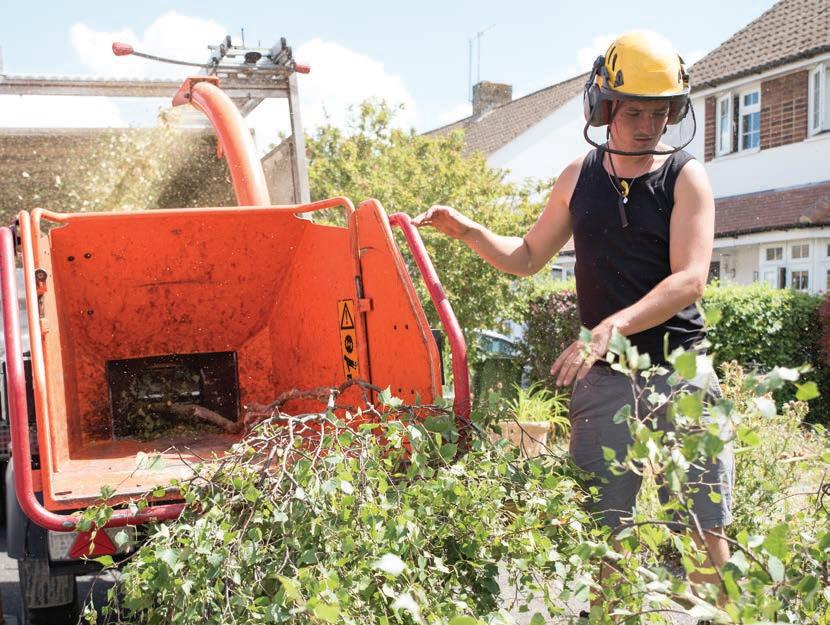
There are a number of implications of which an employer should be aware when considering the demotion of an employee. Image: Roy Pedersen/ stock.adobe.com
If a demotion turns into a claim for unfair dismissal, the employer will need to prove he or she acted with procedural fairness “ ”
Employers should consider the option of demotion rather than outright termination. Image: Oulaphone/stock.adobe.com
remuneration, career prospects and so forth). Because termination of the contract is involved, it raises the possibility the employee has actually been dismissed rather than demoted. The employment contract could be repudiated when an employee is demoted without their consent, and suffers a significant reduction in duties or remuneration. The employer must also be careful in avoiding any hint of duress or influence in the employee’s decision to accept a demotion. Because demotion and dismissal are alternate options, TTIA members should follow the same procedures leading up to the decision to either demote or dismiss. These are likely to include objective performance reviews and discussions, performance counselling, warnings, opportunities to improve, training, and similar circumstances. If a demotion turns into a claim for unfair dismissal, the employer will need to prove he or she acted with procedural fairness before making its decision, and whether there was a valid reason.
A demotion which involves a significant reduction in the employee’s remuneration or duties may be deemed by the Fair Work Commission as unfair dismissal unless permitted under the contract of employment, or applicable modern award or enterprise agreement.
TTIA is proud of offering members the peace of mind of knowing they have access to the association’s inhouse lawyer and legal department. This service is unique in the timberproducts industry.
The TTIA won’t refer you to a third party for legal assistance.
With this in mind, members should consult the TTIA for legal advice in any circumstance involving demotion issues, whether performance-related or for other reasons like redundancy or restructuring, to avoid potential costly litigation.
Contact the TTIA on (02) 9264 0011, or by email ttia@ttia.asn.au, for advice on this issue.



TCAA
regular Jim McArdle underlines the
importance of networking among people and groups with similar goals and interests.
Collegiality is a broad term used to describe the elastic bond of communication between arborists in a similar group, body or blog space. The definition of collegiality I like best comes from the Oxford Dictionary and reads: ‘As a noun, collegiality means cooperative interaction among peers. As an adjective, collegiality indicates the way a group of colleagues take collective responsibility for their work together with minimal supervision from above’.
The energy of collegiality is in the process.
Most of us can relate to collective responsibility or people who work pleasantly together for a time. It sounds like a dream, and I’m sure we’ve all started on the ground and felt we weren’t initially really part of the team.
But those who join an association will meet people with similar aspirations and ideals, and the collegiality is there right from the start.
Communication is a huge factor in collegiality.
Not all experienced, bona fide arborists are good at sharing their thoughts and ideas. Sometimes, with the best of intentions, thoughts and principles can be shared far more easily when discussed in a group – especially with diagrams and images – as opposed to in a mentor-to-mentee discussion. An association meets regularly and the interaction with an executive team can Those who join an association will find collegiality from the outset. Image: Chanyapat/stock.adobe.com
‘turbo’ discussions and resolutions and help clarify explanations and enquiries.
Advantageous
Networking, advertising, utilising similar risk tools and creating a blog or email trail often encourages peers to form a collegiate group, and groups of that kind are very beneficial to the people and ideas they represent.
Writing and communicating – or representing and teaching – are ways in which an arborist can increase their experience in arboristry. The written word is perhaps the best medium, and certain documents should be scoured for news, technological examples or a new way of progressing.
Discussions which increase cooperation are often the basis on which industry collegiality is founded. Put this together with interested colleagues from forestry, council Tree Preservation Order officers, environmental lawyers and barristers – people with aligned interests – and a thinktank may emerge with a new position on arboristry practices and principles that have been debated or discussed.
Sometimes, with the best of intentions, thoughts and principles can be shared far more easily when discussed in a group “ ”
A relevant example is the Code of Practice that has been worked on since 2006. With years of involvement I’m sure Dan McArdle – one of two arborists on the board – has finally seen the light on this new, soon-to-be released document. Assembling this material was an epic collegial exercise and the whole arboriculture industry will benefit.
Other amazing left-of-field arboristry ideas which emerged from sharing and broad thinking include:
• The professor from UTS-NSW technology who utilised trees and green spaces on roofs as a step into the future. It was fascinating to see how arboriculture and design overlapped, and issues like soil depth, soil fertility, exposure and other variances on a tall-building rooftop interacted to affect tree growth and stability;
• Avatar, the blockbuster film by James Cameron, entirely based its scenery on fluorescent creatures and plants;
• A crowdsourcing team raised $440k in one day from backers all around the world for a chance of fluorescent seed progeny (biogenetics). According to the journal Scientific American, this brilliant idea has rolled around in science since 1924;
• Utilising plants like hemp in construction and fashion;
• Research and development of fastgrowing cultivars to produce timber within four to five years link sample plots studied around Sydney;
• Katie Holten, an aloof evolutionary
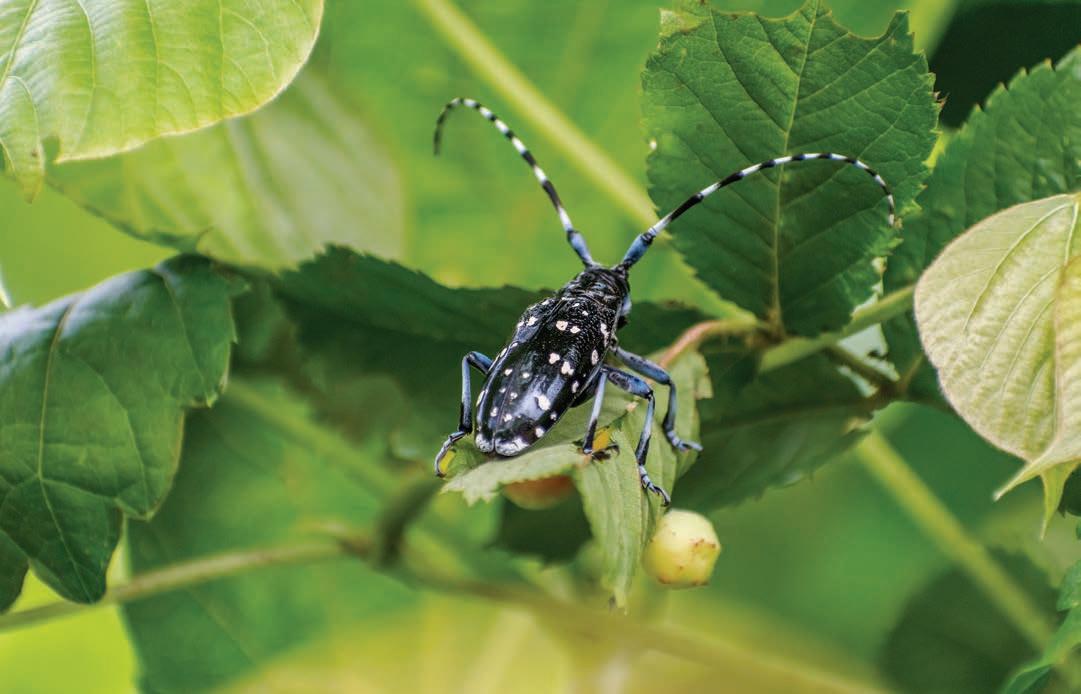

biologist, noted Leonardo da Vinci’s mathematical observation, ‘Branches of a tree at every stage and at any height, when put together, were equal to the trunk below them’. There is tree maths in Tree Protection Zone calculations and SRZ formulae, climate data to interpret like tables of BOM weather patterns, and it’s surprising the amount of maths relating to wind force as Breloer & Matthecks showed in The Body Language Of Trees: A Handbook For Failure in 1994;
• Maths for ratings, estimating weights and specifying weights may be absolute, but sometimes an engineer has less knowledge than the incumbent arborist when it comes to weights of tree species. Bracing and estimating weights from crane use, and from questioning an expert crane driver if the weight is bearable or reaching capacity of a load, can sometimes be a justifiable alternative, and the collegiality can have very real and serious benefits;
• The rapid transport of exotic pests and diseases is a key issue. Identifying risks to our urban forest biosecurity
There are many good arborists in the field who enjoy being collegial but rarely have time because of their crackingly busy schedule “ ”
requires vigilance. Pests need to be identified and communicated to agencies and the general public informed when something is going wrong in our forests – like pine nematode eradication with no active vector in Melbourne, and myrtle rust affecting trees in the Daintree and causing extinction events in some species. Agonis flexuosa is susceptible
and perfect for development of this disease. Being collegial we can ‘resist’ the new Asian Longicorn beetle, the Mulberry Longicorn beetle and the Japanese Pine Sawyer beetle. Those are three pests we don’t want in our country, but which have found entry to Australia. Serious issues like these need vigilance or we’ll lose large tracts of forest;
• AQF level 5 arboristry is collegial in utilising researchers, including climate consultants and ecologists (bio-credits), and we’re pressed into collegiality because we need other experts to support or challenge us to a new position.
Several peak bodies in Australia use a qualification process to promote learning in arboriculture. So many points need to be done or completed to keep membership.
This idea of accreditation is perhaps outdated, but at least it keeps achievements transparent to the executive. I’m of an opinion that real learning comes from understanding and communicating in a variety of

It was fascinating to see how arboriculture and design overlapped in the design of rooftop gardens. Image: sorasat/stock.adobe.com
forms, whether podcasts, essays, commentary, photos or another medium to a mentee or mentor.
What about the utilising of AI in our literature? Or the question of new tariff costs on our equipment from the United States?
There are many issues where I urge arborists to skill up with a cooperative and be resourceful. NSW tree climbers have done it, and so have a multitude of interest groups on Meta, Instagram or other social interfaces.
There are basic questions of privacy of resources when sharing, and certainly phoning a colleague and requesting permission to source their works, or seeking their consent for a peer review, is as collegial as it gets. TCAA member Arbor Pride has released gardening newsletters of a high professional standard, and sharing these with members and the public at its own cost has ensured the company is held in high regard. It also confirms its place in arboristry.
Using this process TCAA has contacted many experts and always
found the relationship rounded down to mentor-and-mentee, or one of common industry bonds trying to build decorum. TCAA sourced Jeremy Barrell’s ULE and changed it to TULE with relationship to timeframes. We asked Andrew Morton for his blessing on Retention Values. We also met with the minister and are still trying to get apprenticeships and traineeships for the industry and other industry-related processes.
There are many good arborists in the field who enjoy being collegial but rarely have time because of their crackingly busy schedule.
Why don’t we have students learn arboristry in schools? There are so many good collegial principles that can extend from our field. NATSPEC has a great student prize of $8000 in a national student competition to promote collegiality.
The TCAA will was represented at the Arboriculture Australia 2025 conference and sought to be collegial with other state heads to bring about the licensing of arborists and partnerships.
Why don’t we have students learn arboristry in schools? “ ”
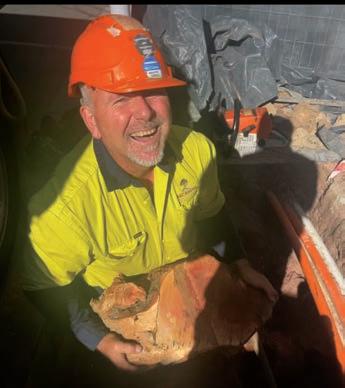

Utilising plants like hemp in construction and fashion came about thanks to sharing and broad thinking. Image: Heng Heng - AI Stock/stock.adobe.com

When
the job calls for non-destructive excavation, Sydney’s Synertree is ready to comply…thanks to AirSpade.
All arborists love trees. That seems fairly self-evident.
But arboricultural consulting company Synertree, based in Rosebery, NSW, takes that ethos to a very high level. The company’s website even claims Synertree is ‘Nature’s collaborative experts, specialising in human and tree synergy’.
It’s a big call, but a call director and AQF-5 consulting arborist Mathew Phillips is proud to make.
With a deep-rooted passion for trees and a strong commitment to environmental preservation, Mathew and Synertree are dedicated to delivering professional, reliable, and sustainable services tailored to individual requirements.
Clever ‘Syner… Synert…”
The Australian Arbor Age’s normally eloquent editor stumbled around the unusual name.
“It’s ‘Synertree’, explained Mathew patiently. “As in ‘synergy’ and ‘tree’.”
The company motto ‘We represent the trees’ clicked into focus and we realised the name was very clever.
Almost as clever as the company’s embracing AirSpade.
“I’m using the AirSpade 2000,” said Mathew, clearly happy to discuss the equipment. “I’m in consultation with Knight Pneumatics to possibly trial the AirVac, and it’s something we’ll look at purchasing.”
Mathew and Synertree offer a big range of consulting services in and around Sydney, and the AirSpade plays a significant part in the company’s operations.
While the AirSpade is a versatile piece of equipment, Mathew is finding an increasing demand for the gear is coming from councils and LGAs.
“Everything ranges from nondestructive root exploration,” he explained. “I would say that’s our primary use of the AirSpade. We do that for everyone from government to private residents.
“It’s mostly for development applications or where trees are impacting infrastructure.”
Aside from that type of reporting and consulting, Synertree has the AirSpade showing its value in various applications.
“We use it for transplanting small trees,” mused Mathew. “Again, mostly within development applications where we identify trees that can be transplanted, or they’re identified for transplanting by architects or landscape architects. We come in and AirSpade around the tree, work out what roots could be pruned – if any, or if we have to – and then we lift the tree and carefully transplant it.
“Most councils, tree officers, and landscape officers in and around Sydney are now demanding non-destructive root exploration, and a lot of the time they’re specifying AirSpade.”
AirSpade’s proprietary supersonic nozzle turns compressed air into a high-speed, laser-like jet that dislodges soil. It’ll easily and gently remove soil around tree roots for better nutrient absorption and growth, and it can dig through soil, clay, and other materials with precision and control, breaking up compacted earth and improving drainage.
Powered by an air compressor, excavation with the AirSpade offers several advantages over conventional tools such as picks, shovels, and backhoes. It’s two to three times faster than hand excavation and causes less worker fatigue. There are no sharp metal edges, so AirSpade is harmless to buried, solid objects such as utility lines, telecommunication cables, hazardous-

waste containers, military ordnance, and, of course, tree roots.
But there’s another big advantage.
“It’s very easy to use,” Mathew explained in a matter-of-fact tone.
“You have to learn how to operate it to get the best results, but we mostly stick with the 105cfm straight nozzle. There’s also a curved nozzle which allows for angled displacement. When you use that setup it takes a little muscle work from the operator to control, but with the straight nozzle it’s excellent.”
Selection of the nozzle depends on the job.
Mathew explained: “Overall it depends on the use, the site, and the level of deposition.
“The AirSpade can displace a lot of soil and it can create a lot of dust, so, depending where you are, you may want to blow it straight into the hole and then move it out the end of the trench with a shovel, or displace it fully and replace the soil.
“Normally we start at the structural root zone or the proposed cut location. Let’s say someone wanted to put in a building and wanted to cut for a slab. We get the builder to outline where the cut was proposed, then, first up, we dig a trench down to the local government’s specified level – normally around 800mm – and we try and find any roots.
“If we do find a root, we follow it back. We use the straight nozzle to gently displace the soil above it, and we can trace it back without causing any impact to that larger root. We can work out if and where root pruning would be an
Work often starts with a trench down to the local government’s specified level – normally around 800mm –looking for any roots.
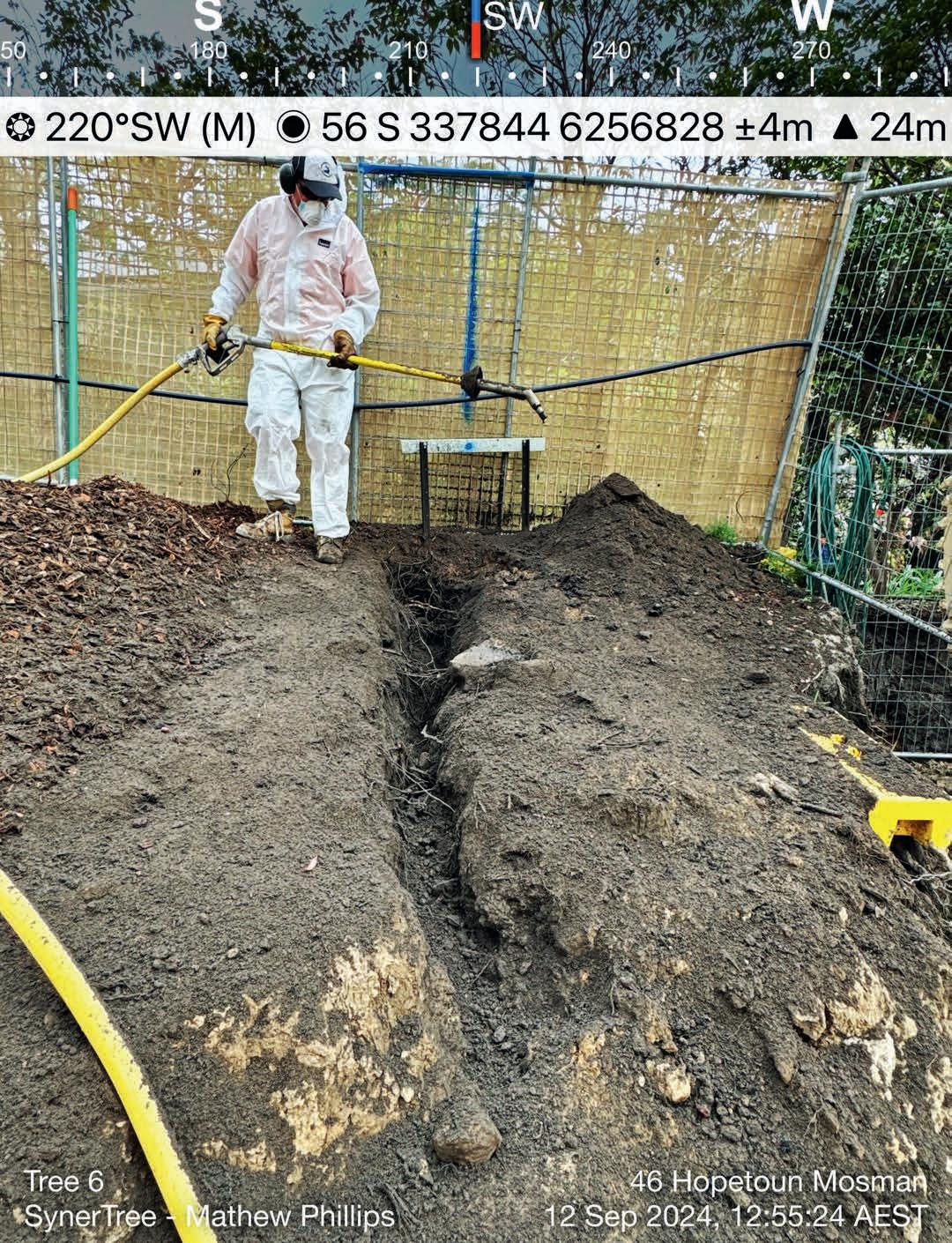
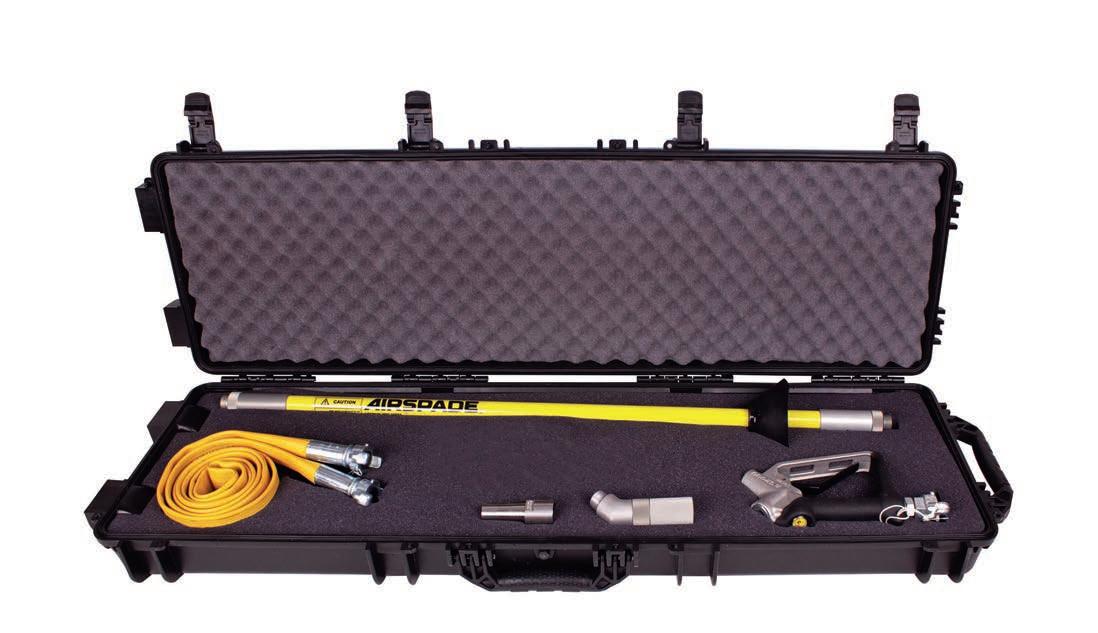
AirSpade 2000 – uncover underground objects without harm using compressed air.
Image: Knight Pneumatic
option, and whether or not it might destabilise the tree.
“We can move right back to the structural root zone and start to root map appropriately.
“Once we’re at the structural root zone we can trace the roots out. If there’s good radial root growth it’s easy to show council or the consent authority the proposed cut location works and is feasible.
“Sometimes we’ll find a lot of roots, and we’ll have to come up with alternatives for the developer.”
Mathew and Synertree clearly do represent the trees, and the company’s insistence in putting the trees’ health and wellbeing first and foremost is proving a sound financial strategy as well.
“I’m an associate member of the Institute of Australian Consulting Arboriculturists (IACA),” Mathew said, “and in the consulting world, within the top level of arborists at the forefront of new technology, everyone knows about AirSpade. A lot of people are recognising it’s the way to go and they recommend it in their reports for development applications.”
So there it is. When the situation requires ‘non-destructive’, AirSpade is the answer. To learn more of AirSpade and Airvac, log on to industrysearch.com.au/knight-pneumatics/s/7186.
Digging
AIR-SPADES® are in use in arboriculture, utility, construction, and industrial applications worldwide. AIR-SPADE is the tool of choice due to its fast, non-destructive method of excavation.
Flows from 25cfm to 330cfm.
• Ideal for Bare Rooting
• Radial Trenching
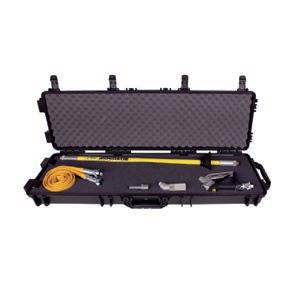
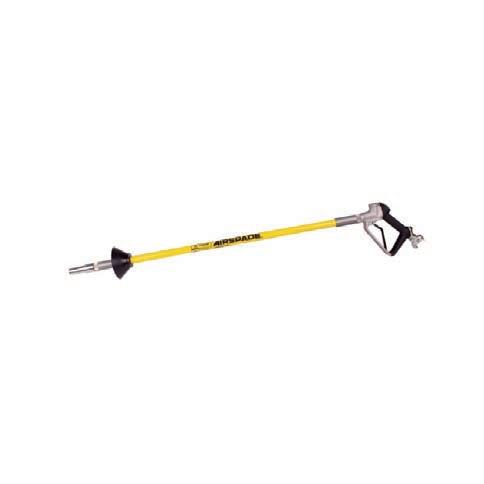
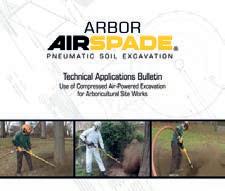
AirSpade 2000 Series



#1


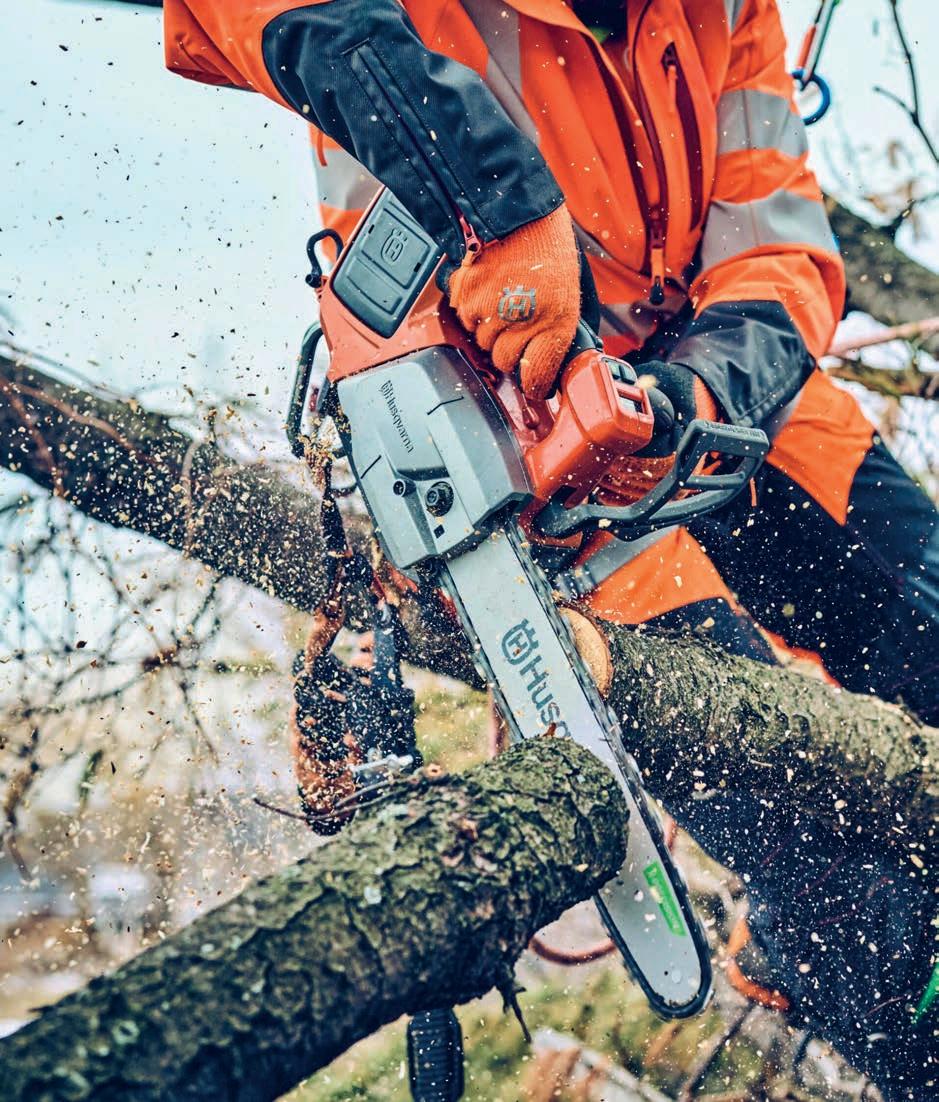



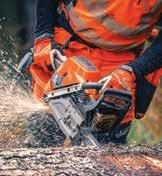


Subscribe and enter the draw to win:

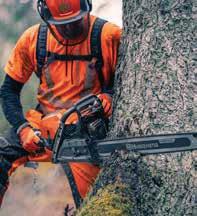





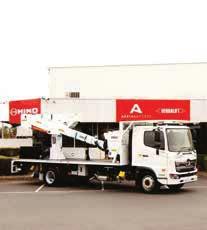
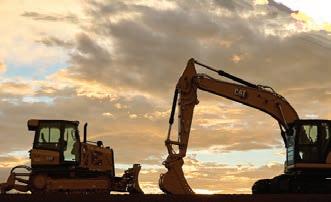
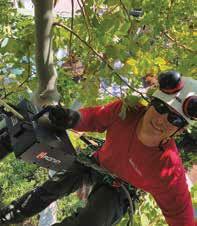





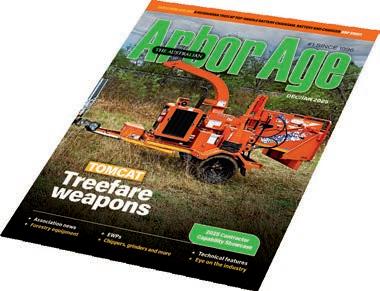


Apower and performance of the T542i XP® and 542i XP® chainsaws.
s the first battery-powered chainsaws to incorporate a clutch, the T542i XP® (top-handled) and 542i XP® (rear-handled) models deliver a balance of power, performance, and convenience, offering professionals a reliable alternative to petrol chainsaws without sacrificing efficiency.
The T542i XP® and 542i XP® build on the strengths of previous models while introducing key advancements. Designed for both in-tree and on-ground applications, they feature improved manoeuvrability, balance, and a refined power-to-weight ratio. The centrifugal clutch enhances energy transfer, providing a familiar cutting experience similar to petrol saws.
With performance comparable to 40cc petrol chainsaws, these models deliver precise throttle response and consistent power under load, making them an ideal choice for professionals transitioning to battery power.
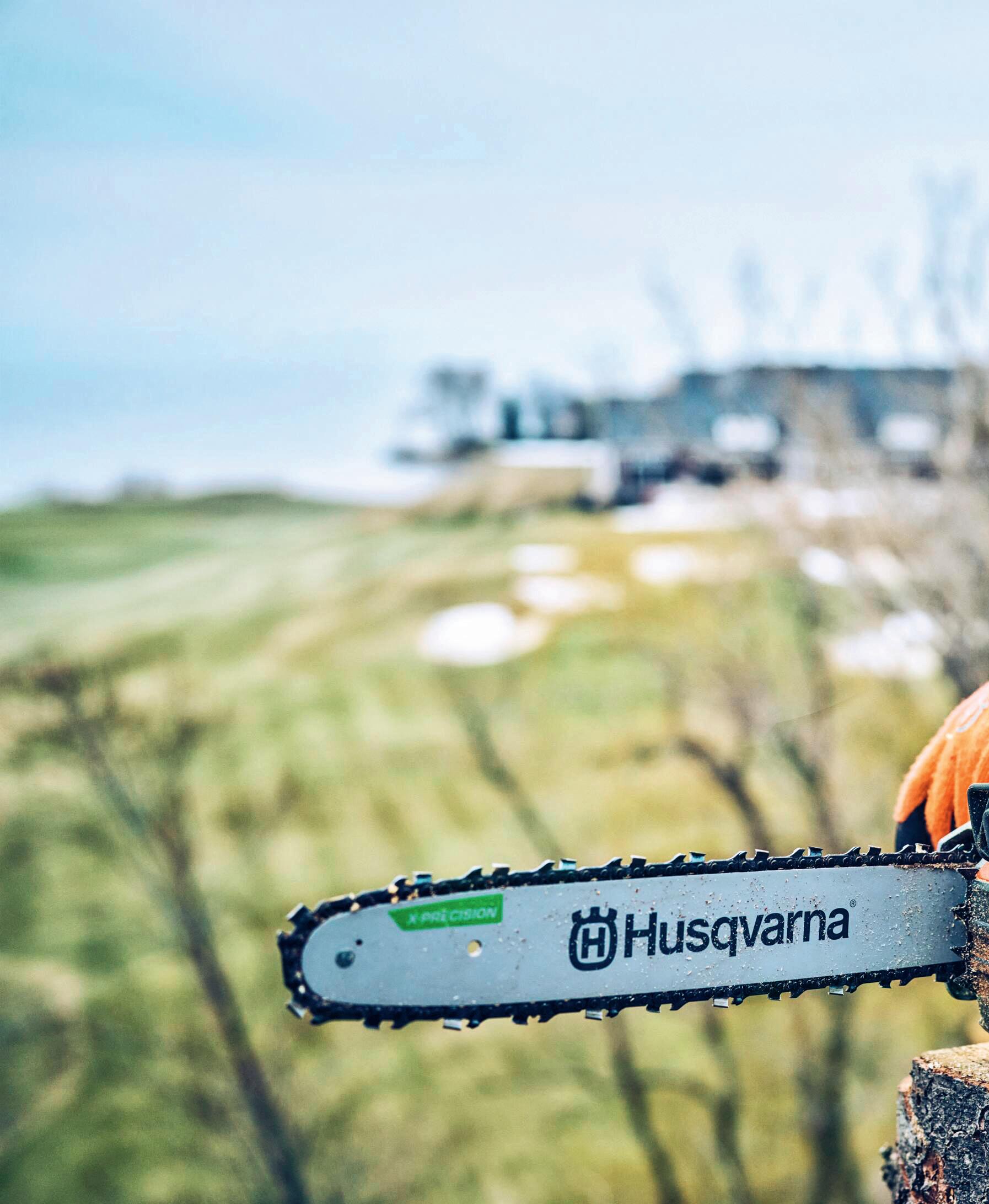
The T542i XP® (top-handled) and 542i XP® (rear-handled) models offer professionals a reliable alternative to petrol chainsaws without sacrificing efficiency. Images: Husqvarna
The Husqvarna T542i XP® and 542i XP® are equipped with cutting-edge features designed to maximise efficiency and ease of use, including:
• Centrifugal clutch: enhances energy transfer for smoother cutting performance
• Increased torque and power at lower RPM: boosts cutting capacity by approximately 10%
• Updated magnesium sprocket cover: facilitates quick debris removal
• Adjustable oil pump: allows for customised oil-flow control
• Rim sprocket: simplifies chain replacement and maintenance
• Digital oil sensor: provides real-time alerts for oil refills and flow issues
• IPX4 weatherproof rating: ensures durability in challenging conditions, and
• Snug-Fit guide-bar cover: Enhances protection and ease of handling.
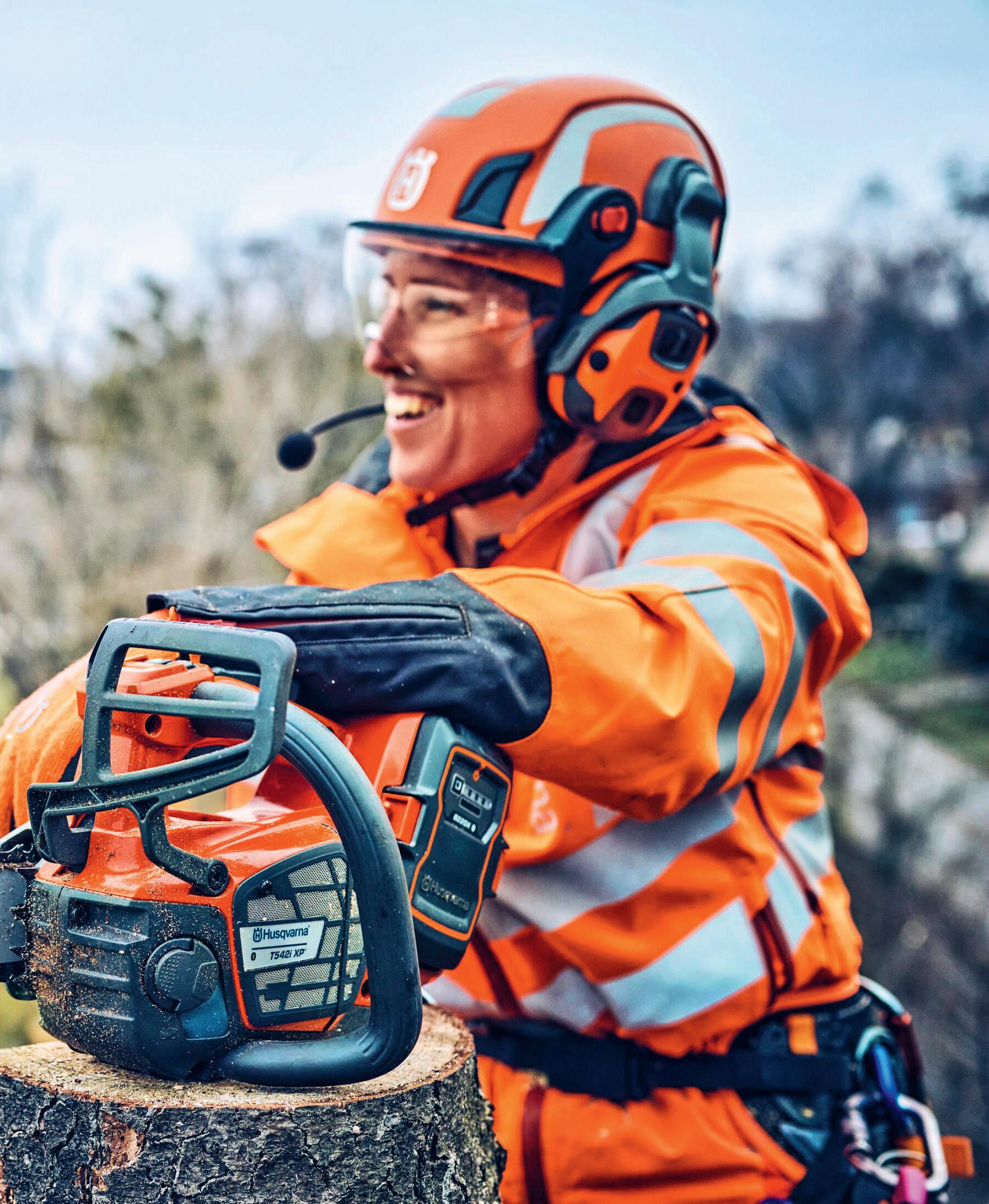

New Zealand arborist Scott Forrest praised the T542i XP®, stating, “Finally! I’ve found a battery saw that can keep up with my production.”
These models support the Husqvarna X-CUT® SP21G .3254" and SP33G chains, designed in-house for superior sharpness and efficiency. The semi-chisel cutters maintain edge retention, while the narrow kerf improves cutting precision.
The future of battery-powered chainsaws
For those looking to upgrade, the T542i XP® is optimised for takedowns and high-demand tasks, while the 542i XP® provides versatility for groundlevel work. By combining traditional cutting power with modern battery convenience, these chainsaws set a new standard for professional performance.
The Husqvarna T542i XP® and 542i XP® are available in Australia. Visit a local Husqvarna dealer or husqvarna.com.au for more details. Article supported by Kiah Martin, Husqvarna H-Team Ambassador and professional arborist at TreeStyle Pty Ltd.
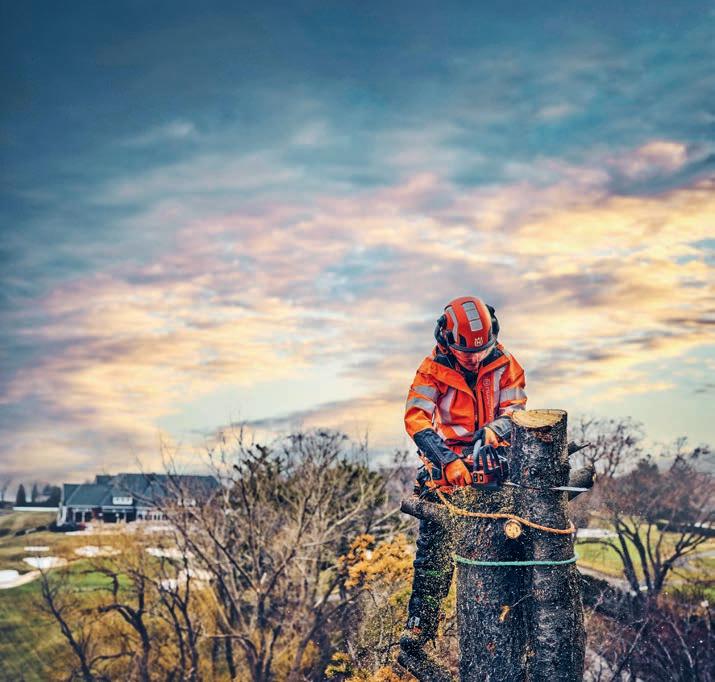
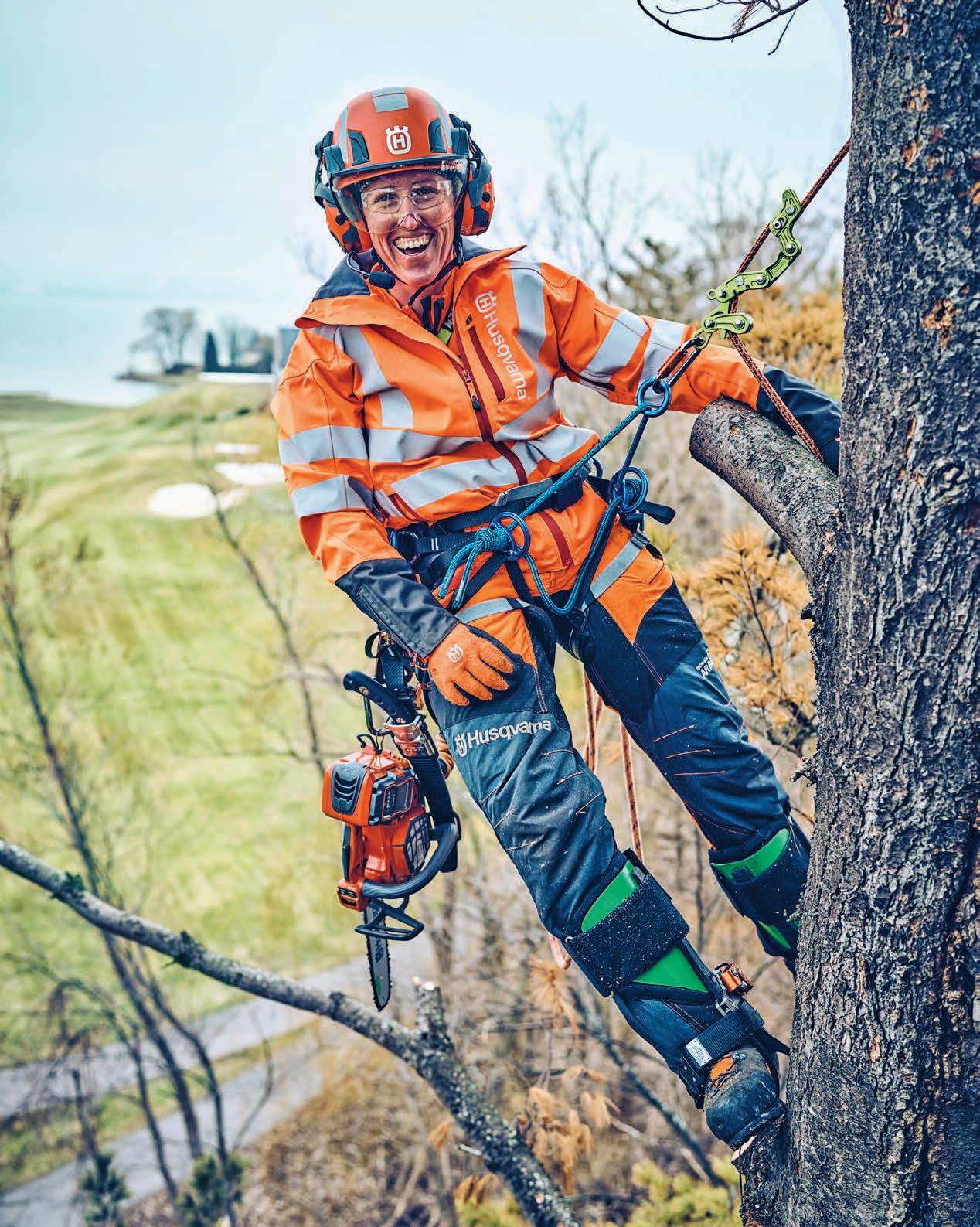
Setting a new standard for professional performance.

Arborists need machinery that can navigate through tight areas, manoeuvre with finesse, and deliver exceptional performance without compromise. Brandt’s range of John Deere compact construction machines addresses these needs comprehensively, offering a range of benefits that make them ideal for arborists worldwide.
John Deere’s compact machines are engineered to excel in confined spaces, a common challenge for any work in urban environments or densely vegetated areas, but especially for arborists. With a compact footprint and excellent agility, the John Deere’s can access and operate in areas larger equipment simply can’t, allowing arborists to work with precision and efficiency.
Moreover, the reliability and durability synonymous with the John Deere brand ensure arborists can depend on these machines day in and day out, even in the
most demanding conditions. Whether it’s moving logs, removing tree stumps, or transporting heavy loads of debris, John Deere’s compact machines deliver consistent performance, minimising downtime, and maximising productivity.
In addition to exceptional performance, John Deere compact construction machines prioritise operator comfort and safety—a crucial aspect of any arborist’s work environment. With ergonomically designed cabins, intuitive controls and advanced safety features –such as rearview cameras and proximity sensors – these machines prioritise the well-being of operators, allowing them to focus on the task at hand without unnecessary distractions or discomfort.
The versatility of the machines is unparalleled, offering a range of attachments and accessories that can be easily swapped out to suit specific tasks. Whether it’s an Engcon Tiltrotator and a
Brandt’s John Deere compact construction machines underscore a commitment to innovation and customer-focussed solutions. Images: Brandt
hydraulic grab for precisely placing logs, a compact mulching head for efficient land clearing, a hydraulic hedge trimmer for safer, faster pruning, or a set of buckets for general digging and clean up, arborists can customise equipment to meet the unique demands of each job, enhancing efficiency and versatility on the field.
Beyond the tangible benefits, Brandt’s offering of John Deere compact construction machines underscores a commitment to innovation and customer-focussed solutions. By actively engaging with arborists and understanding their evolving needs, Brandt has succeeded in delivering a product that not only meets, but exceeds, expectations, empowering arborists to elevate their craft and achieve unparalleled results.
Brandt’s offer of John Deere compact construction machines tailored for arborists represents a fusion of
cutting-edge technology, unrivalled performance, and unwavering commitment to customer satisfaction. For arborists seeking equipment that combines precision, reliability, and versatility, the choice is clear: Brandt’s John Deere compact construction machines are a superior choice, revolutionising the way arborists approach their craft and shaping the future of arboriculture.
Contact the team today on 1800 237 887 or visit Brandt.ca/au.

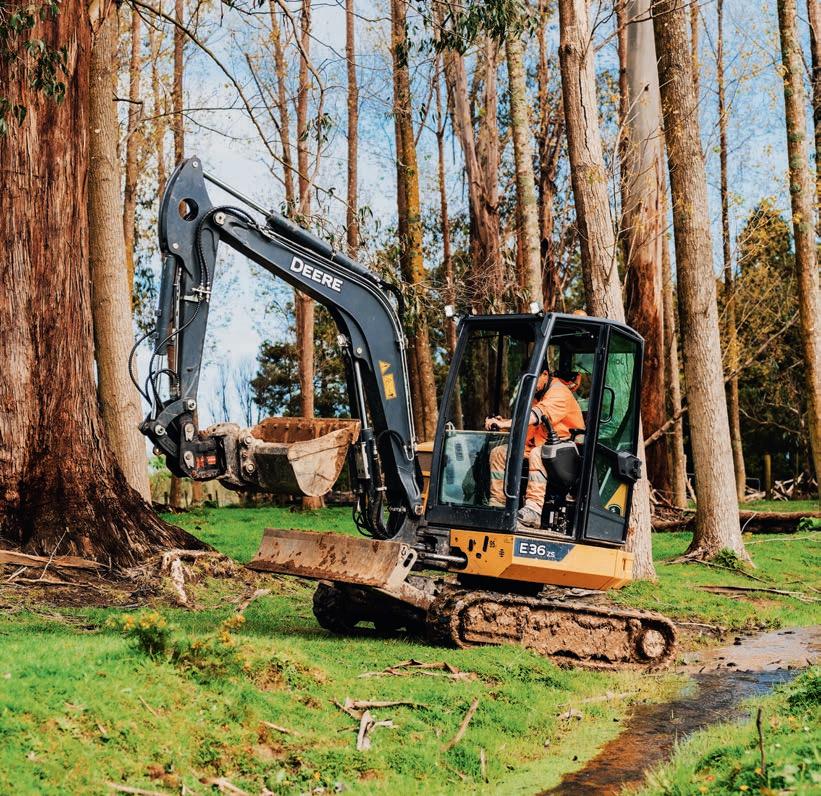
of
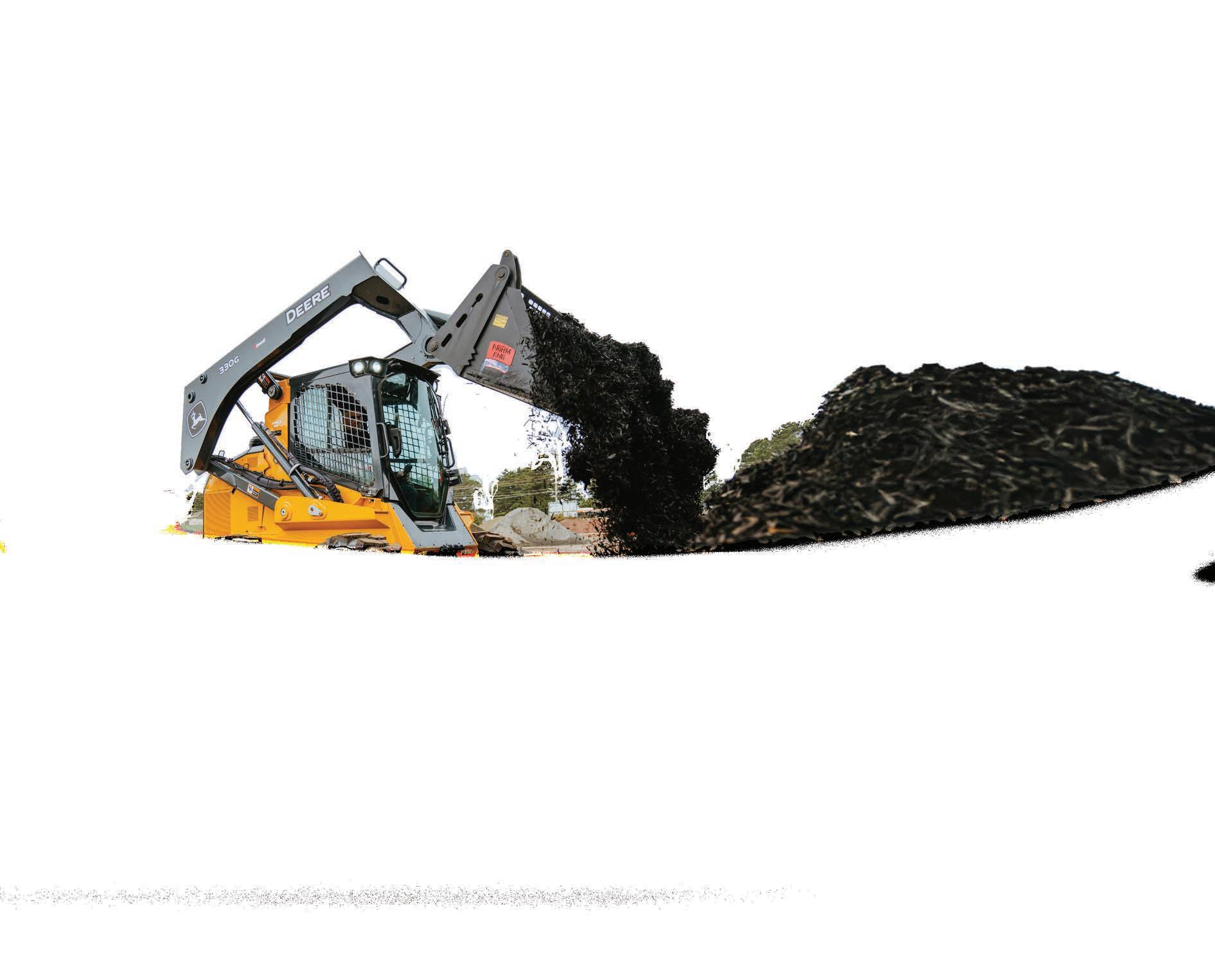

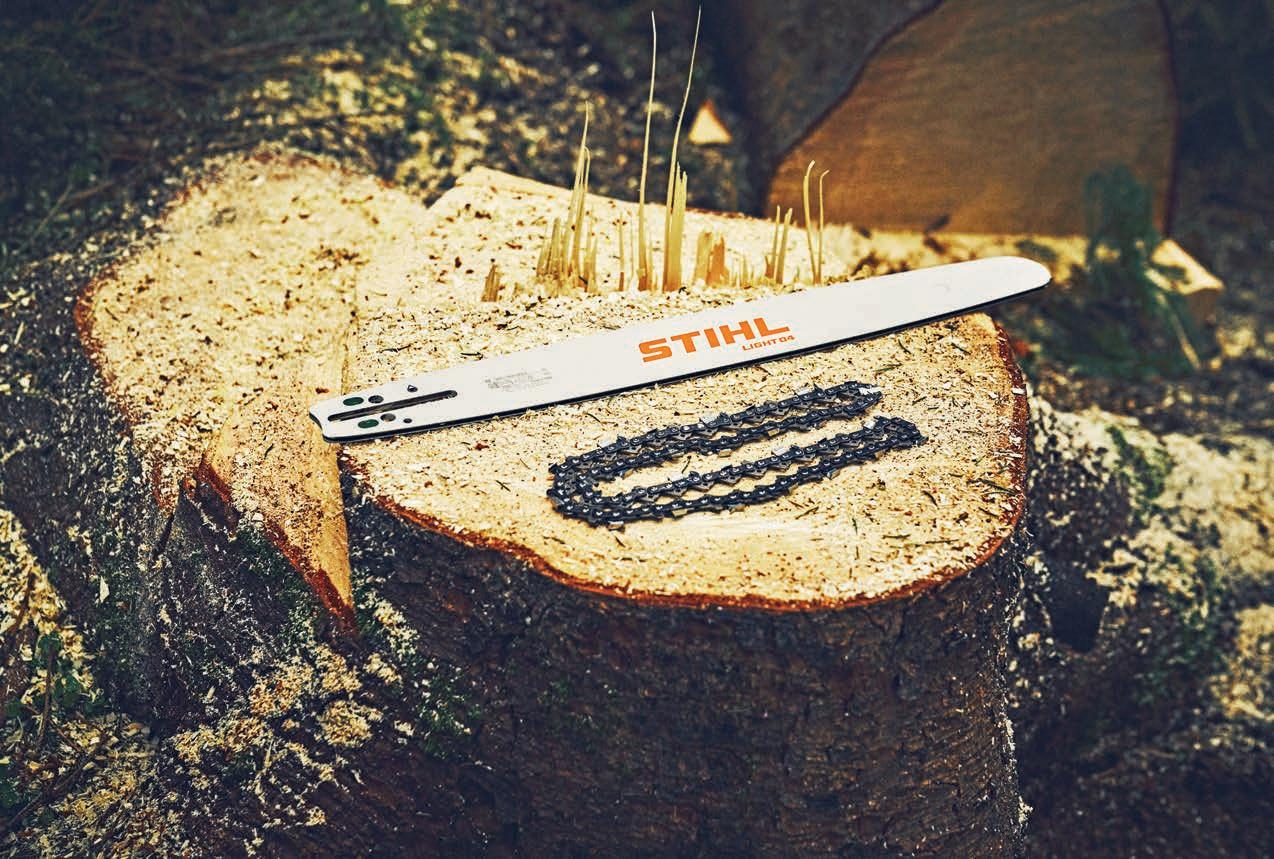
When it comes to chainsaws, STIHL stands out as a leader in innovation and quality.
What sets STIHL apart from the competition is its unique approach to manufacturing.
Unlike other brands, STIHL is the only manufacturer that develops, manufactures, and produces the chainsaw, chain, and guide bar, creating a synchronised system for optimal performance.
This article delves into the meticulous processes behind STIHL’s saw chains and guide bars, highlighting what makes them one of the best in the industry.
STIHL’s commitment to excellence begins with its saw chains. Each chain undergoes a rigorous manufacturing process to ensure it meets the highest standards of performance and durability, and the attention to detail and quality control at every stage of production is what makes STIHL saw chains superior.
How is STIHL saw chain made?
The process starts with high-quality raw material rolled into a coil, from which individual saw-chain components are stamped out. This raw material is specifically chosen for its strength and durability, ensuring the final product
can withstand the rigours of heavy use. The selection of raw material is a critical step, as it lays the foundation for the entire manufacturing process.
These components then undergo vibratory grinding, a process that rounds off and removes any burrs, reducing friction during use. This step is crucial
Individual saw-chain components are stamped out.

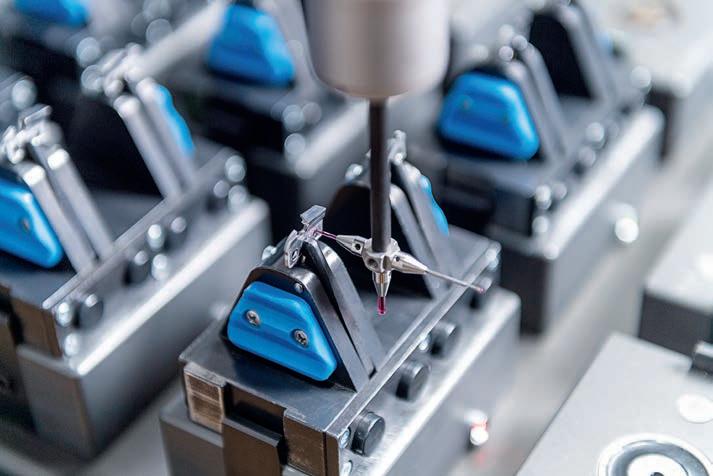
for ensuring smooth operation and longevity of the chain. By eliminating any rough edges, STIHL ensures the chain moves seamlessly over the guide bar, reducing wear and tear on both the chain and the bar.
The components are hardened by heating them to nearly 1000°C and then quenching them in a salt bath. This unique process creates tough and durable components capable of withstanding the most demanding applications. The hardening process not only increases the strength of the chain but also enhances its resistance to wear and impact, making it ideal for cutting
through tough materials.
After each step, stringent quality control checks are performed to ensure only the best chains are used on STIHL chainsaws and sold to customers. These checks include visual inspections, dimensional measurements, and performance tests. By maintaining high standards of quality control, STIHL ensures every chain meets its rigorous specifications and delivers consistent performance.
All STIHL saw chains are produced at the STIHL plants in Wil and Bronschhofen, Switzerland.
These state-of-the-art facilities are equipped with the latest technology and staffed by highly skilled technicians dedicated to producing the best saw chains in the world.
STIHL manufactures chains for a variety of users, including homeowners, professionals, wood-processing plants, and rescue services, ensuring an ideal solution for any wood-cutting application. Whether you’re cutting firewood, felling trees, or performing rescue operations, STIHL has a chain that meets your needs.

Find out more here:
Just like its saw chains, STIHL’s guide bars are designed to complement its chainsaws. They provide lightweight execution and the rigidity needed to handle any demanding application. The combination of STIHL chains and guide bars creates a harmonious system that delivers exceptional performance and reliability.
1. STIHL guide bars are manufactured in Germany, just metres away from the R&D team, allowing for close and constant monitoring of production
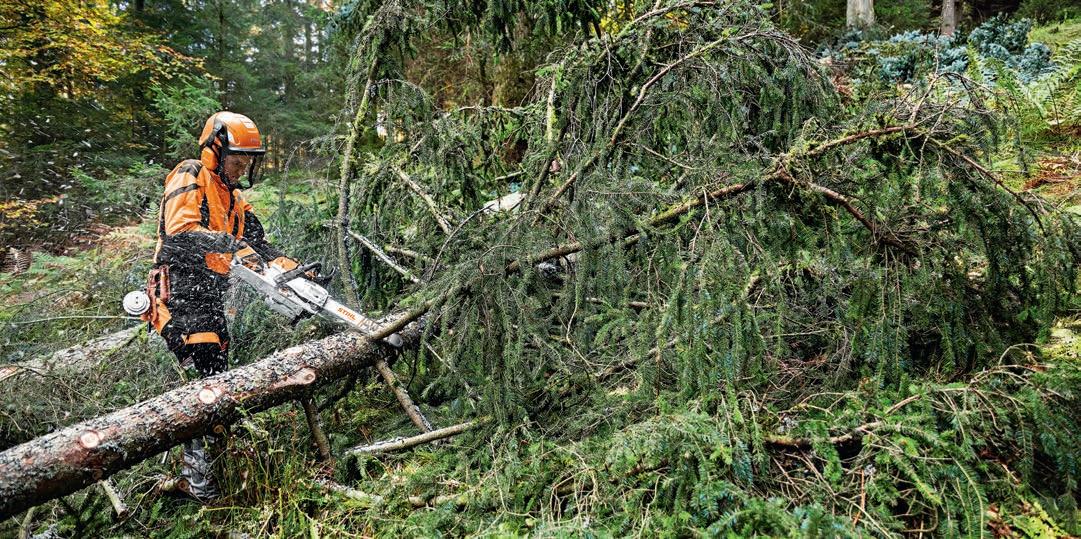
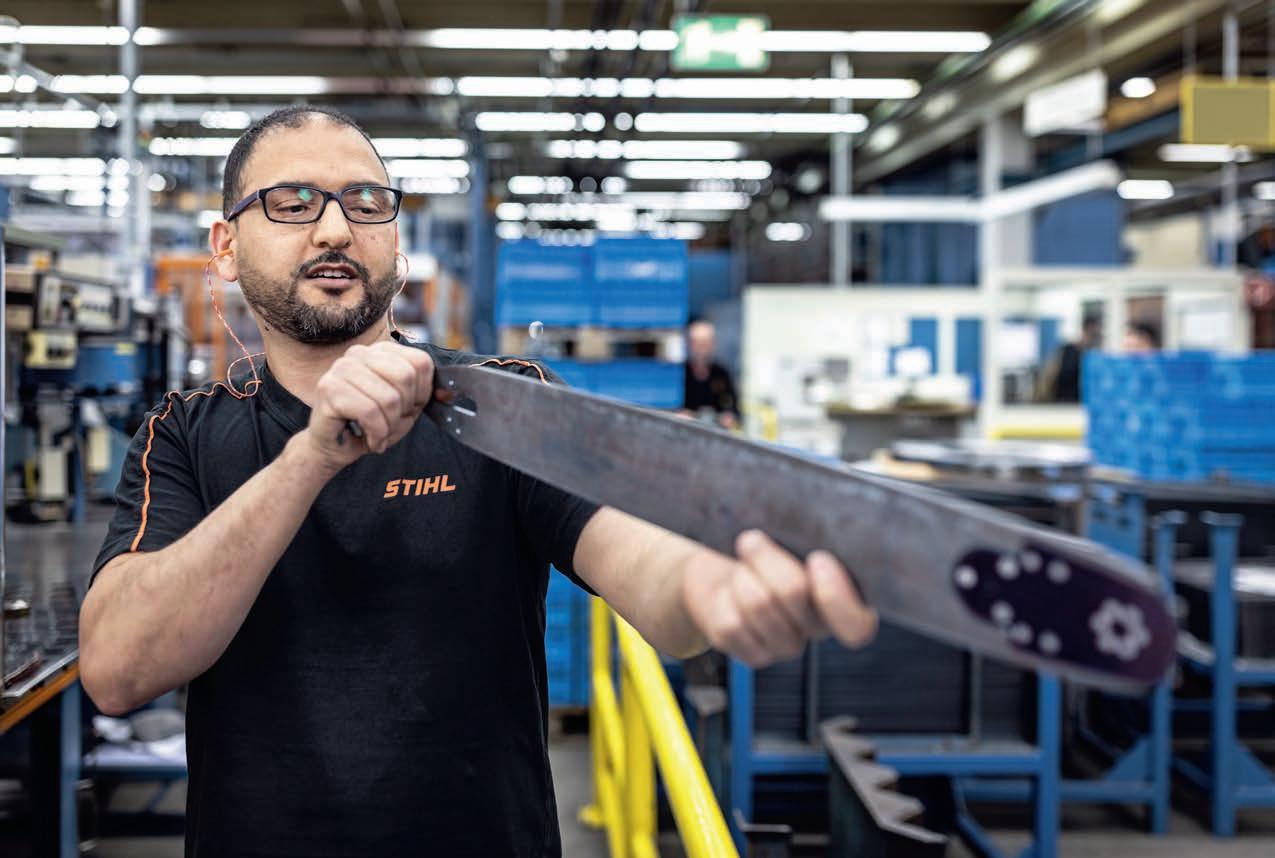
to ensure quality. This proximity facilitates rapid communication and collaboration between the design and production teams, ensuring any issues are quickly identified and resolved.
2. New guide-bar designs are created using CAD software and undergo intensive internal prototype testing, including exclusive bend tests based on real-world user feedback. These tests simulate the stresses and strains the guide bars will experience in actual use, ensuring they can withstand the toughest conditions. The design process also includes simulations of various cutting scenarios to optimise the performance of the guide bars.
3. After internal tests, guide bars are sent worldwide for further testing and feedback. This global testing phase ensures the guide bars perform well in different environments and under various conditions. Feedback from users around the world is invaluable in refining the design and improving the performance of the guide bars.
4. All new guide bars undergo rigorous kickback testing to ensure they meet global safety standards while maintaining structural rigidity and
durability. Kickback is a common hazard when using chainsaws, and STIHL’s commitment to safety ensures its guide bars minimise this risk. The kickback tests involve simulating various cutting scenarios to evaluate the guide bar’s performance and safety features.
5. During production, each bar is inspected multiple times and finally visually inspected by experts to ensure it’s suitable for use with STIHL chainsaws. These inspections include checking for dimensional accuracy, surface finish, and overall quality. By conducting multiple inspections, STIHL ensures only the best guide bars make it to the market.
When combined with STIHL saw chains, the harmonious combination of the powerhead, saw chain, and guide bar ensures the cutting attachment and powerhead are ideally coordinated, delivering the best possible performance. This synergy between the components results in smoother operation, reduced vibration, and increased cutting efficiency.
STIHL offers a variety of bars with
Each bar is inspected multiple times and finally visually inspected by experts.
different tips and features to suit any chainsaw application, from generalpurpose cutting to specialised tasks like carving and milling.

STIHL’s dedication to quality and innovation is evident in every aspect of its chainsaw bars and chains. By controlling the entire manufacturing process, from raw material selection to final inspection, STIHL ensures its products meet the highest standards of performance and durability. Whether you’re a homeowner, a professional, or part of a rescue team, STIHL chainsaw bars and chains provide the reliability and efficiency you need to get the job done. With STIHL, you can trust you’re using the best tools available, designed to deliver exceptional results every time.
To see more STIHL equipment, log on to stihl.com.au/en. Find out more here:
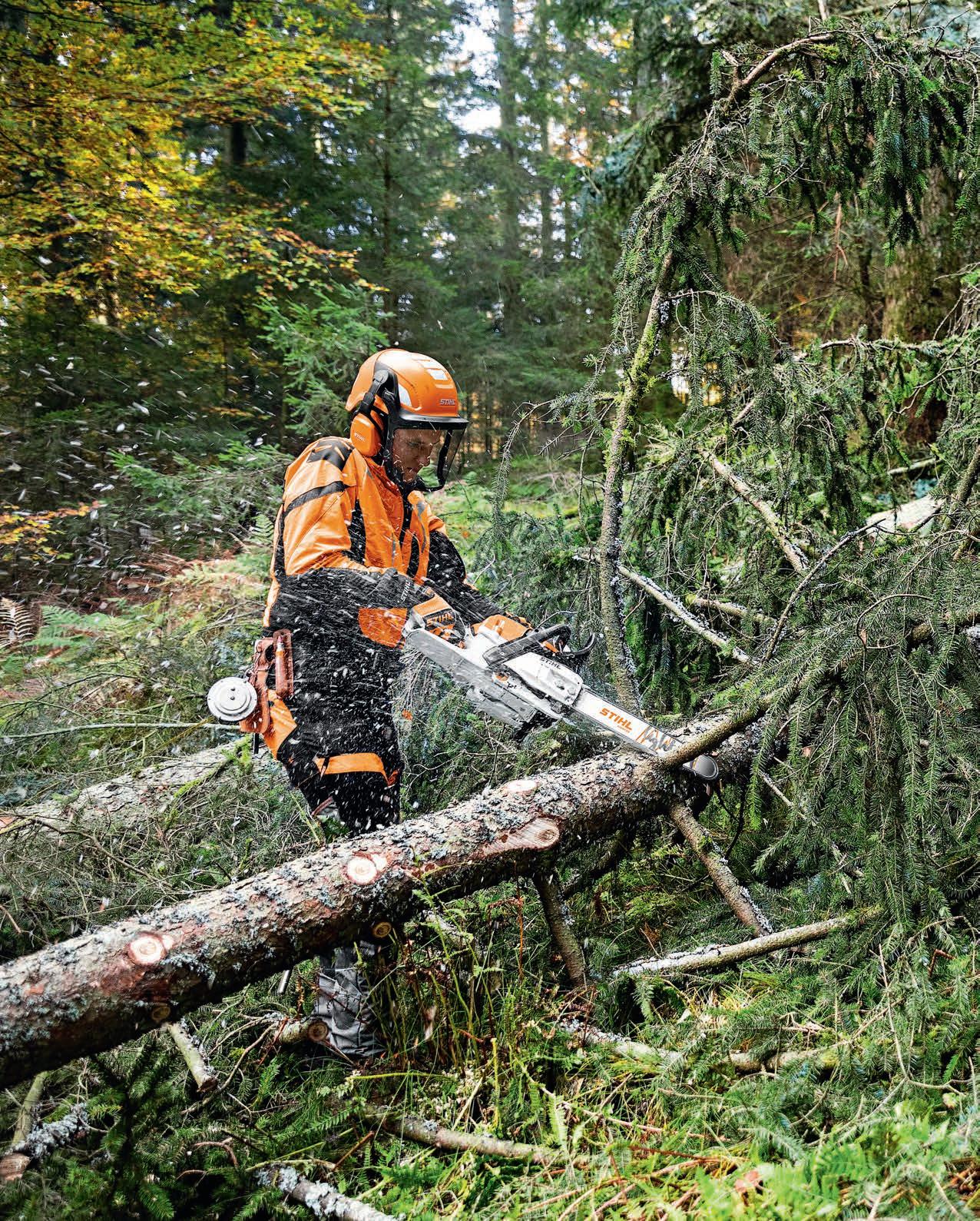
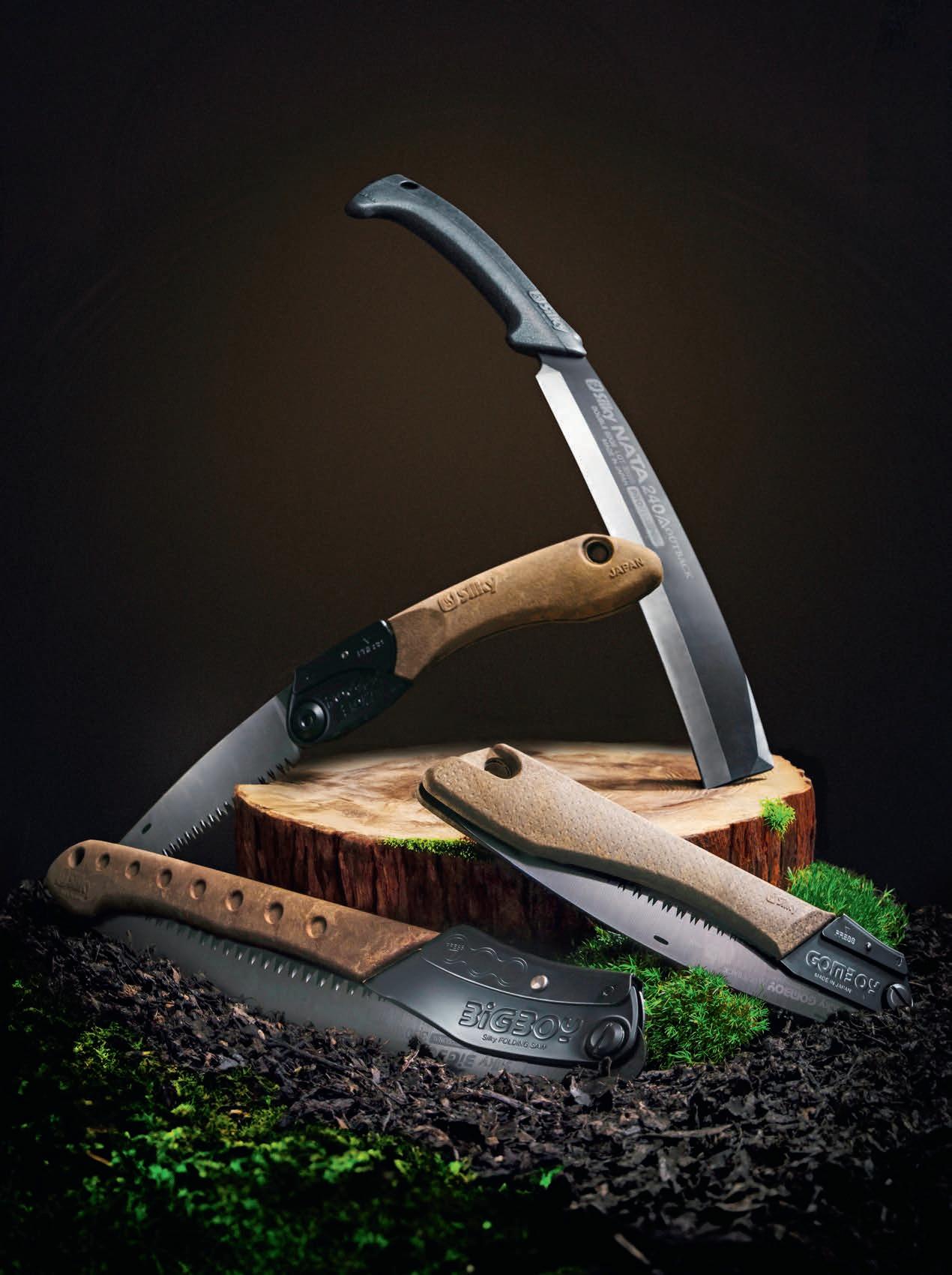
F
or gardeners and arborists, the right tools can mean the difference between a job well done and a battle lost to nature’s most formidable foes. Enter Bionic Rose Gauntlets and Silky Saws – two powerhouses in the world of gardening and arboriculture turning sceptics into die-hard fans.
Throwing down the gauntlet
Julian, a passionate gardener in regional Victoria, recently shared his glowing experience with the Bionic Rose Gauntlets.
Wrestling with a dozen or so “very large, old, and tenacious bush roses” had previously meant a steady stream of battle wounds – so much so that he and his family had taken to calling them ‘The Vampires’ for their uncanny ability to draw blood. But after putting the Bionic Gauntlets to the test, Julian declared: “The roses’ blood-drinking days just came to an end!”
Made with advanced protective materials, these gauntlets provide dexterity and breathability while standing up to even the most vicious thorns. It’s no wonder arborists, gardeners, and landscapers alike swear by them for keeping hands and arms safe while tackling everything from roses to brambles. The combination of comfort and durability means professionals and hobbyists alike can work for longer without discomfort, allowing them to focus on the task at hand rather than worrying about potential injuries.
Silky Saws: a tool-nerd’s dream
Julian’s enthusiasm didn’t stop with gloves.
After exploring the Australian Tool range he found himself utterly smitten by Silky Saws, calling them “wickedly efficient”, and comparing them to precision-crafted art.
A longtime fan of great design and master craftsmanship, he recognised what sets Silky apart: a legacy of over a century of Japanese excellence, founded by Kaysuji Miyawaki, and still run as a family business today.
Silky Saws are not just cutting tools; they’re a testament to Japan’s dedication to superior engineering. Their razor-
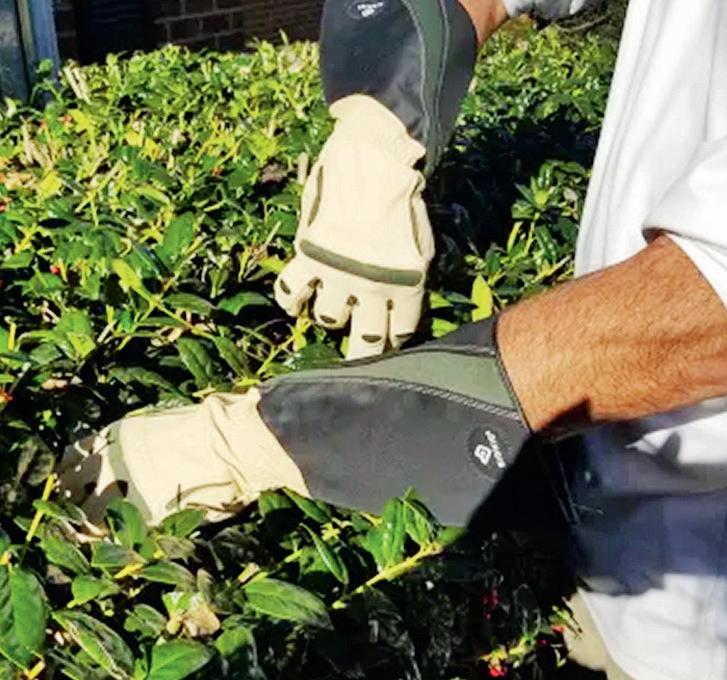
The comfort and durability means working for longer without discomfort “ ”
sharp teeth, unique blade geometry and ergonomic handles make them an indispensable addition to any arborist’s or gardener’s toolkit. From professional tree surgeons to backyard enthusiasts, these saws are renowned for their ability to make clean, precise cuts with minimal effort, reducing strain and fatigue over long hours of use.
Beyond their efficiency, Silky Saws offer a range of options suited to different tasks. Whether tackling dense undergrowth, pruning delicate branches, or felling small trees, there’s
a Silky Saw designed for the job. Their blend of tradition and innovation ensures users are not just wielding a saw, but an expertly crafted piece of engineering designed to last for years.
As for Julian? With the mighty Bionics now in his arsenal, even the most stubborn blackberry in his yard is in for a very rude surprise. And he’s not alone –gardeners and arborists across Australia are discovering just how transformative the right tools can be.
So the next time you pick up your tools, take a moment to appreciate the hands that made them, the history behind them, and the passion they inspire. Because great tools don’t just get the job done – they tell a story worth sharing. In the case of Bionic Guantlets and Silky Saws, they also make the job a whole lot faster, easier and more enjoyable.
See more of Silky Saws and Bionic Gauntlets at atcproducts.com.au.
A new Log Haulage Industry Code of Practice (LHC) provides guidance for businesses involved at every level of the forest-log haulage task.

TThe new Code of Practice provides guidance for businesses involved at every level of the forest-log haulage task. Image: Michael Evans/stock.adobe.com
he National Heavy Vehicle Regulator (NHVR) has published a new draft Code of Practice to assist industry to improve safety outcomes in the transport of logs from forest to mill or port.
The new Log Haulage Industry Code of Practice (LHC) provides guidance for businesses involved at every level of the forest-log haulage task.
Acting Chief Safety and Productivity Officer Paul Sariban said the draft LHC was developed in collaboration with the Australian
Forest Products Association and the Australian Forest Contractor’s Association, along with industry representatives and stakeholders who contributed their resources, experience and expertise.
“The LHC is a practical guide of interest to anybody who conducts business in the forestry sector. It supports parties in the Chain of Responsibility to understand and meet their primary duty and other obligations under the Heavy Vehicle National Law (HVNL),” Mr Sariban said.
“Consulting with industry associations and stakeholders in the creation of the new Log Haulage Industry Code of Practice was key in allowing us to properly understand how the industry’s operations are conducted, identify any hazards and document or develop effective control measures to eliminate the risks they may cause.”
The new Code will be available for public feedback.
All feedback received from any stakeholder within the logging sector will be considered by the NHVR as part of the assessment process to determine whether the Code is suitable for registration.
Mr Sariban said the new LHC was relevant to anyone who, or whose business:
• Owns a forestry area where logs are harvested
• Harvests or stockpiles logs for transport
• Loads, operates or contracts heavy vehicles to transport logs, or
• Manages a facility, such as a mill, where logs are delivered.
“The code also assists businesses to assess training needs for drivers and other workers,” continued Sariban. “Like all heavy-vehicle drivers, drivers of log-haulage vehicles must comply with numerous obligations under the HVNL, including loading requirements, mass and dimension requirements, and fatigue management.
“Additionally, log-haulage drivers confront particular challenges operating off road or on primitive dirt roads, in all weather and with vehicles loaded near to their maximum capacity. High-quality ongoing training must be provided to ensure drivers are sufficiently skilled to carry out these operations safely and efficiently.”
However, Mr Sariban made the point that businesses cannot ‘pass the buck’ to drivers when things go wrong, but must have in place robust systems that ensure safety.
“The HVNL makes it clear the Primary Duty is shared by all the parties who have a role in the transport task, acknowledging the opportunities different parties have to eliminate or reduce risks to public safety from the use of heavy vehicles,” Mr Sariban said.
“For example, forestry managers can reduce driving hazards through road design, signage and traffic control, while loaders can improve vehicle stability by careful selection and placement of logs.”
Heavy vehicles and equipment used for hauling were also often exposed to rough and uneven ground, and to damage caused by the heavy equipment used for loading and unloading.
“The environments these heavy vehicles are subjected to can damage vehicle components, so the new LHC provides
in-depth guidance and control measures so all parties in the supply chain can work together to minimise damage to vehicles, and to identify and address vehicles and loads that may pose risks to public safety,” Mr Sariban said.
The LHC outlines the range of transport activities involved when logs are transported from the forest. It identifies some hazards and effective measures of control that can be implemented within each of those activities. Some of those measures relate to equipment or training or procedures, but in preparing the LHC, it became apparent that many of the hazards can only be effectively managed when businesses share information and cooperate.
“I would like to extend my thanks to the forestry and haulage industry members and other parties who have given their time to helping to improve the log haulage transport task for all road users,” Mr Sariban said.
“By collectively embracing a safety-first approach, we can protect lives and infrastructure and maintain a productive industry.”
Feedback should be provided using the feedback form on the Log Haulage Code Consultation page and submitted to codes@nhvr.gov.au. Industry can access the draft Log Haulage Industry Code of Practice at nhvr.gov.au.



WorldSkills Australia is thrilled to announce Prime Creative Media – publisher of The Australian Arbor Age – as its official media partner in a collaboration set to amplify the visibility and impact of skills excellence nationwide.

The partnership will play a pivotal role in promoting the talent, dedication, and achievements of competitors, trainers, and industry leaders involved in WorldSkills Australia’s competitions and initiatives.
Prime Creative Media is Australia’s largest B2B publisher, specialising in integrated marketing communications in high-growth industries. It provides industry-leading, multi-channel communication platforms and connects clients with key decision makers across various sectors.
Prime Creative Media’s brands include, but are not limited to, National Collision Repairer, Australian Car Mechanic, Landscape Contractor magazine, Manufacturers’ Monthly magazine, Trailer magazine, The Tradie magazine, Australian Mining, Earthmovers & Equipment Magazine, Food & Beverage magazine, and BeanScene magazine.
Driving awareness
With the 2025 WorldSkills Australia National Championships and Skills Show set to take place at the Brisbane
Convention & Exhibition Centre, the partnership will ensure comprehensive media coverage of the event. Prime Creative Media will leverage its platforms to showcase competitor journeys, training excellence, and the broader impact of WorldSkills Australia on industries and communities nationwide.
“We are thrilled to partner with Prime Creative Media, whose expertise in industry-focused storytelling will help us inspire the next generation of skilled professionals,” said WorldSkills Australia CEO, Trevor Schwenk.
“This collaboration will signify the importance of vocational training and its role in driving Australia’s future workforce.”
Prime Creative Media Chief Operating Officer, Christine Clancy, stated: “We are excited about the synergies this partnership offers between Prime Creative Media, Australia’s largest B2B publishing company, and the country’s leading trade skills competition, WorldSkills.”
“Prime Creative Media is committed to the growth of the industries it serves,
and WorldSkills is an organisation that demonstrates some of the best future trade skills vital to those industries’ growth.”
“WorldSkills organises a range of exciting events at state, national and right up to the international skills competition, to be held in Shanghai in 2026.”
“These events showcase trade skills at their best.”
“We look forward to telling the stories of these young competitors, whose passion and dedication to their craft and honing their skills are great role models for future careers in those industries.”
With Prime Creative Media’s expertise in content creation and audience engagement, this partnership will amplify WorldSkills Australia’s message, ensuring skills excellence remains at the forefront of industry conversations.
To learn more of WorldSkills and to stay in touch with upcoming events, log on to worldskills.org.au.
The aim of the Australian Oak Open Days 2025 tour is to help conserve the oak species in Australia. Image: Royal Botanic Gardens Victoria
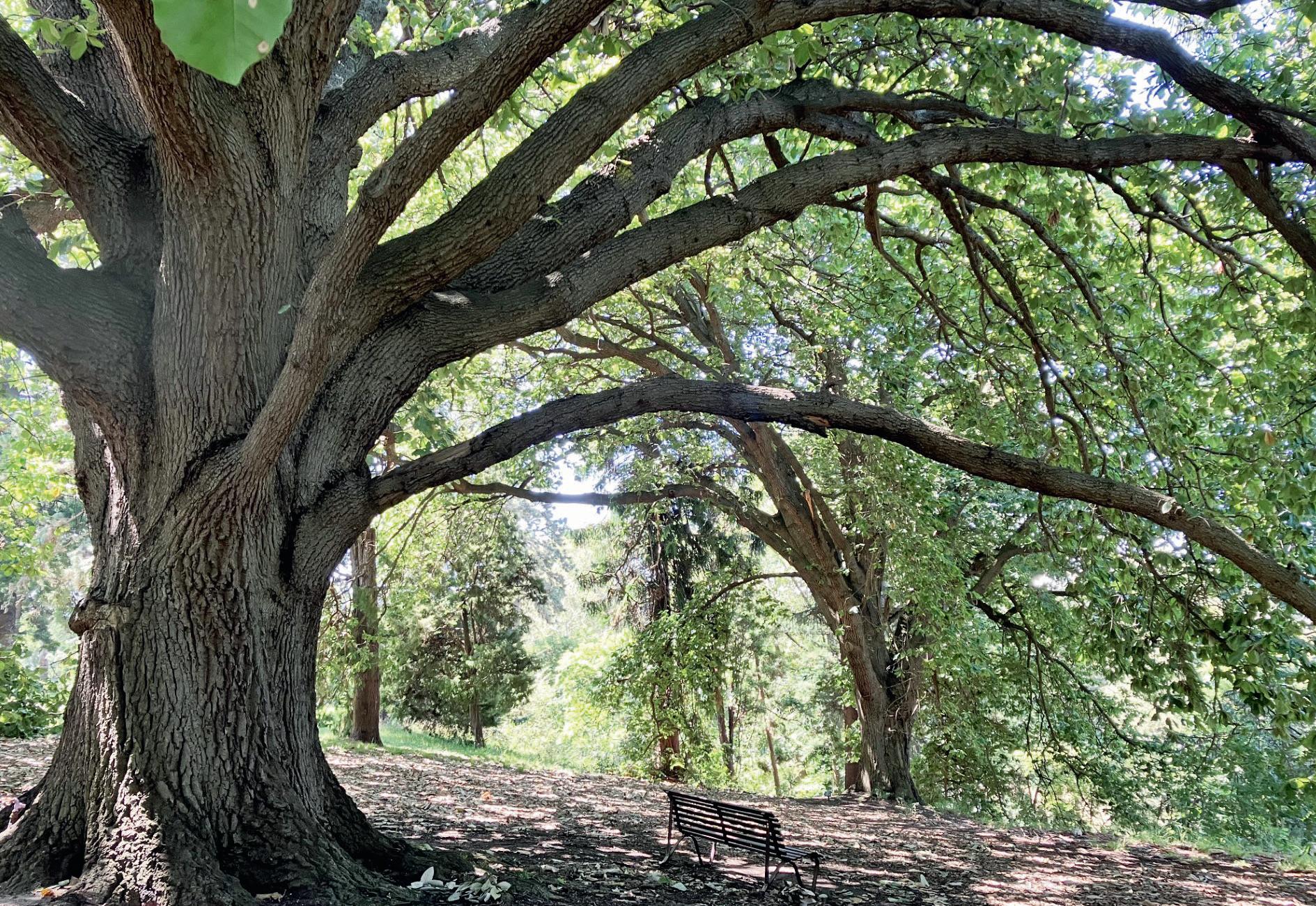
Itinerary Canberra
Day 1: Wednesday May 07
• 6pm Friends of ACT Trees dinner, OOD tour participants welcome
• Accommodation in Canberra
The International Oak Society (IOS) is hosting a tour, Australian Oak Open Days 2025 (OOD), of oak collections and oak-relevant sites in Victoria, ACT and Braidwood in May 2025.
The aim of the Australian Oak Open Days 2025 tour is to expand participants’ knowledge of oak collections in Australia, and connect oak enthusiasts with each other.
The ultimate aim is to help conserve the many common and rare oak species currently in Australia.
Participants will pay for their own accommodation and can attend as many or few days as they wish. Currently participants will organise their own transport, but this may change if enough people attend to enable bus transport. It’s anticipated numbers will be capped at around 20 to 25 people.
For more information log on to internationaloaksociety.org.
Day 2: Thursday May 08
• Explore Canberra’s oak trees:
• Westbourne Woods Royal Canberra Golf Course oak collection
• Cork Oak forest National Arboretum
• Canberra’s oak street trees
• Royal Military College Duntroon oaks and trees
• Mt Ainslie sunset
• Accommodation in Canberra
Day 3: Friday May 09
• Drive to Braidwood
• Meet in town for morning tea
• Oldest cork oak in country
• Peter Marshall’s truffle farm for walk and talk around oak plantation
• Demo deep ripping and planting techniques
• Lunch
• Truffle hunt (It may be too early for any quality, but we will find some and the dogs are fun)
• If time permits, a scenic drive to Araluen through the forest and back to…
• Accommodation in Canberra
Day 4: Saturday May 10
• 9:00 – 9:30am Speakers Chair, Museum of Australian Democracy
• Fly or drive to Melbourne
• Accommodation in Melbourne
Day 5: Sunday, May 11
• Drive to Dunkeld, visit Bill Funk oak collection.
• Accommodation In Hamilton
Day 6: Monday May 12
• Drive to Melbourne
• Possible stops on way to Melbourne: Mt Bainggug (Gariwerd National Park), Linton Avenue of Honour, Ballarat Botanic Gardens or Melton Botanic Gardens
• Afternoon tour of Melbourne Botanic Gardens oak collection
• Accommodation in Melbourne
Day 7: Tuesday May 13
• Visit Geoff Bogle oak collection and arboretum, Hoddles Creek.
• Possible visit to old growth Eucalyptus regnans, world’s tallest flowering plants.
• Return to Melbourne 2 hours
• Tour finish
• Accommodation in Melbourne
Thursday May 15
• New Zealand Oak Open Days 2025 starts near Napier.

A new study conducted in an urban recreational forest has shown climate change poses a particular risk to pine trees growing in dry areas.
Tree mortality has increased in the 21st century. This phenomenon is primarily driven by drought, heat waves, pests and forest fires, all of which have become more common with the increase in climate change.
Published in Urban Forestry and Urban Greening, a new University of Eastern Finland study explored the factors contributing to tree mortality in an urban recreational forest in Helsinki, colloquially known as the Helsinki Central Park.
Located in the boreal zone, the main tree species found in the Finnish urban forest included Norway spruce, Scots pine and silver birch.
The researchers used aerial image data spanning 16 years, from 2005 to 2021, to visually identify dead trees without the aid of artificial intelligence. They compared the observed tree deaths with data on tree species, soil types, temperature and rainfall conditions, along with drought-severity indices. The issue of tree mortality occurring
in the Helsinki Central Park is a timely one: “Recent years have seen an increase in tree mortality in this urban forest, and we felt it important to explore the underlying factors,” said University of Eastern Finland Doctoral Researcher Johanna Jääskeläinen, the lead author of the study.
The study also facilitates the assessment of future risks, as it shows pine trees growing in dry areas are at a particularly high risk of tree mortality.
“However, the results underestimate the risks climate change poses to spruce trees. Pines have deep taproots, and they remain standing dead longer than spruces, which makes them more visible in aerial images,” said Samuli Junttila, Associate Professor in Forest Health and Earth Observation at the University of Eastern Finland, a co-author of the study.
For spruces, the greatest future risk of mortality is posed by the European spruce bark beetle (Ips typographus), whose population sizes, reproductive
rates and generation numbers are rapidly growing in boreal, hemiboreal and temperate forests due to climate warming.
According to Junttila, the results are important for urban areas’ carbonneutrality goals. The findings can aid in planning and zoning, helping to protect good and climate-resilient growth sites.
Junttila notes, however, that this doesn’t mean trees growing at high-risk sites should be neglected. Regardless of the growth site, forests sequester carbon dioxide, thus mitigating climate change. Studies show urban forests cool the local climate and prevent the urban heat-island effect, protecting both people and trees in dry areas.
“It’s important to remember that maintaining canopy cover reduces tree mortality,” Junttila concluded.
For more information and to read the study, log on the University of Eastern Finland website: uef.fi/en.
Quantifyingthedriversoftree mortality:Acasestudyfromurban recreational boreal forest Johanna Jääskeläinen, Samuli Junttila, Hannah O’Sullivan, Yan Cheng, Stéphanie Horion, Mikko Vastaranta. Urban Forestry & Urban Greening. Volume 104, 2025,128672. ISSN 1618-8667.

Studies show urban forests cool the local climate and prevent the urban heat-island effect. Image nbixer/stock.adobe.com

The University of Eastern Finland, UEF, (Image Lev Karavanov/stock.adobe.com) is the most multidisciplinary university in Finland. The university’s high standard of interdisciplinary research and education responds to global challenges, building a sustainable future. Research conducted at UEF is ranked among the best in the world in several fields. The university is home to 17,000 students and 3200 staff.
THE SC48TX STUMP CUTTER – POWERFUL, FEATURE-RICH AND A COMPACT FOOTPRINT.
Engineered for contractors, this powerhouse is designed to efficiently grind stumps of any size. The overall width of 88.9cm and full function remote means you can tackle hard-to-reach stumps effortlessly. The robust 48hp (36kW) diesel engine means you’ll enjoy optimal fuel efficiency, durability, and peak performance. The innovative beltless direct-drive system maximises power transfer from the engine to the cutter wheel through a pair of gearboxes connected by a driveshaft. Plus, the beltless design means minimal maintenance costs, keeping your operations smooth and cost-effective. Reach out to your local tree care experts at Vermeer Australia today!





